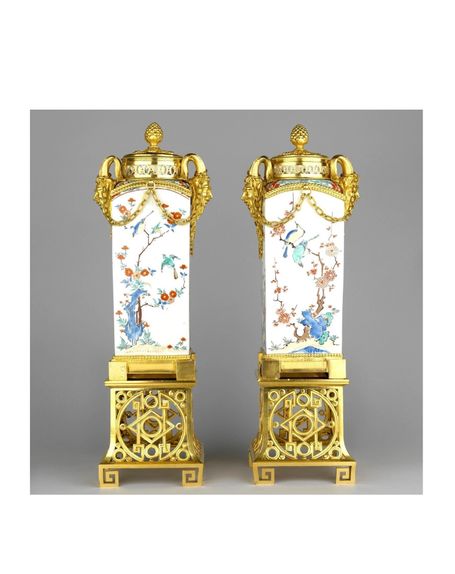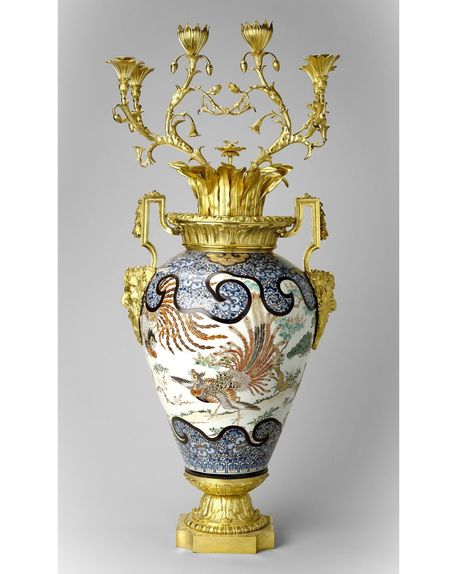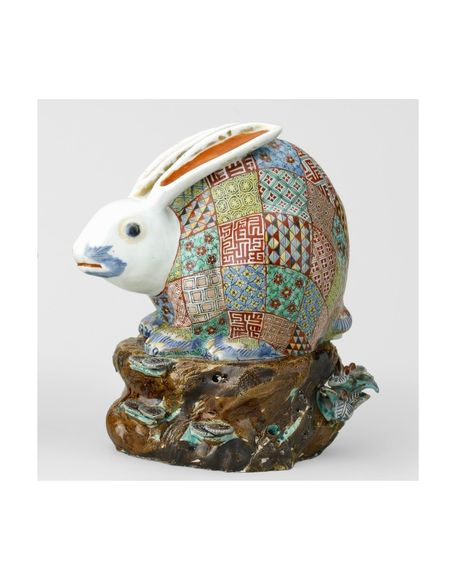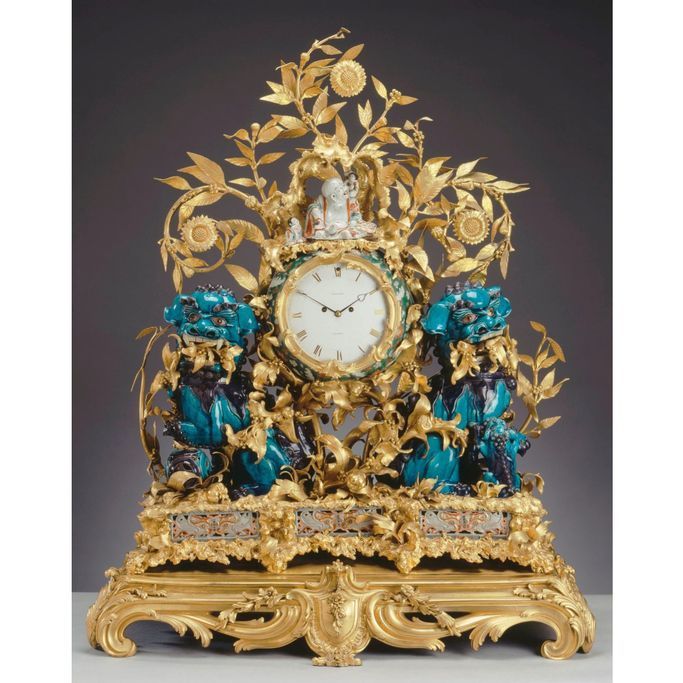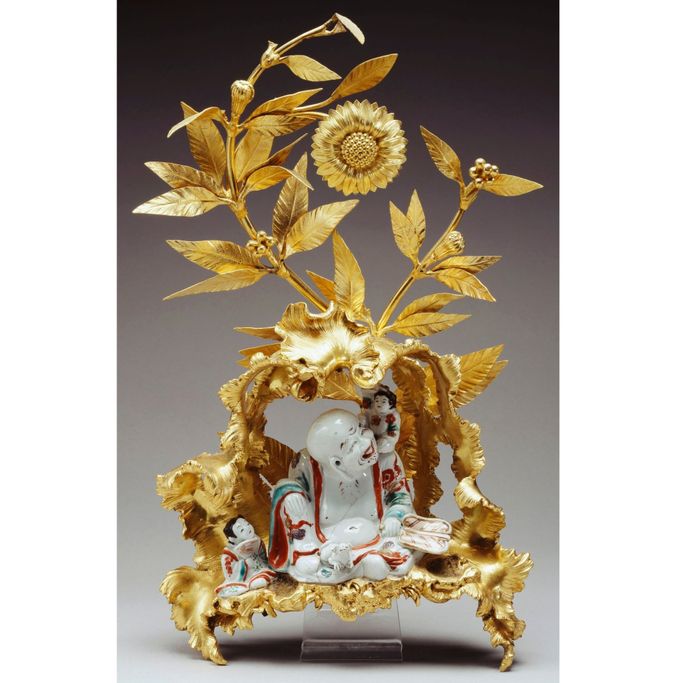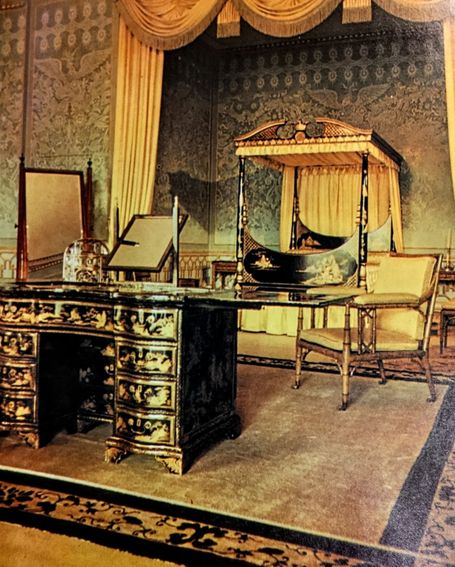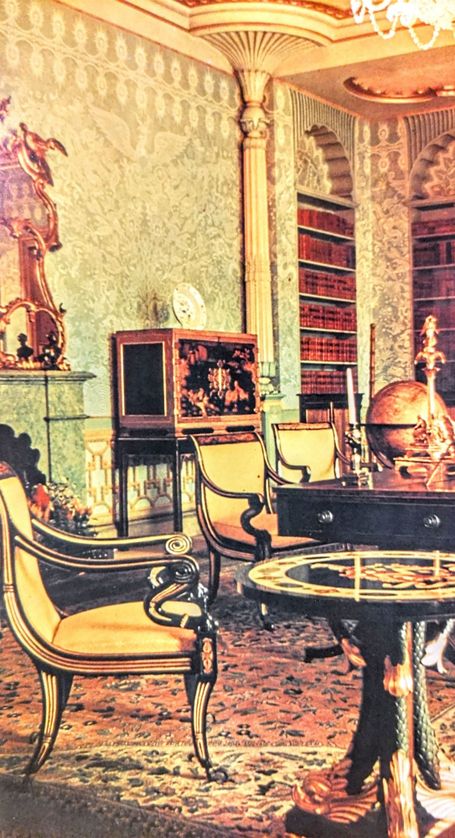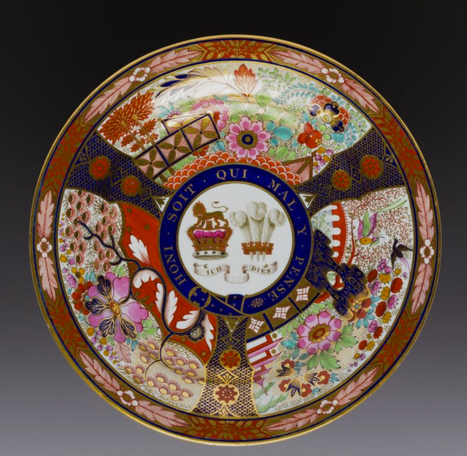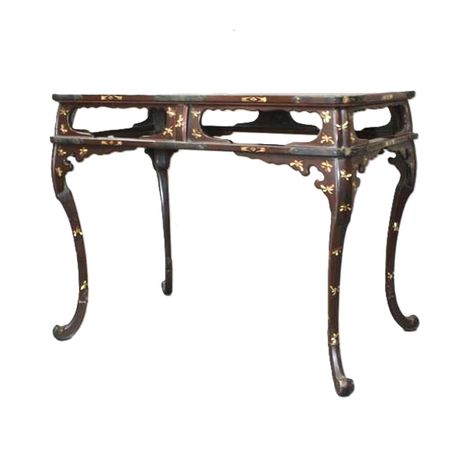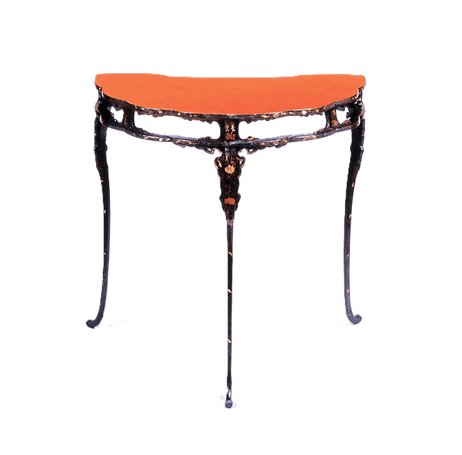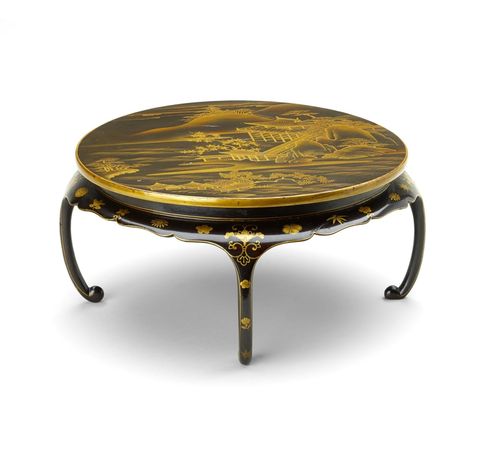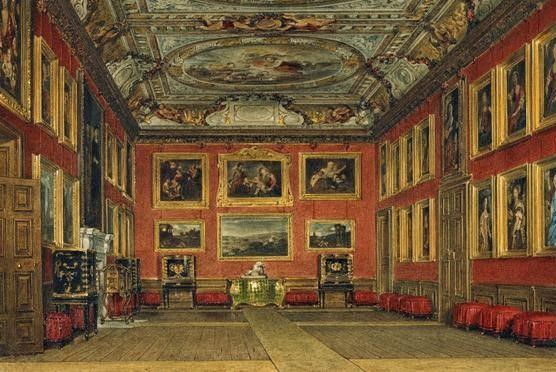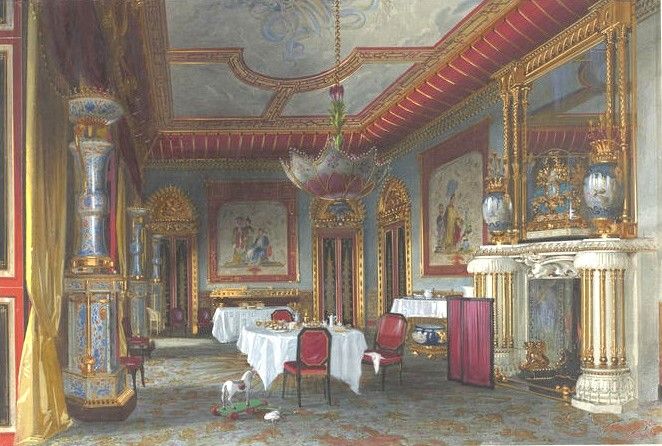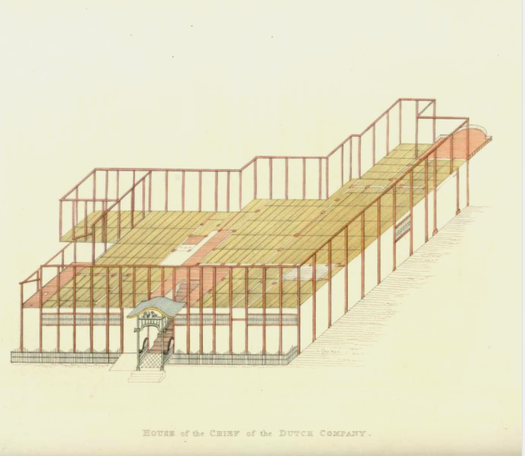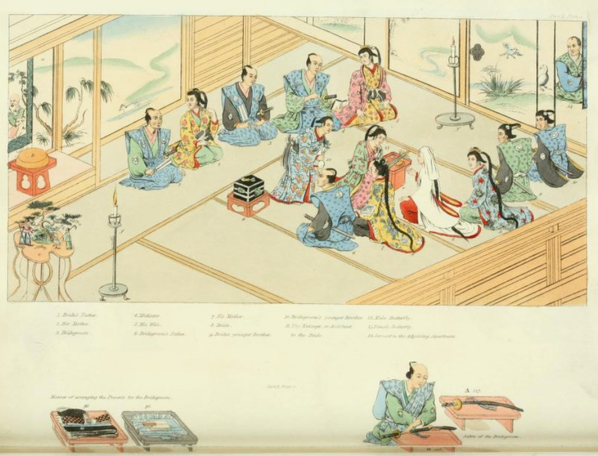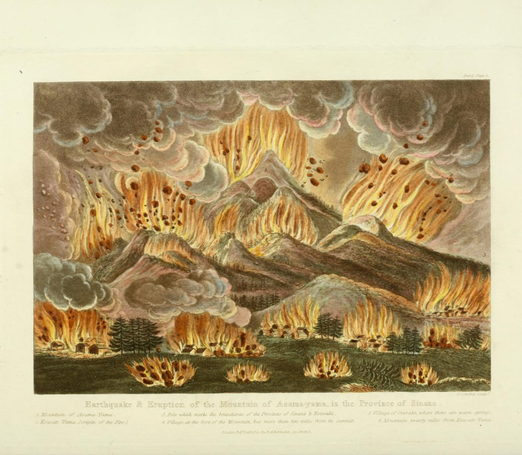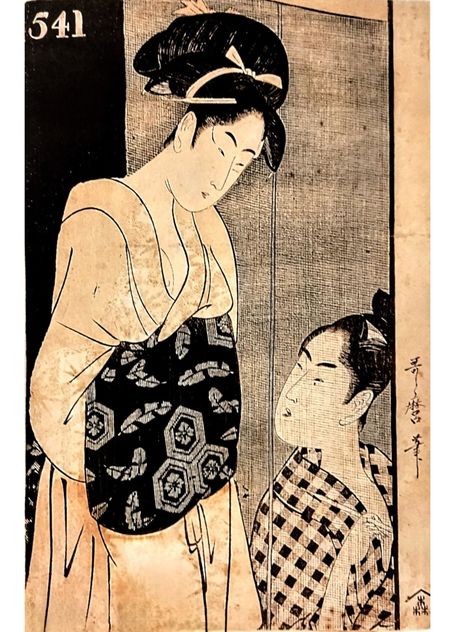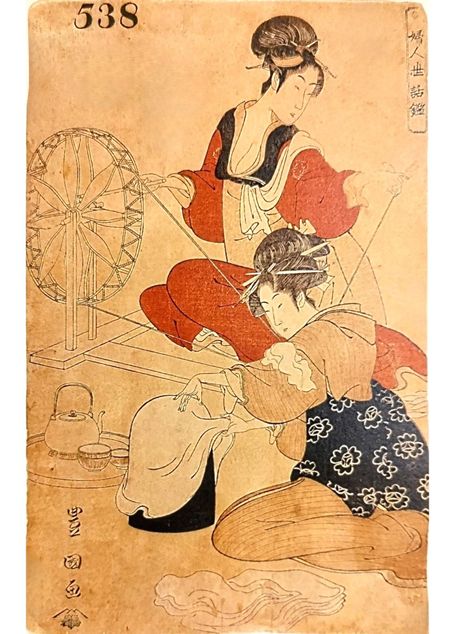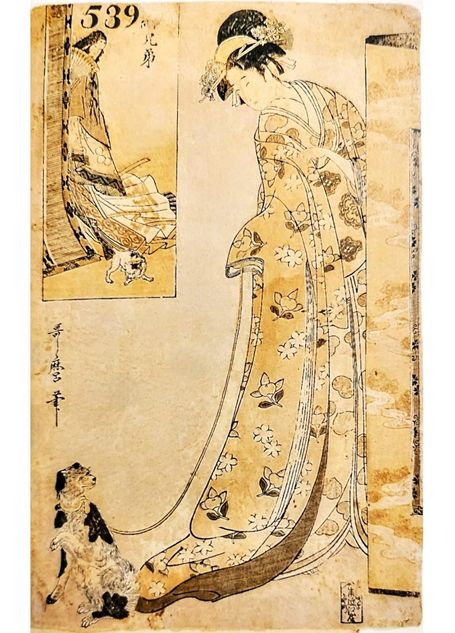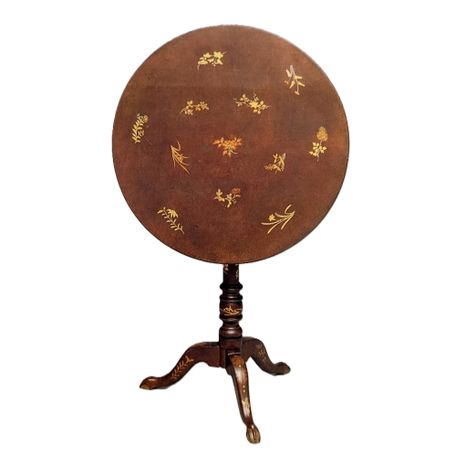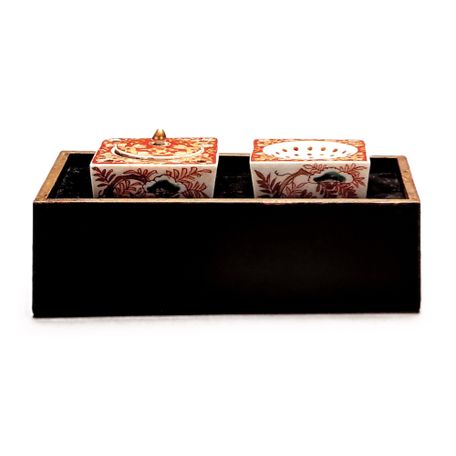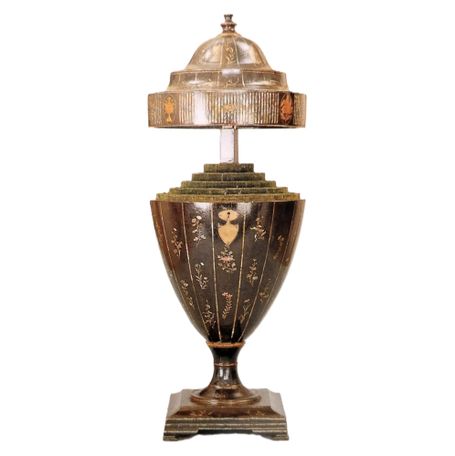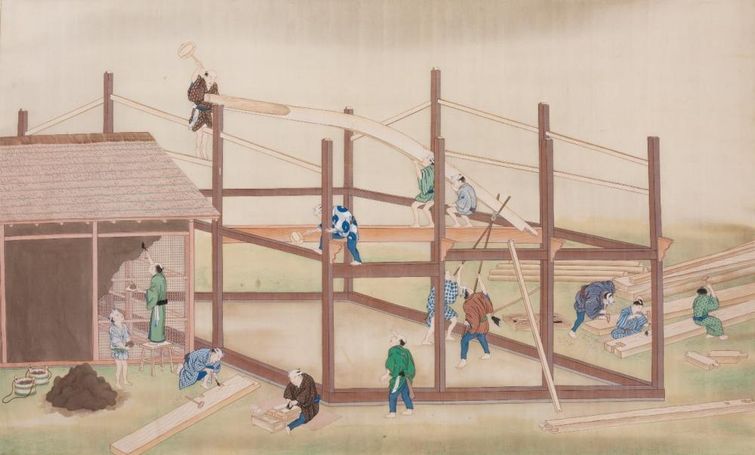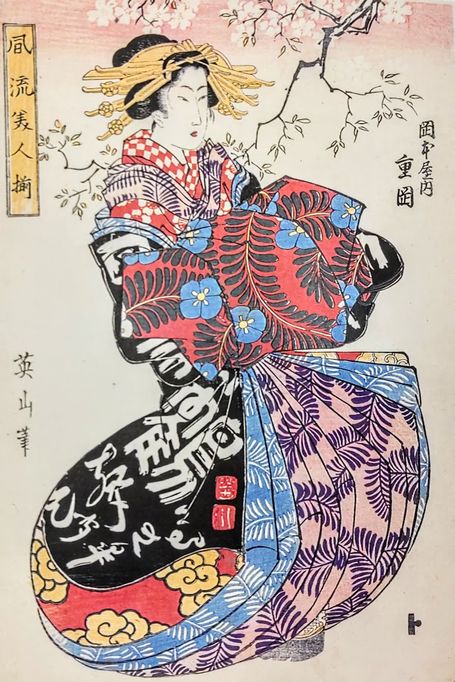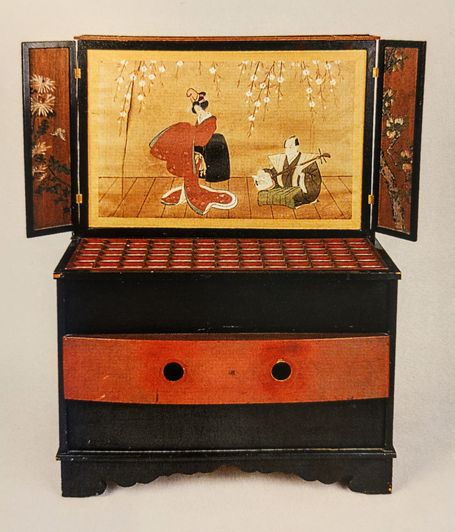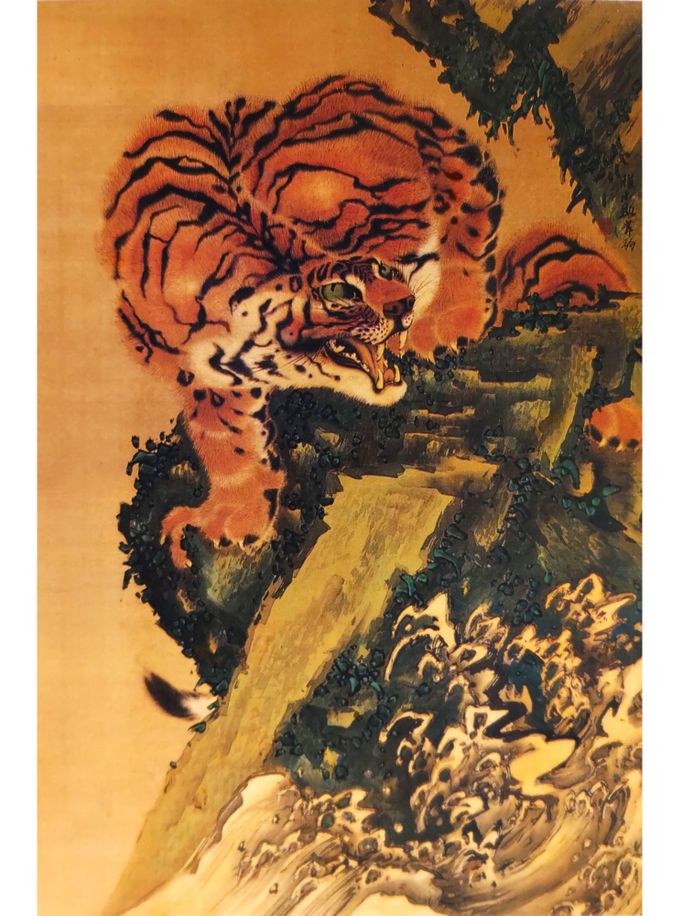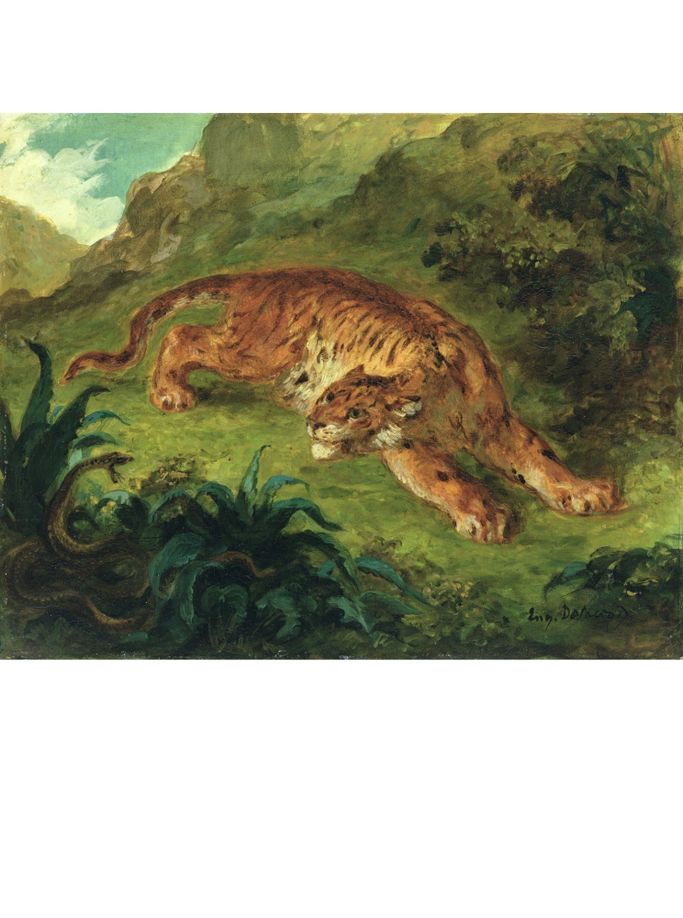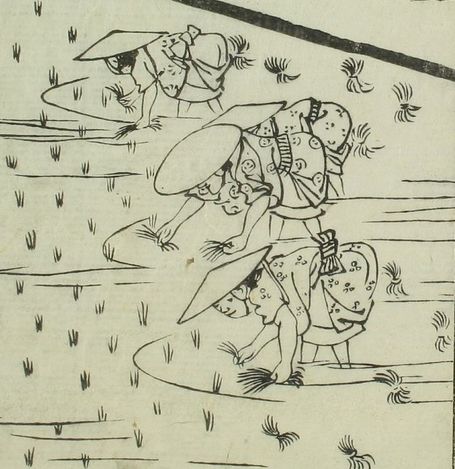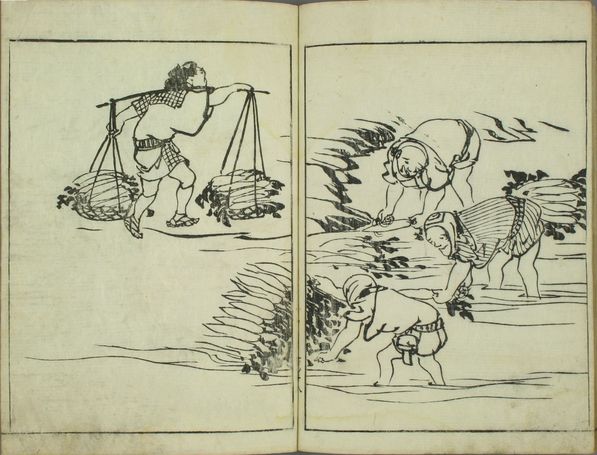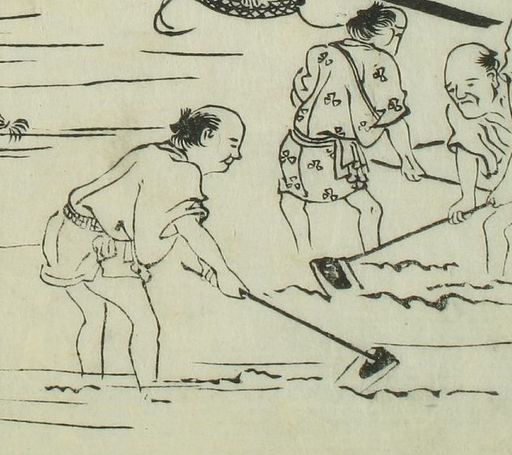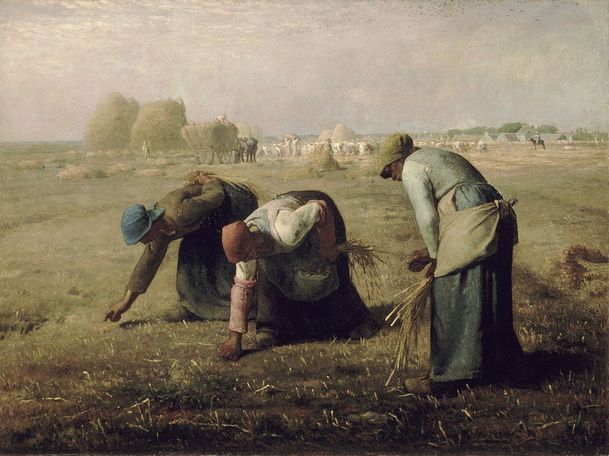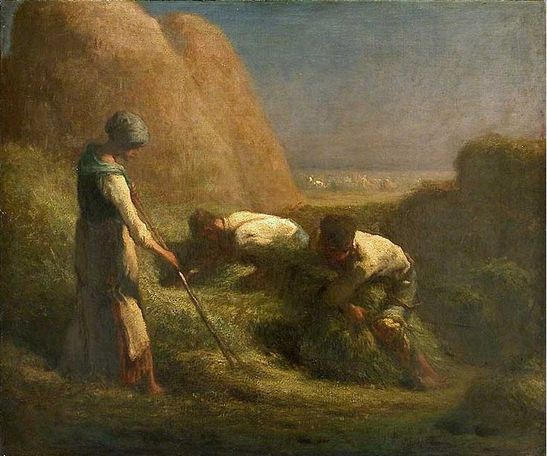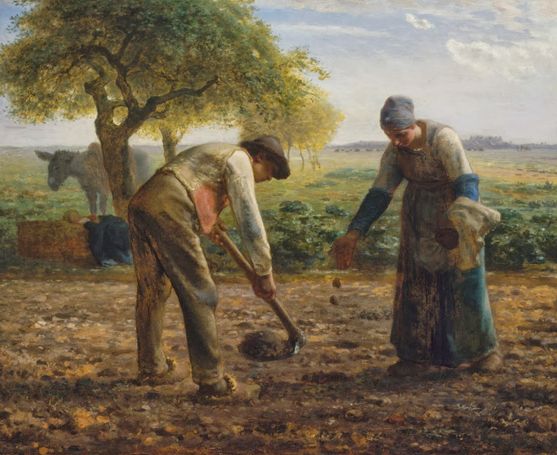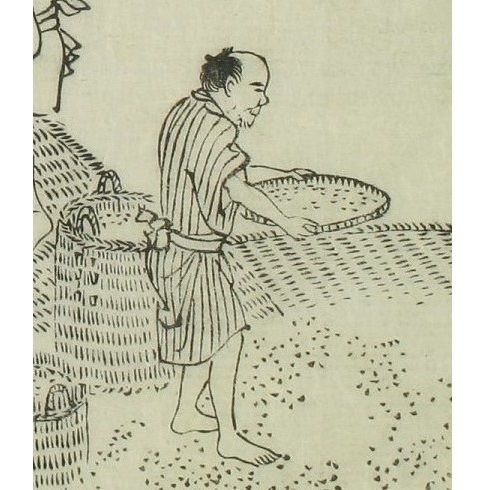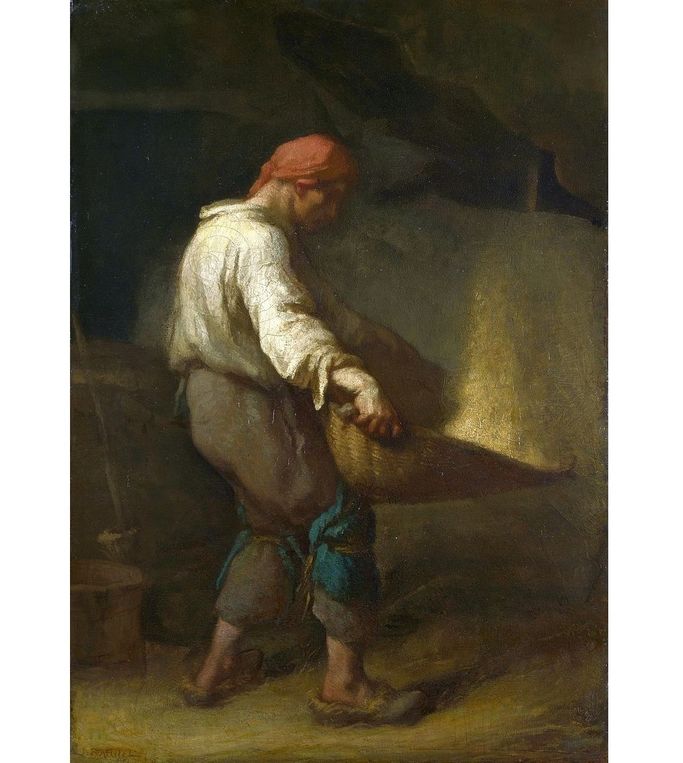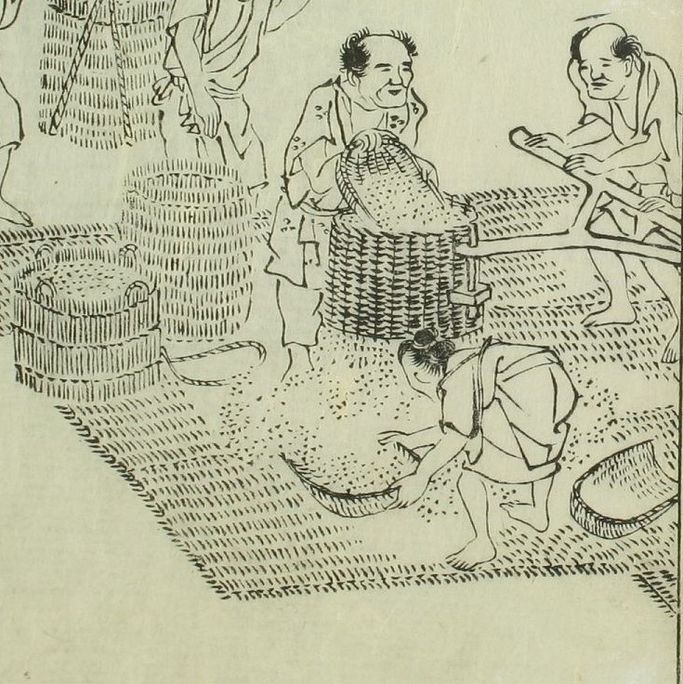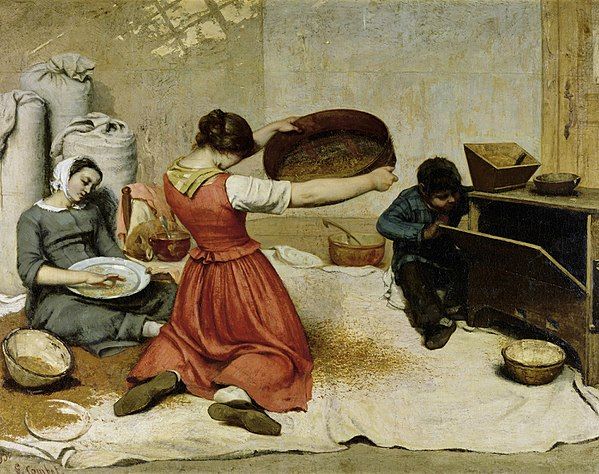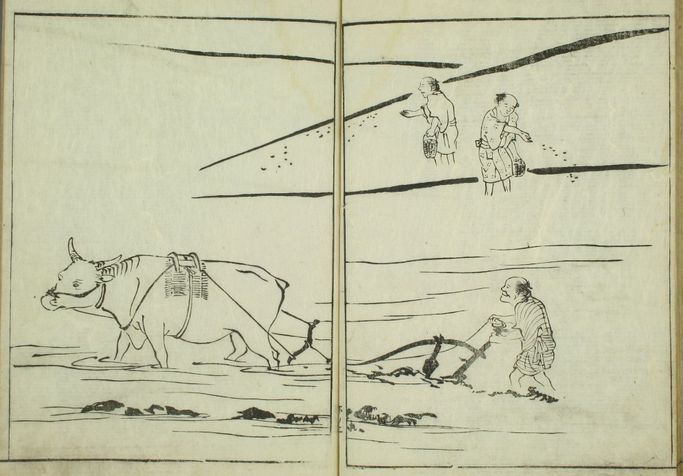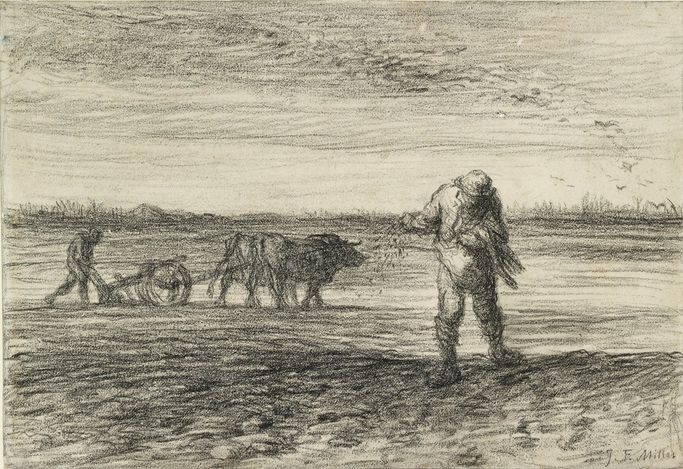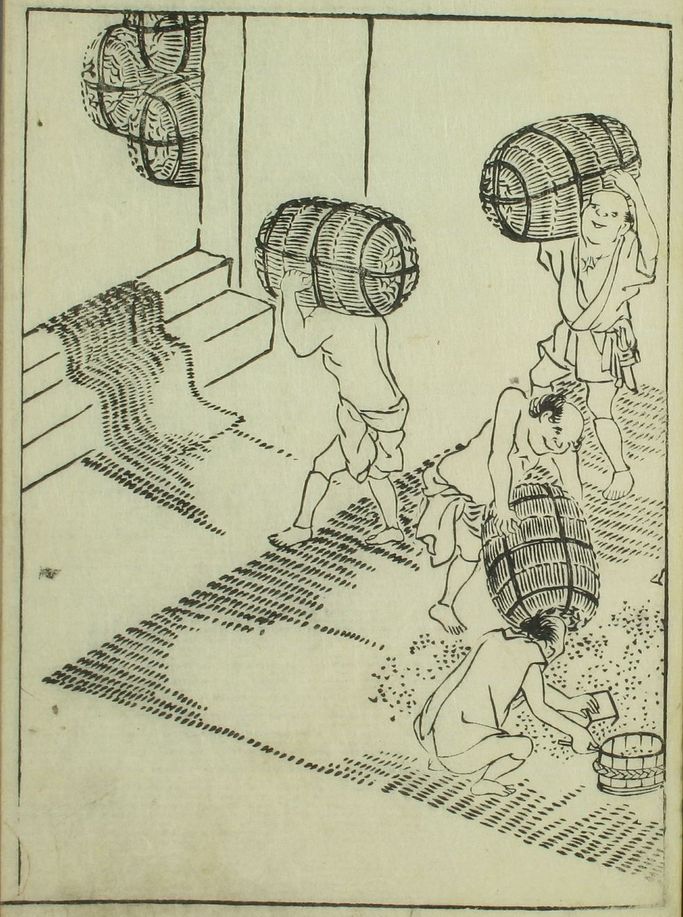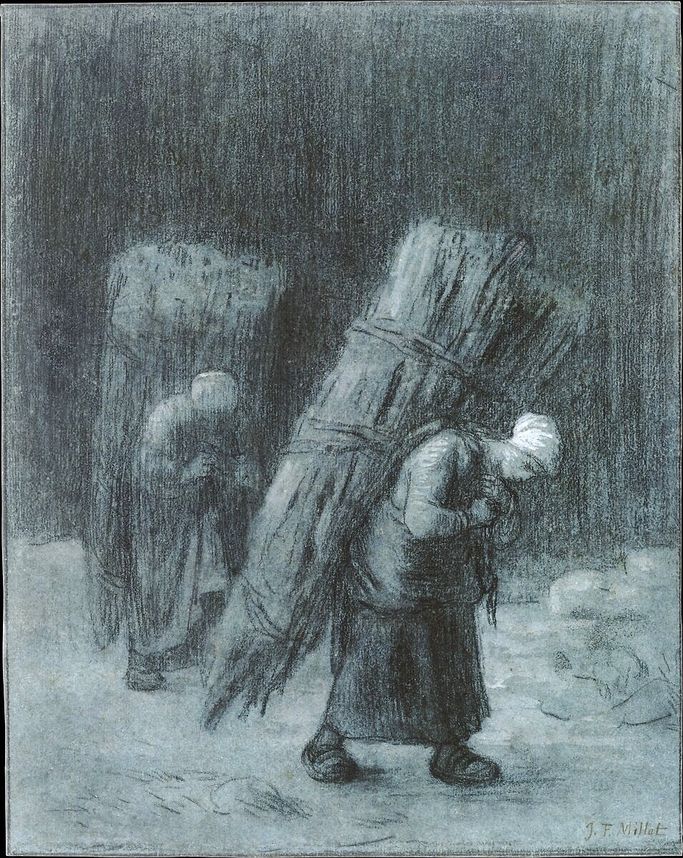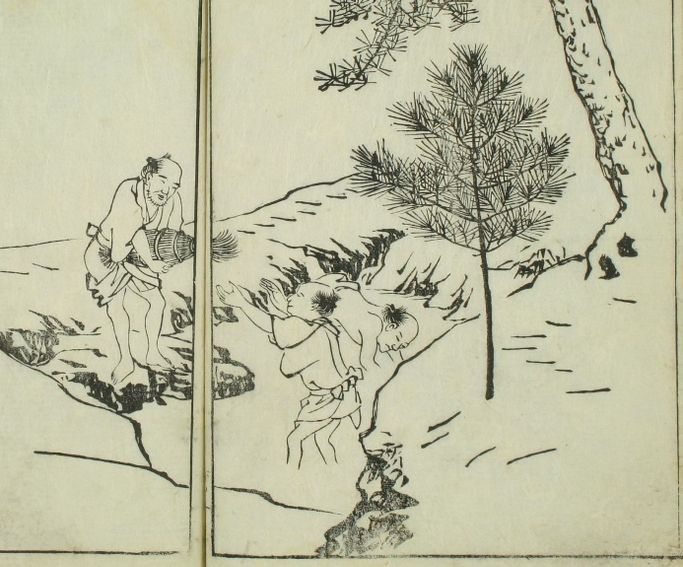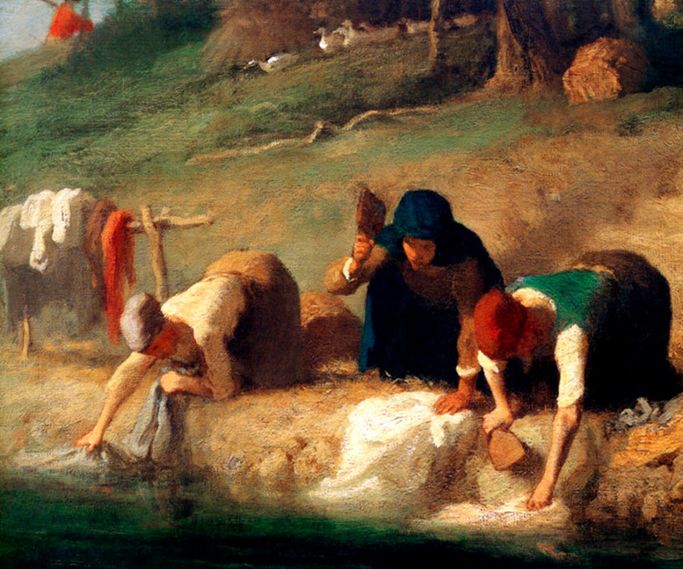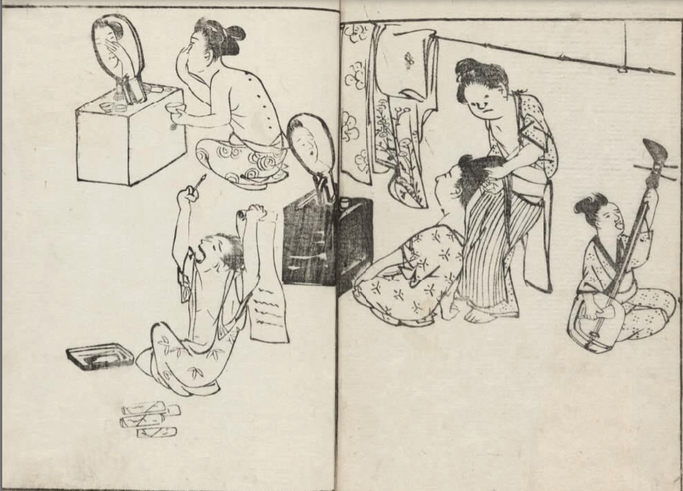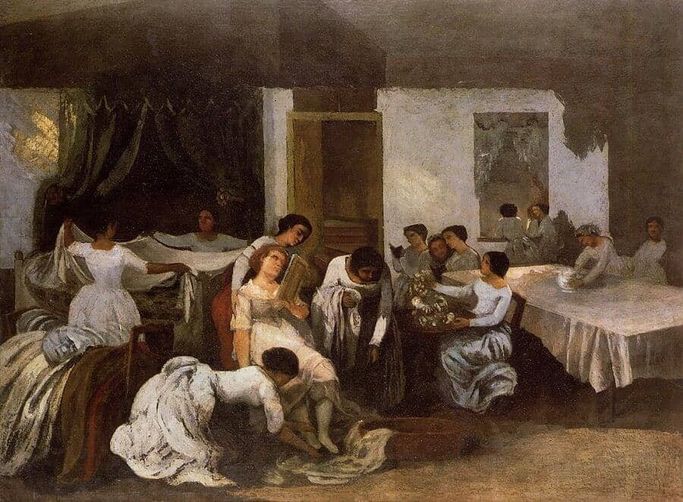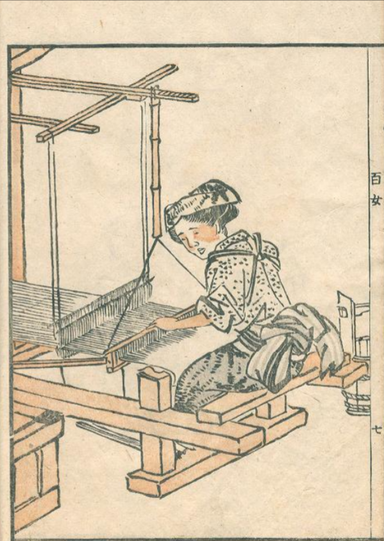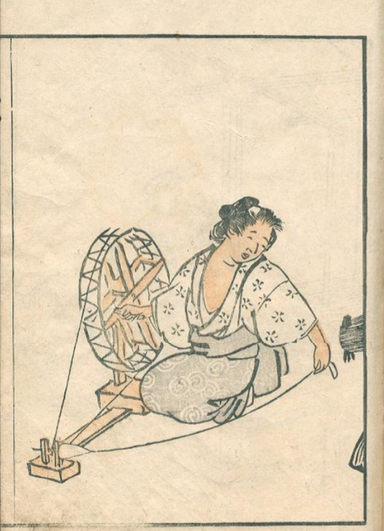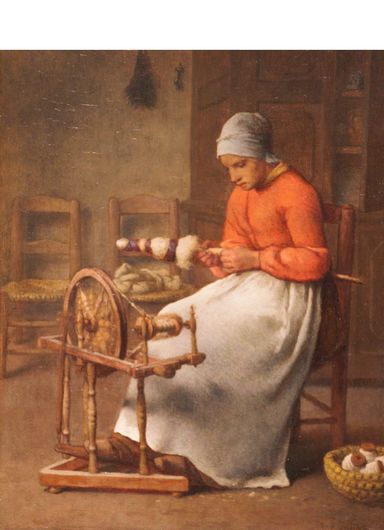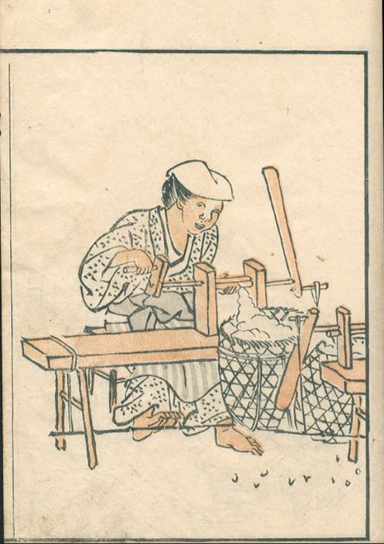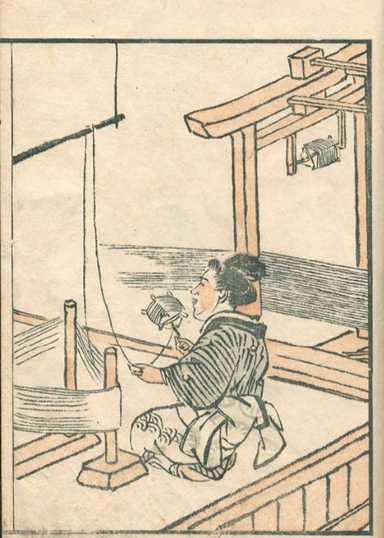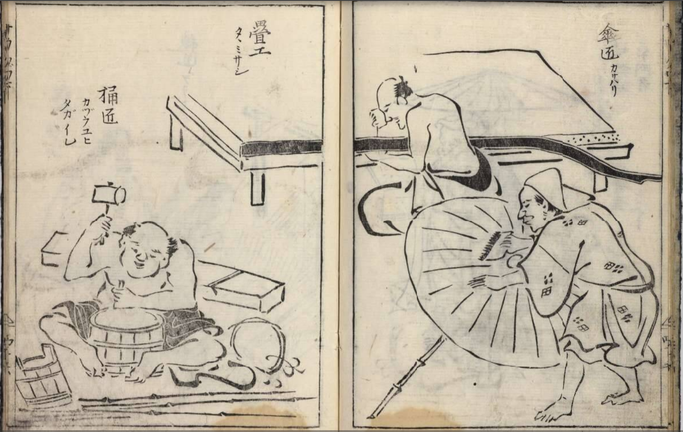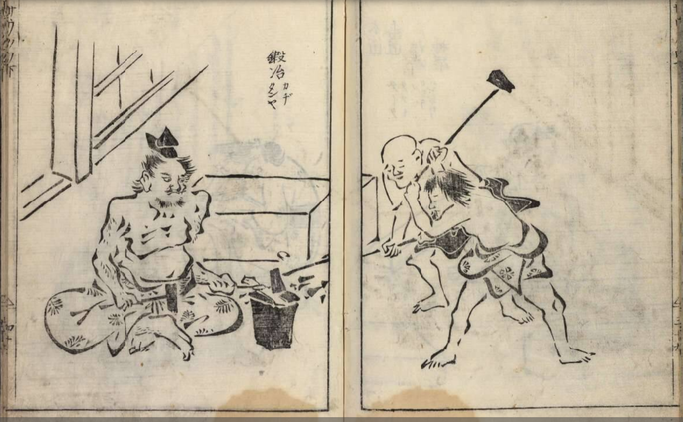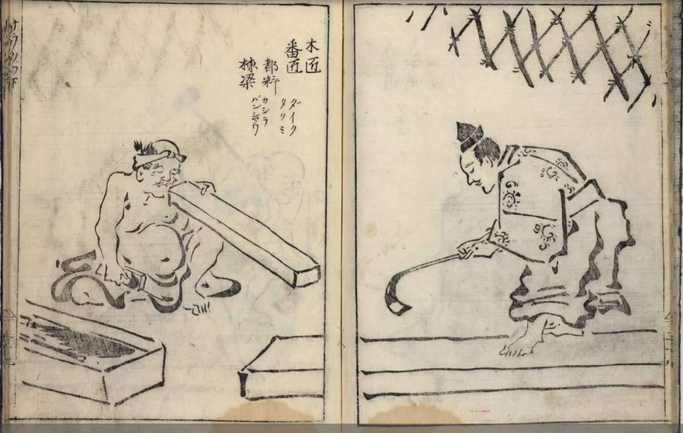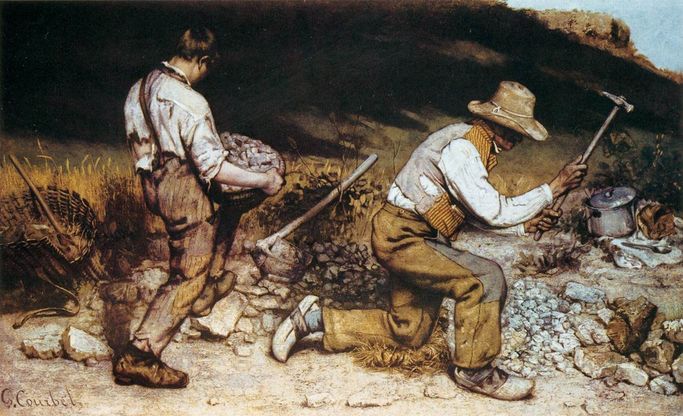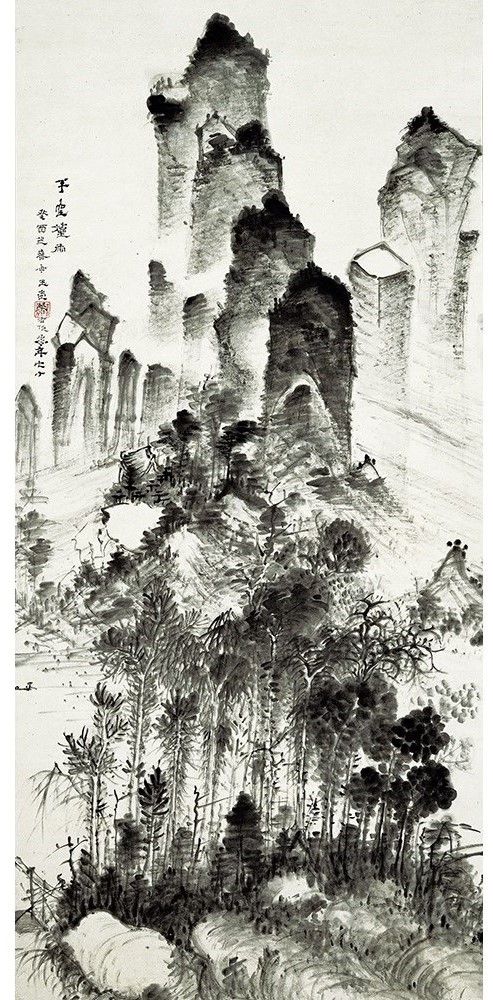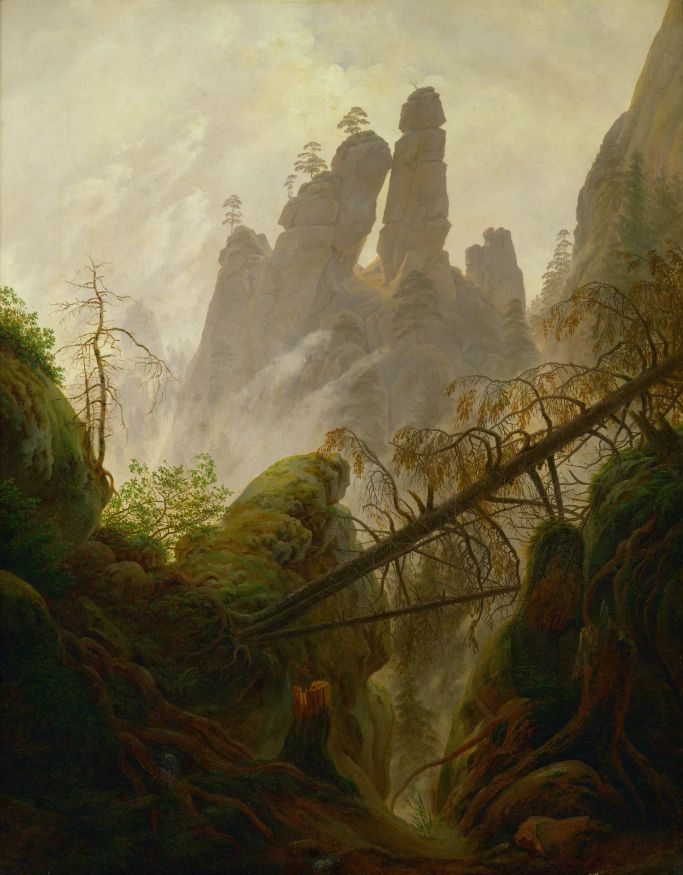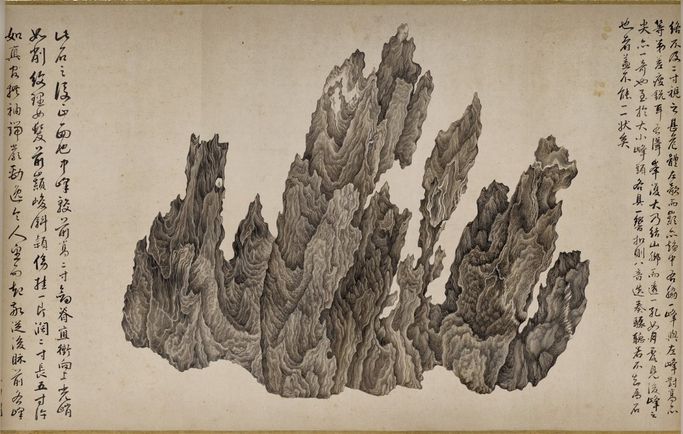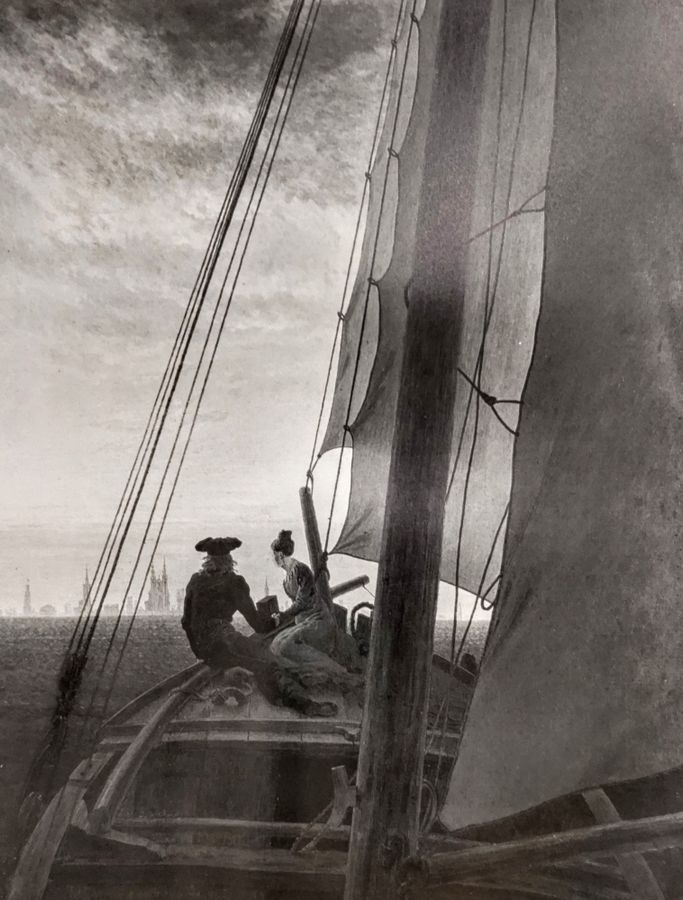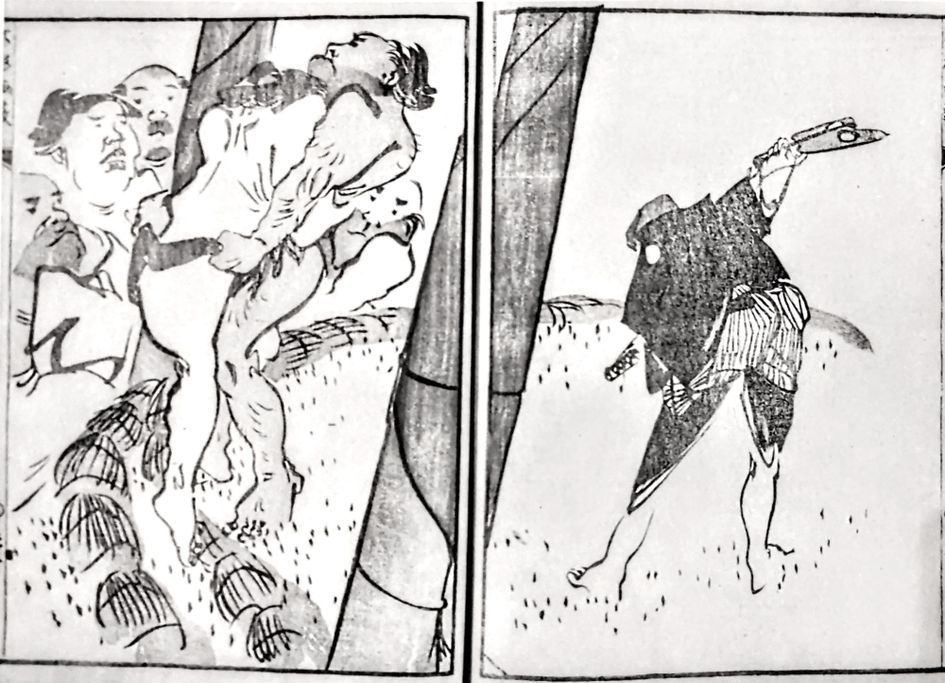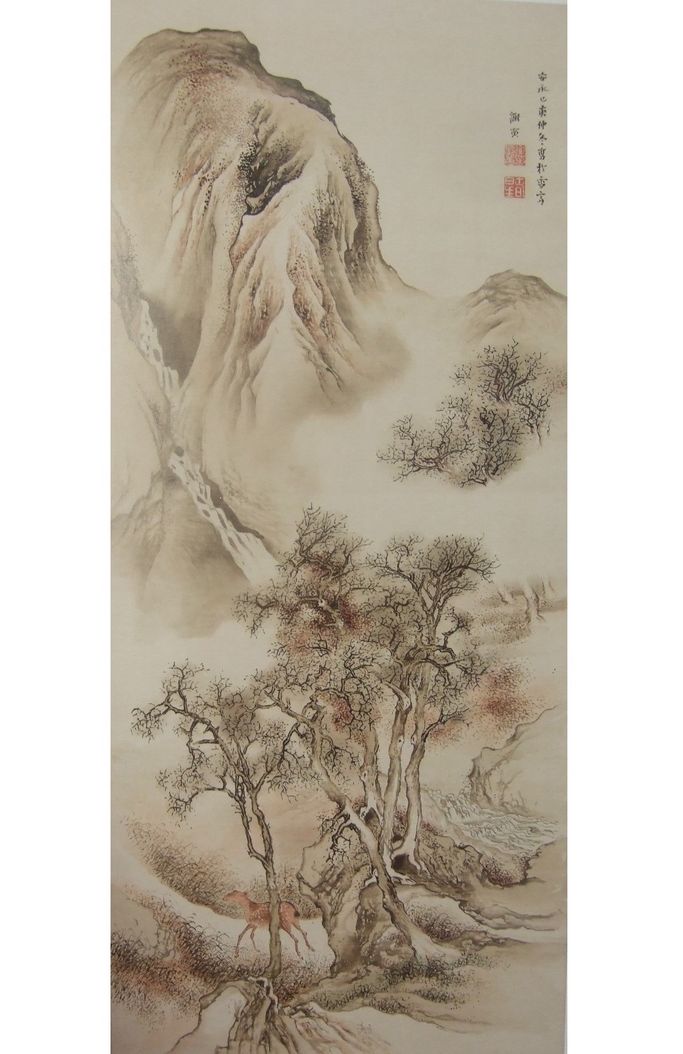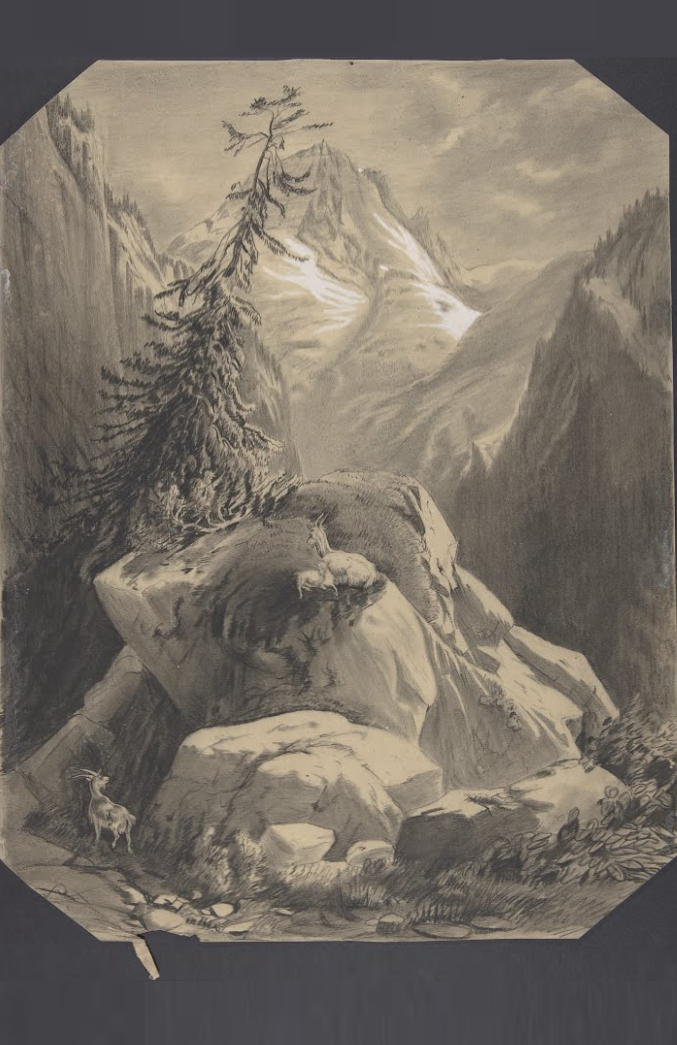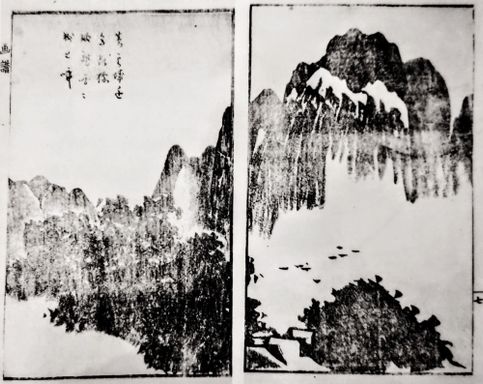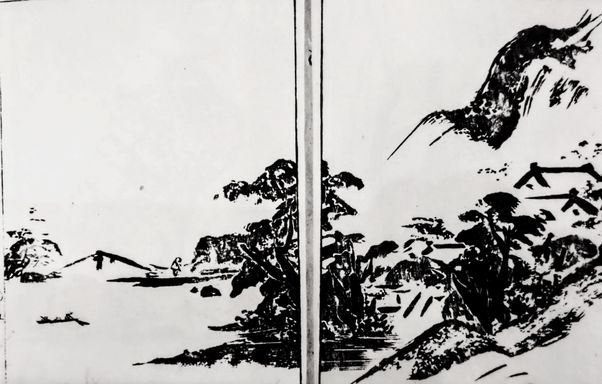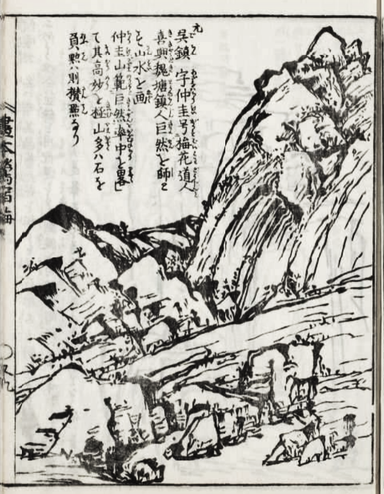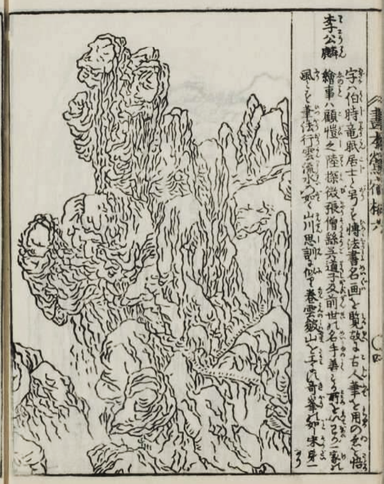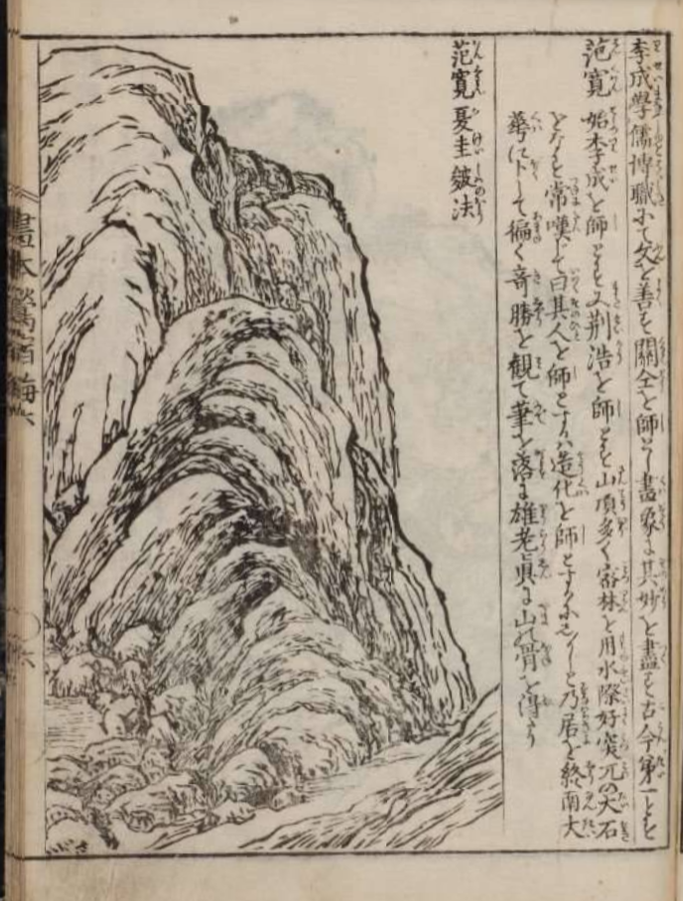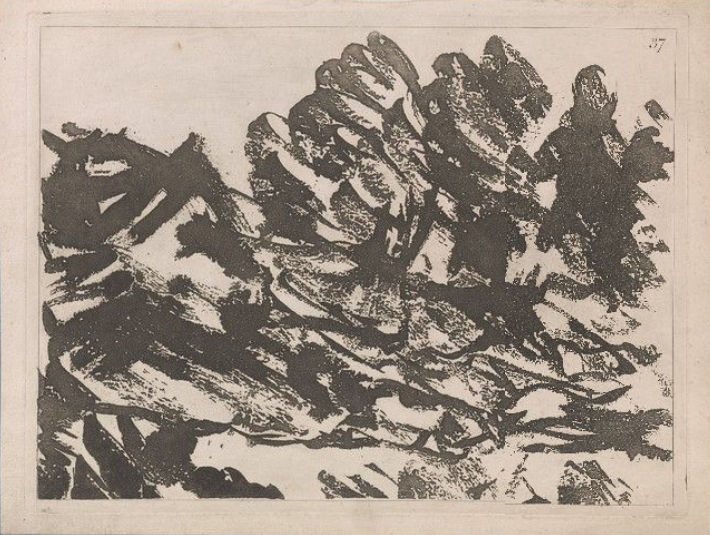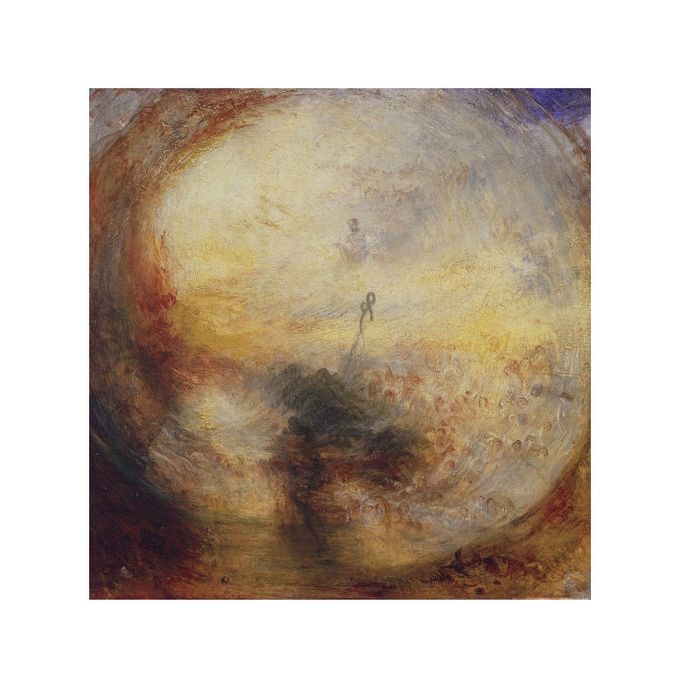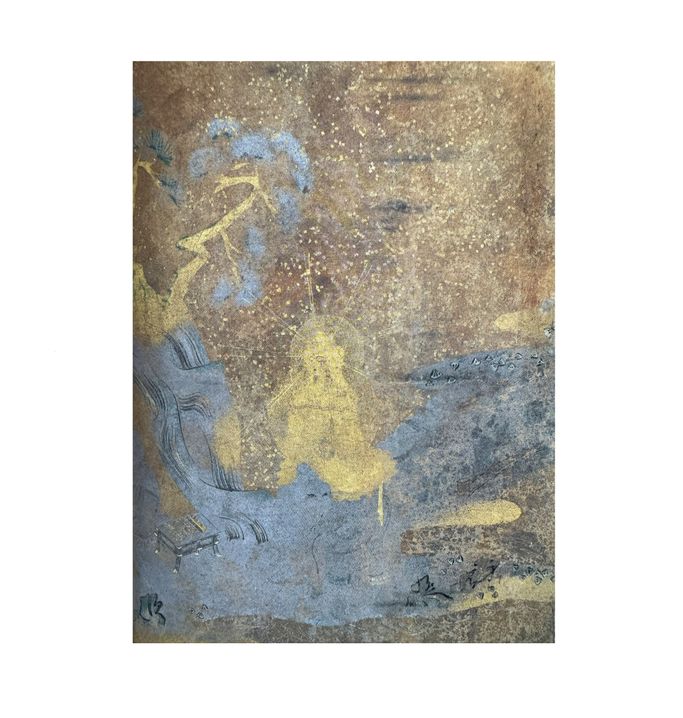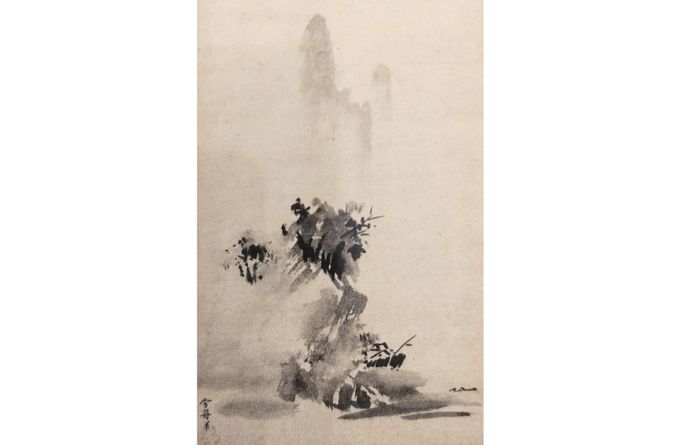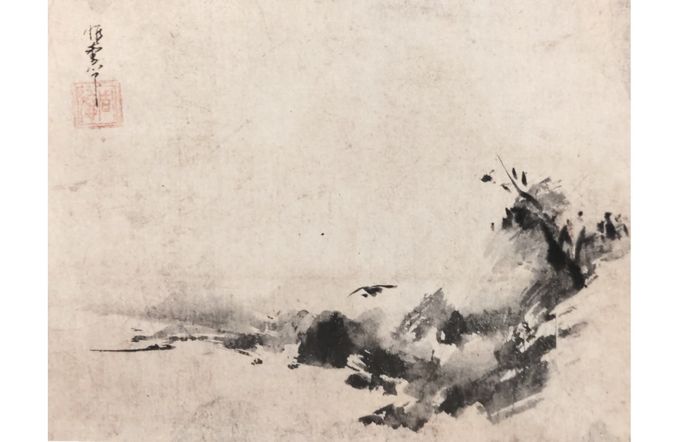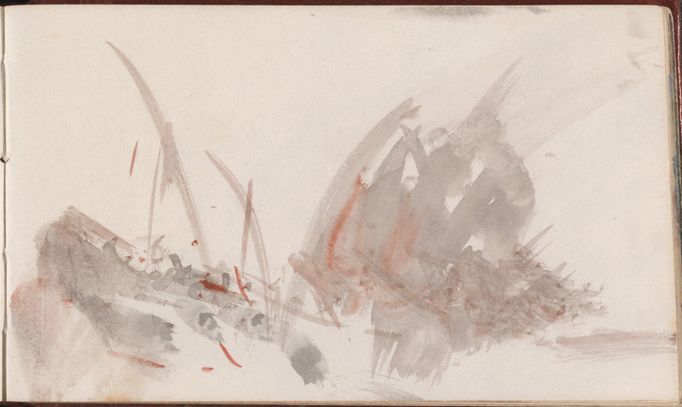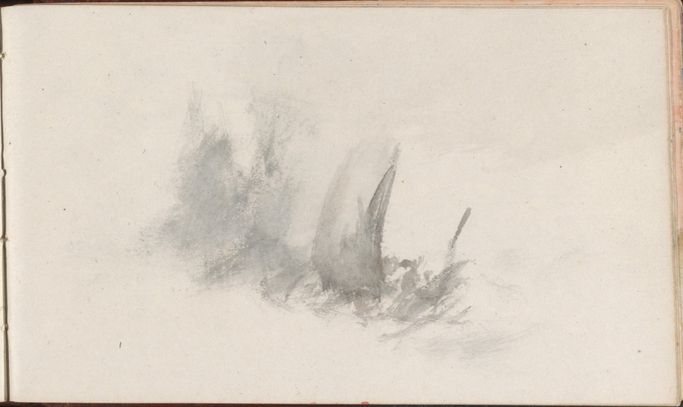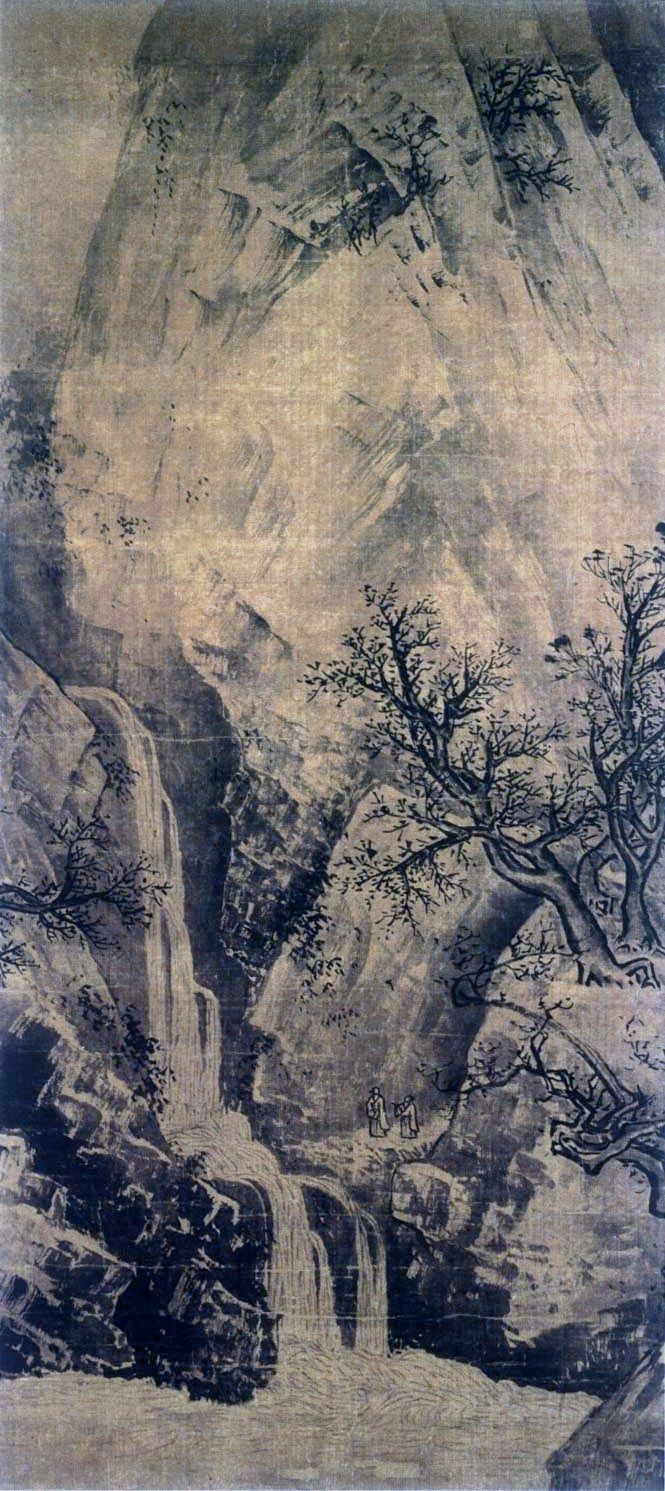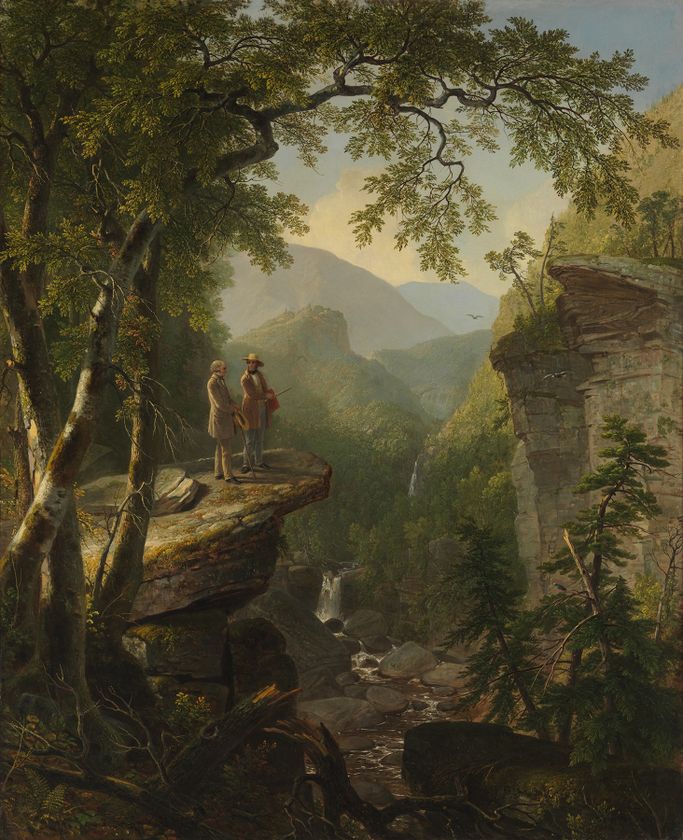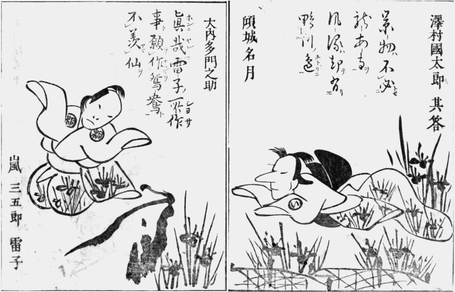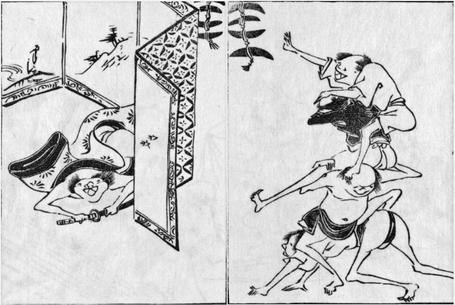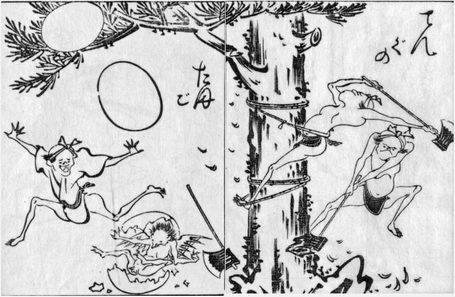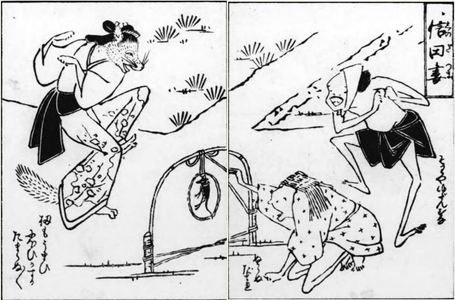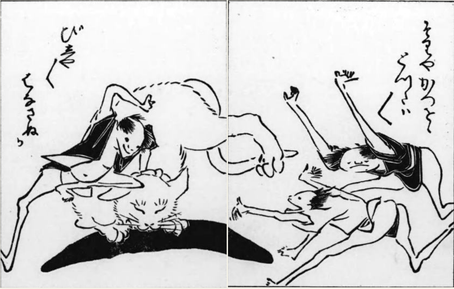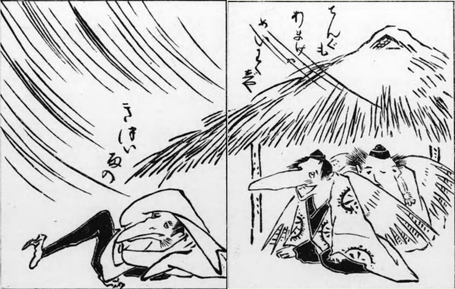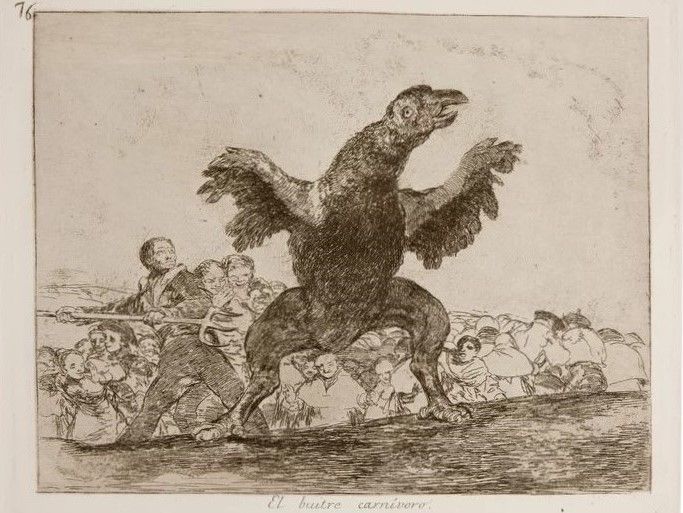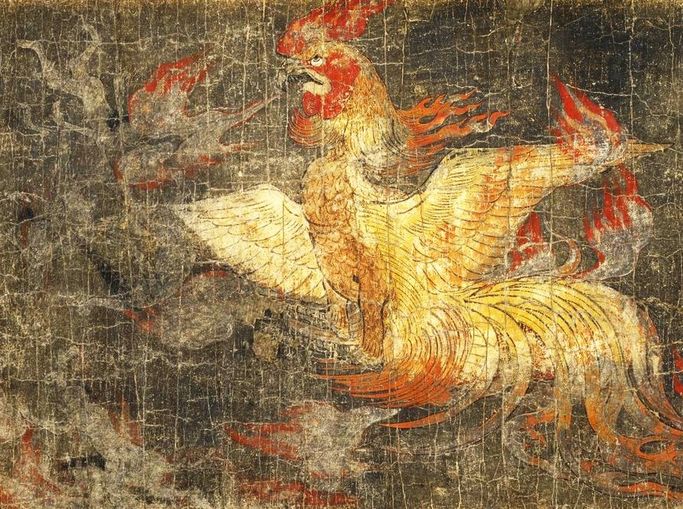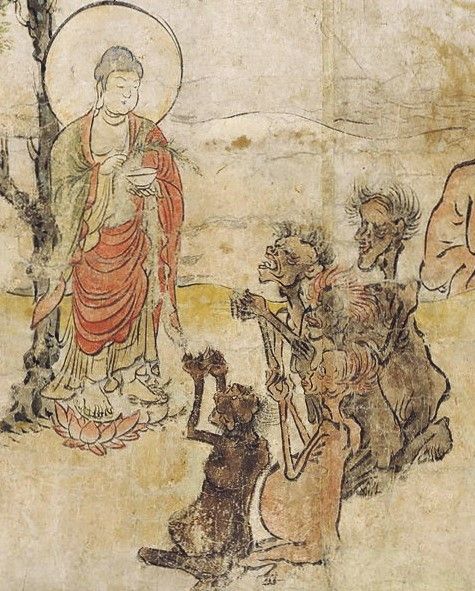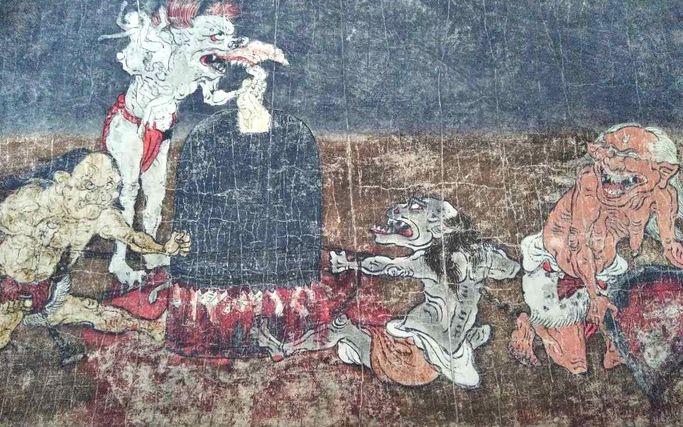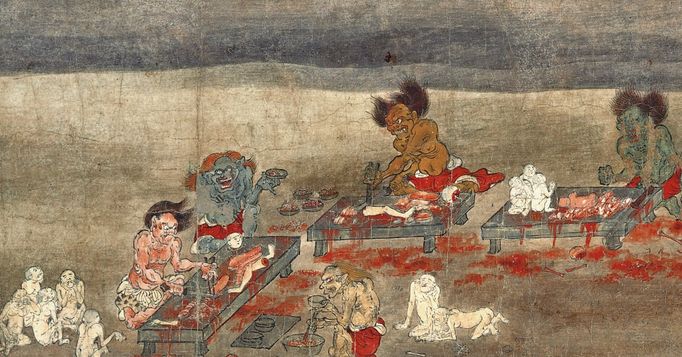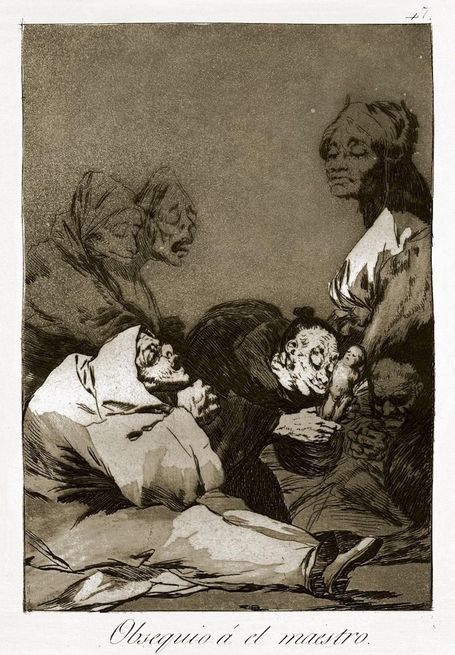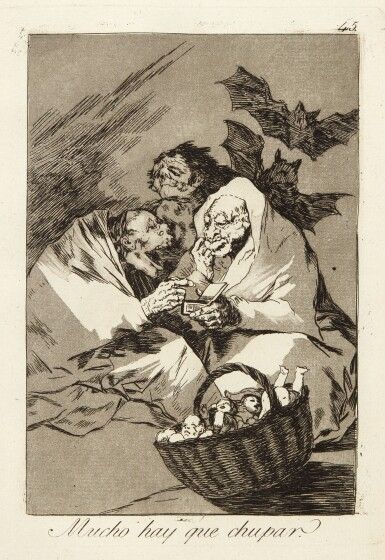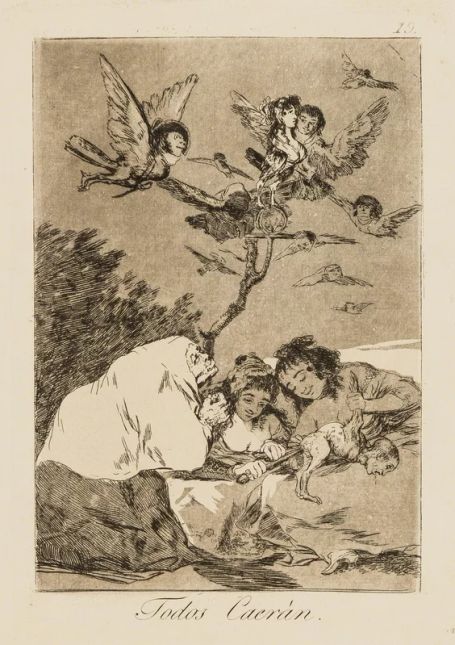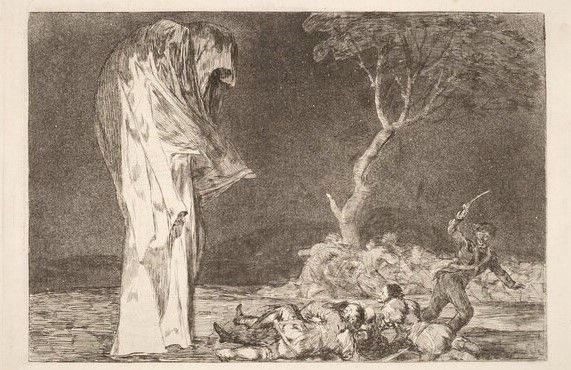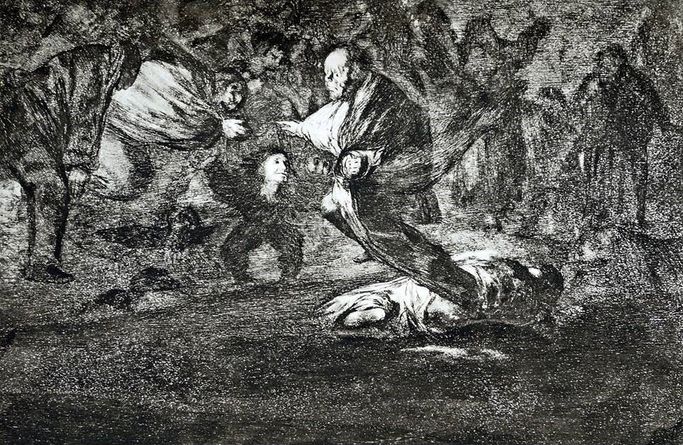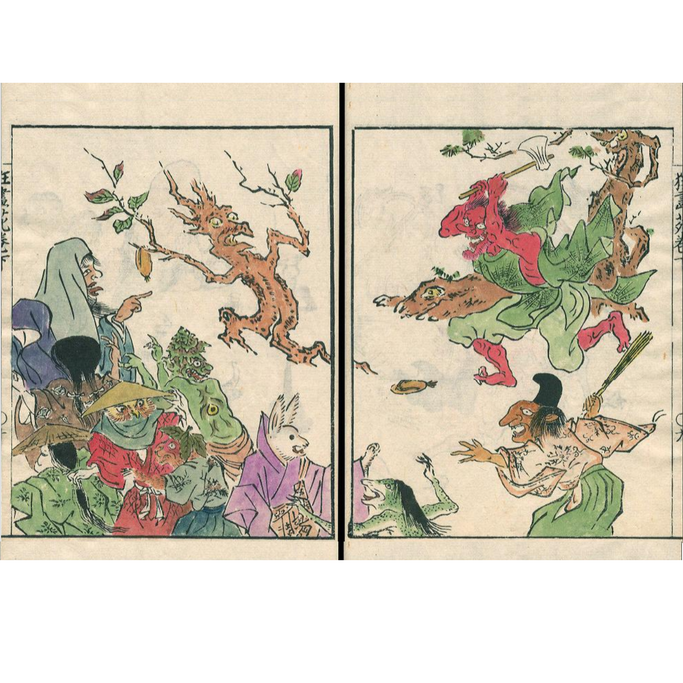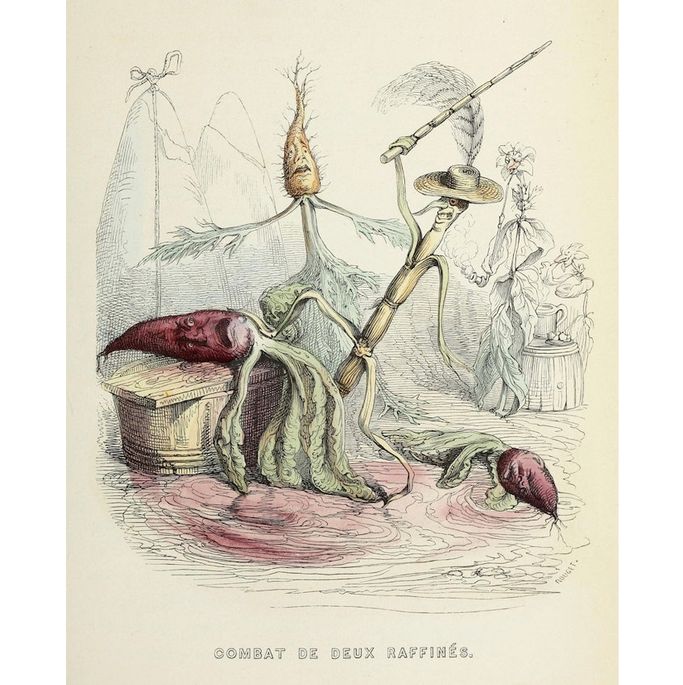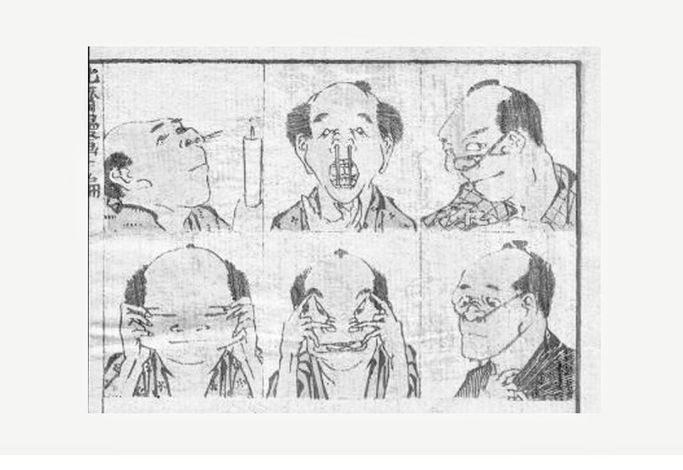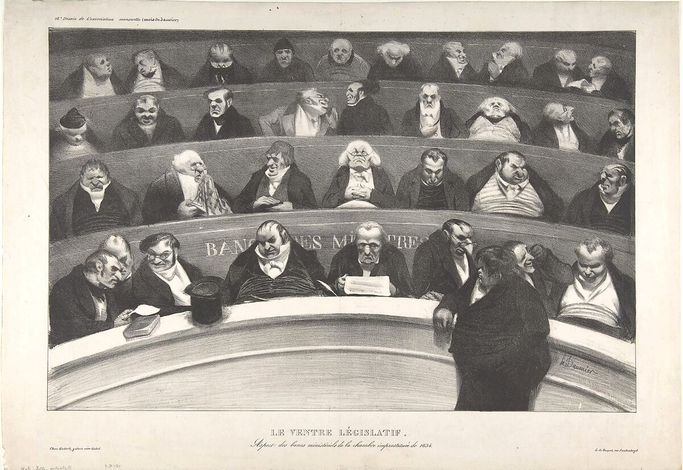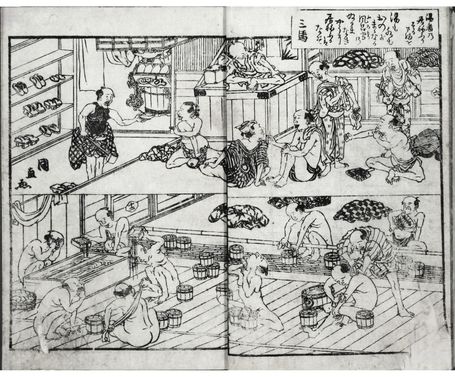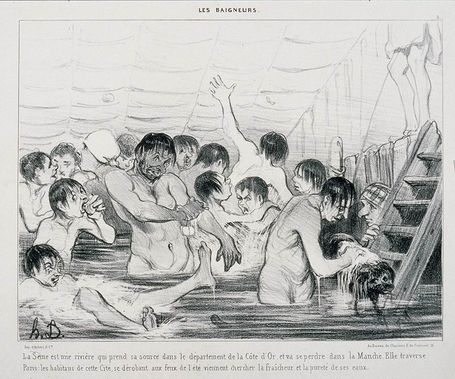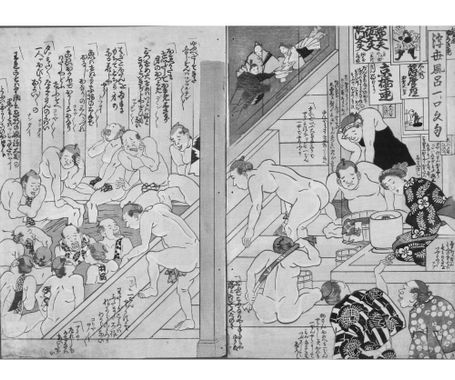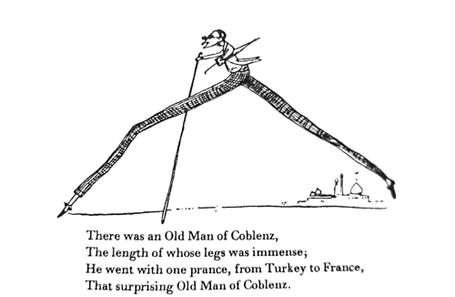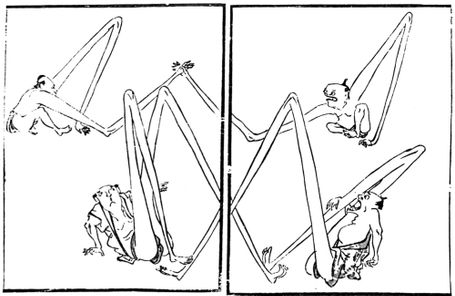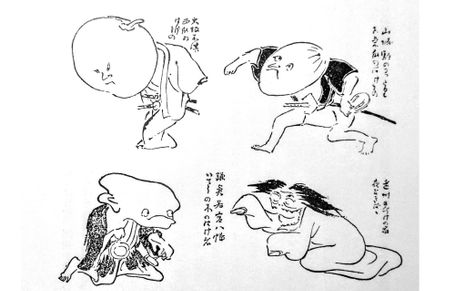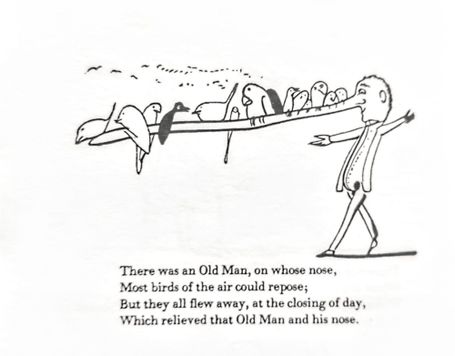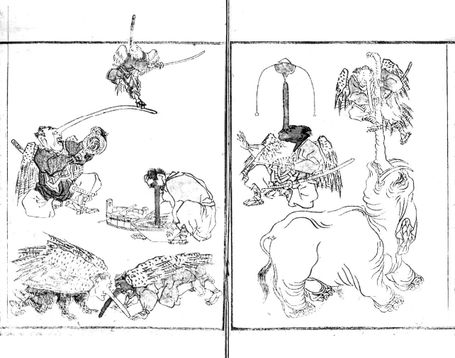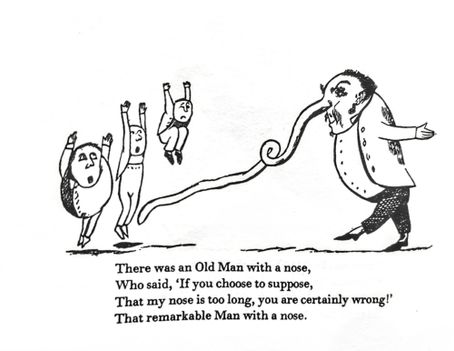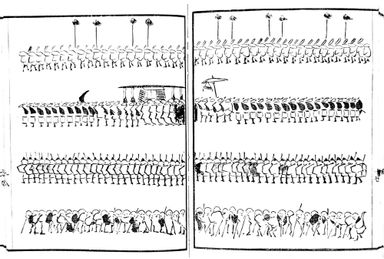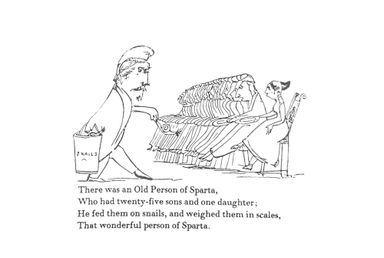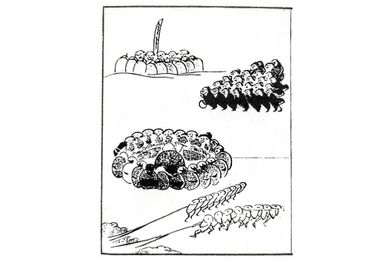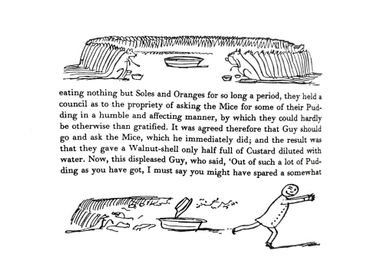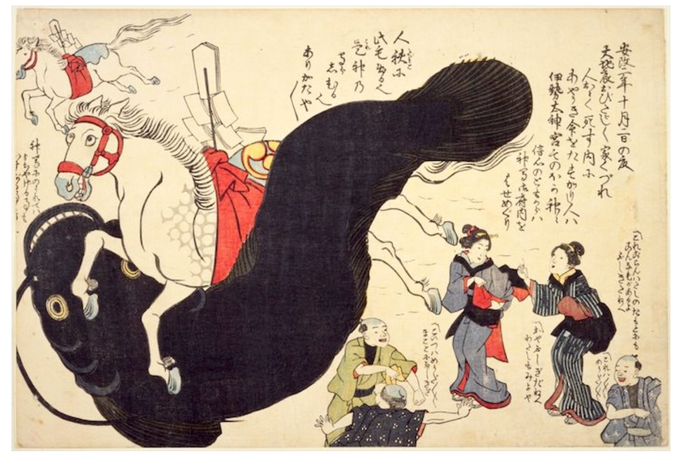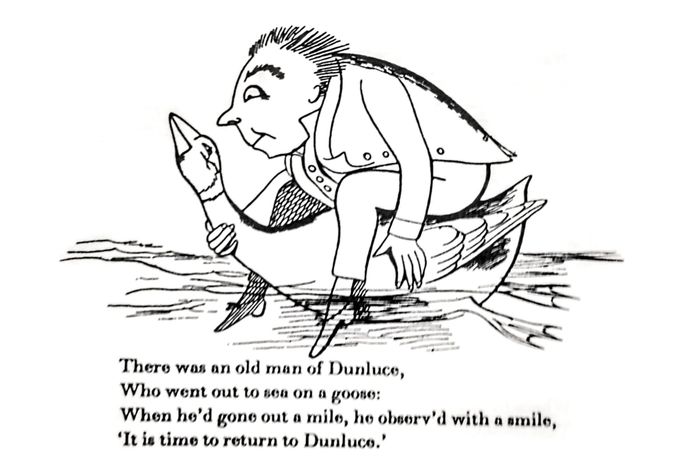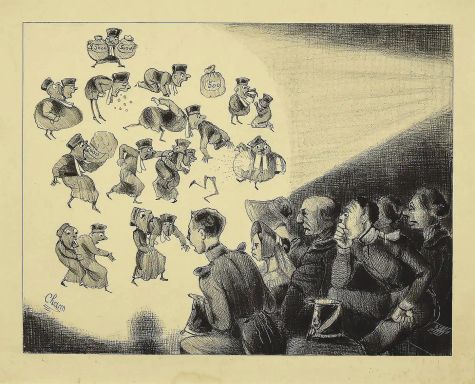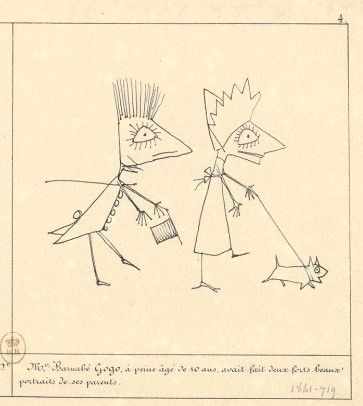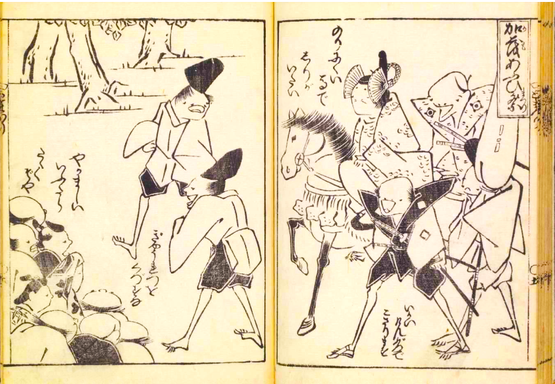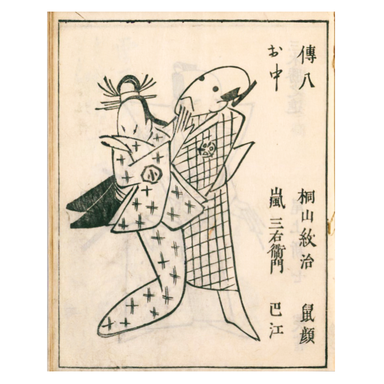Japonisme in the 'Intermediate Period' 1793-1853
The Subcurrent of the Far East in an Age of Romanticism, Orientalism and Realism
Uploaded 2024.3.30, under construction, photos to be further annotated and text revised. If the images do not appear in due time, please refresh/reload the page.
Yasutaka Aoyama
Background photo: Section of JMW Turner's ‘A Bay on a Rocky Coast, with a Man Running’ (1792-93)
Part I
1. Introduction: Gautier's Japan within Chinoiserie
2. Hanoverian Japonaiserie and Chinoiserie during the Intermediate Period
3. Japanese Prints and Books on Japan in Circulation in Europe 1790's - 1830's
4. What Americans saw and brought back from Japan 1790's - 1840's (text to be added)
Part II
4. Dutch Royal Patronage & Private Enterprise in the Dissemination of Japanese Art and Ideas in Europe 1810's-1830's
5. Kawahara Keiga and the Three Great Collectors
6. The Public Display of Japanese Art: A Shift from Royal Patronage to Private Enterprise in the Netherlands 1830's-1850's
Part III
7. Investigating Japanese Influences on Western Art in the Intermediate Period
a. The Kobayashi Taichiro Thesis: Ukiyo-e Japonisme in France from Ingres to Millet
b. Suiboku-ga and Yamato-e Qualities of British and Continental Romantic Painters from Friedrich to Turner
c. The Japonisme of Humor, Satire, and the Fantastic in Goya to Daumier
8. Conclusion: Time to Open the Floodgates
Introduction: Gautier's Japan within Chinoiserie
Commodore Perry's arrival in Japan in 1853 and the subsequent opening of the country, accompanied by a flow of Japanese art into the West setting off what came to be known as the 'japonisme' movement, is well-documented. Likewise, an avid interest in Japanese lacquer, porcelain, and kimonos under the rubric of 'chinoiserie' in the 17th and 18th centuries, up to the French Revolution of 1789, can also be firmly established. The question remains as to what Japanese artistic influence there might have been during the half century or more in-between, from the 1790's to the 1850's, what we will call here the 'Intermediate Period'. There is no reason why there could not have been that sort of influence upon individual artists during this time, just because Japan was no longer a fashionable social phenomenon. But unfortunately, regarding this substantial period of time, the question of Japanese artistic influence is hardly investigated, and usually assumed to be negligible at best.
Not only Japan, but China too, was less the fad that it once was, turning 'passé' if you will, among the well-to-do. Yet it, and Asia in general, was still of considerable interest to certain European intellectuals. Serious work in the translation of oriental languages was growing, including religious texts, not only of Sanskrit but Buddhist writings in Tibetan and Chinese. Julius Heinrich Klaproth (1783-1835) started the journal Asiatische Magazin at Weimar in 1801, and who, traveling as far as Eastern Siberia collecting linguistic and ethnographic material, is said to have met "a Japanese naval officer interned there" who "taught him Japanese in Irkutsk" (according to Klaus Karttunen, University of Helsinki, www.whowaswho-indology.info). If so, whoever this Japanese was, he must have helped clarify the meaning of Chinese kanji characters for Klaproth in the process. Napoleon in 1808 commissioned Chrétien Louis Joseph de Guignes (1795-1845) to publish a Chinese-Latin-Dictionary, completed in 1813; Jean Pierre Abel Rémusat (1788-1832) became the first professor of Chinese at the College de France in 1814; Michel-Jean-François Ozeray (1764-1859) published the first essays on Buddhism in 1817 followed in 1823 by Klaproth on the subject; the Hungarian Alexander Csoma de Körös (1784/87-1842) traveled to Tibet 1823, studying Lamaist Buddhism and producing a Tibetan-English dictionary, Buddhist glossaries, and commentaries during the 1830's; and Guillaume Pauthier (1801-1873) produced a slew of books on China starting from the mid-1830's onward. And it was during this time that Arthur Schopenhauer (1788-1860) conceived his philosophy in which he himself frequently refers to Brahmanist and Buddhist ideas, and who has been described by Wolfgang Schirmacher, professor and president of the International Schopenhauer Association as "a Zen master and arguably the greatest mystic of the nineteenth century" (The Essential Schopenhauer, HarperCollins, 2010). The above select examples indicate that at least interest in China and continental Asia in general continued on an intellectual level (and as we shall see, the same could be said about Japan, though the focus of that activity was with the Dutch, not the French).
The French poet and dramatist Théophile Gautier (1811-1872), wrote the following sonnet in 1835 (according to Speolberch de Lovenjoul in Schwartz, 1927), one of a pair of sonnets entitled 'Chinoiserie'. Though ostensibly about China, and starting from there, it moves quickly to the second set of quatrains to Japan where the tempo lengthens (a rough translation is provided):
Pour veiner de son front la paleur delicate, To trace the delicate paleness of her forehead,
Le Japon a donne son plus limpide azur; Japan has given her its clearest azure;
La blanche porcelaine est d'une blanc bien moins pur The white porcelain is much less pure
Que son col transparent et ses tempes d'agate. Than her transparent collar and her temples of agate.
It continues in the following vein: "In her moist pupil a soft ray shines; The song of the nightingale near her voice is harsh, And, when she rises towards the dark sky of ours, It looks like the moon in her cotton robe. Her burnished silver eyes roll softly: Caprice has carved her charming little nose, Her mouth has peach and raspberry blushes: Her movements are full of Chinese grace, And near her we breathe around her beauty Something sweet like the smell of tea." (Complete Poems, I, 330) As Gautier composed these lines, was he gazing upon a delicate bijin-ga painting, or a print by any number of the great ukiyo-e masters containing a gracefully poised woman, with a moon design on her kimono? Or has he taken a hint from "azure" and "white porcelain" vases as he scrutinizes an Imari figurine? On the other hand, does the "dark sky" and "burnished silver eyes" and "temples of agate" suggest a maki-e lacquer design on a cabinet containing something aromatic? What if the “cotton robe”, the “charming little nose”, the “peach and raspberry blushes” refer to a fine Japanese doll, like the ones that would charm so many Westerners half a century later?
We will never know, but whatever the case, Gautier's praises of Japan, or beauty associated with it, flies higher, more vivid and ecstatic than that of his previous quatrain on China. And we have here, in this curious poem, an apt metaphor for a larger psychological phenomenon that may have existed at the time: a 'japonaiserie' co-existing, or hidden under the mantle of a more ostensible 'chinoiserie', just as was the case in previous centuries. The two are often confused and mingled into one; indeed, in Gautier's words, referring to this Japanese beauty, "her movements are full of Chinese grace." Yet there is a distinction of a kind. Japan seems to symbolize an ethereal, transcendent quality, existing within a larger Orient which is predominantly Chinese, where Japan is like the eye of it.
On the other hand, it is true that the French Revolution brought about an end to flippant and fashionable japonaiserie in France, which was primarily an aristocratic pursuit. There was an undeniable change in tastes brought about by the Revolution. And, at the other end of the Intermediate Period, that is in the latter half of the 19th century, when Japanese art started once again to flow in good quantity to Western countries, it was heralded as a revelation by artists, becoming fashionable among the middle classes as well, making it seem that Japanese art was coming to Europe and America for the 'first time'. Yet this we know is patently false. Much of the Japanese art that had been in Europe from the 18th century still remained in palaces and country houses not only in Britain, but across the breadth of Europe, excepting France. And all during this ‘Intermediate Period', Japanese art, of the same kind that would be touted as breathtaking discoveries decades later, was being imported, mainly into Holland, but also reaching Britain, France, Sweden, and Russia, held in museums and even sold in stores, as will be discussed at length below.
Hanoverian Japonaiserie and Chinoiserie during the Intermediate Period
The same phenomenon of continuing interest in China among elites, as we saw in France, may be surmised for Britain during the last decade of the 18th and first decades of the 19th century, when we think of the 1793 and 1816 British embassies to China, and the fact that some of the first British studies of Chinese language and culture occurred between the years 1810 and 1825. It was during these years that British artists, such as Alexander and Hickey voyaged together with the first embassy, Abbott and Fielding on the second, and earlier, Thomas Daniell and his nephew William intermittently visited south China between 1784-94; James Wathen was in Macao in 1812, and George Cinnery, who studied with Turner and Girtin at the Royal Academy, also traveled to China (Sullivan, 1973: 87-88). In the background of all this is the tremendous mercantile interests which brought Englishmen constantly in contact with the Chinese---ultimately leading to the First Opium War (1839-1842). China was frequently discussed in journals during this time, which has been called an age of "Romantic Sinology" by Peter Kitson (2013), who believes that the backdrop of China was critical to William Wordsworth’s poetic imagination, and that the East was very much on his mind during these years in question.
Whatever the case with Wordsworth, the Prince Regent George, later George IV (1762-1830), was well-known for his fascination with the Orient, and chose Chinese, or Chinese looking furniture, porcelains, and wallpapers for his Brighton Pavilion in Sussex. But it should be pointed out that he was also a great collector of Japanese art, and Brighton contained many either delicate, bold, or charming Japanese pieces such as his Arita mounted square jars with birds and flowers or his candelabra Arita vases, or his fanciful checkered pair of hares (one shown below), as well as Japanese lacquer fitted furnishings, such as a French assembled cylindrical bureau (RCIN 31187), stunningly graceful in appearance (see photos in Peat, 2020 or the Royal Collection Trust website). A Japanese lacquer cabinet (visible in photos but not identified) was proudly displayed in his study at Brighton, furnished in the Regency Style, named of course after his regency. Other rooms for his personal use have low cabinets with inset lacquer panels, possibly Japanese from from the look of the lacquer suface and designs; or at the very least they are in the Japanese manner of lacquerware.
Some of George IV's Japanese porcelain acquisitions
It is said that the Regency Style was in part inspired in part by the furniture findings at Pompeii (with some forms influenced by Egyptian art), such as the shape of the chairs, with thin and curling legs and armrests and animal motifs. But in the black and gold color scheme of those furnishings at Brighton, there is also an attempt to coordinate the decor with the prize piece or pieces of furniture or art of each room; for the study it must have been the Japanese cabinet. The desire to coordinate can also be seen in the Regent's bedroom at Brighton, where faux bamboo chairs and yellow and black rugs have been made to match the splendid centerpiece bed canopy and desk, which are in black and gold chinoiserie lacquer (see photos further below).
Elsewhere, among the treasures at Brighton, is the Kylin Clock, one of the more conspicuous decorative pieces, which shares something of the spirit of Gautier's 'Chinoiserie' poem. It is a melange of China and Japan: the clock face peering out from the cut out bottom of a 17th-century Chinese bowl; a pair of turquoise 18th-century 'dogs of Fo' (獅子・狛犬) one on each side; the whole piece crowned by a Japanese porcelain Hotei Buddha (布袋) with two children clambering about, is all entwined together with delicate French gilt bronze work in the shape of curving flower stems. Observe how the 'fo dogs' mouths are stuffed with the gold leaves which also wrap around their bodies, as if to somewhat camouflage them. Here again, the Chinese pieces are to blend into the decor, while the Hotei is above in a throne-like frame, much smaller, but the 'eye' of the piece.
While chinoiserie items were purchased in quantity and displayed for overall effect, some of the more important items for the regent's personal use, such as the Prince Regent Service, comissioned to Royal Worcester, were done in a Japanese Imari style. Worcester had a tradition of producing designs not only based on traditional Chinese models, but also in the fashion of Imari (or Kakiemon), such as the 'Queen Catherine' pattern or those by James Giles (1718-1780) for Worcester as an outside decorator. Below to the right is a dish from the Worcester service set, whose description, from the Museum of Royal Worcester, reads: "Very rich Imari decoration. Central coronet and lion and the Prince of Wales feathers above a ribbon with the motto 'Ich Dien' ” (1811). It seems like George IV also favored wearing a banyan that was originally a Japanese kimono (https://collection.powerhouse.com).
Below for comparison, are a few examples of traditional Japanese furniture styles pre-dating the Regency. The first two are from Buddhist temples, used in the main halls to place offerings, incense, flowers and the like before an altar and religious statuary. From the Edo period temple furnishings were often made in black urushi with gold gilt decorative work. 1) A mother of pearl inlaid table for temple hall use from the early or pre-Edo period, private collection, very similar to one of the 12th century at the Nara National Museum, with the classic slender sagiashi (鷺足 or 鷺脚) 'heron legs' reminiscent of Regency forms, and in ornamental aspects, the Rococo (from a distance one might mistake it for a Louis XV). 2) An extremely slender sagiashi three legged temple stand, from the Heian period, at the Hakutsuru Museum in Kobe, also recalling European styles of three-legged stands. 3) A secular, domestic use table, probably acquired by George IV, that was at the Brighton Pavilion and then moved to Kensington palace in 1848 (Peat 2020, p. 94), again evokes the curving, slender, black and gold aspect of the Regency Style.
Buddhist temple furnishings are often overlooked in discussions of Japanese furniture, but with their delicately curved shapes, often combined with more solidly built pieces whose legs attached to lacquered bases and decorated with gilt metalwork, coming in a variety of shapes and heights, when viewed together as a set, can be quite dazzling. Not shown here, though of equal interest in regards to European furniture styles, are folding chairs for priests, called kyokuroku (曲録), and round three legged stands attached to a base for placing large inverted bell shaped temple gongs upon known as keisudai (鏧子台); as well as other round tables (輪台) for temple use. Nor have we touched upon tables used in Japanese Confucian temples for 'sekiten' (釈奠) rites in honor of Confucius, which were also done in black lacquer with elegant table top designs, the low tables (文台) having curved legs and the high tables (書格) with straight legs. That is to say, while the image of traditional Japan is one of living on tatami mats with minimal legged furnishings, in fact a wide range of furniture styles existed in Japan, but each in peculiar environments for peculiar uses.
George IV's love of things oriental has often been portrayed as an isolated, idiosyncratic phenomenon, criticized as unreflective of British sentiment in general. Be that as it may, we should not forget that in England, unlike France, life for the aristocracy continued with relative continuity at the turn of the century. If not on the same scale as the King, nevertheless, country houses in Britain carried on displaying and cherishing their Japanese lacquer cabinets and porcelains just as before, in full view of their guests.
We should add here that before George IV's coronation, Japanese lacquer cabinets had been an integral part of royal residences during the reign of George III (1732-1820) in the first decades of the 19th century. A Japanese 'Cabinet' (1640-90, RCIN 35273) with front panel designs of quaint pavilions snuggled in a hilly landscape was on display in The King's Gallery at Kensington Palace, one of several there as recorded in a 1816 watercolor of Charles Wild (1781-1835). In the King's Writing Closet at Hampton Court there was a Japanese 'Cabinet on Stand' (RCIN 35274) also of the same period decorated with two fowl. However especially lovely is the Japanese 'Chest' (1600-30 RCIN 39244) that was at Carlton House, with truly spectacular mother of pearl inlays and Japanese family crests, as well as the 'Cabinet on Stand' (1640-90 RCIN 21627) at the Second Drawing Room of Buckingham House, decorated with a collage of fan-shape framed scenes, filled with assorted landscapes in high relief gold lacquer (高蒔絵) of rocks, bamboo, chrysanthemums, and bellflowers, inhabited by lions, deer, peacocks, nightingales, dragonflies, and other critters and creatures (Peat, 2020, pp. 78-82).
A watercolor painting by James Stephanoff (1789-1874), 'Windsor Castle: The Queen's State Bedchamber' (c. 1818) shows four Japanese lacquer cabinets displayed and what might possibly be a glass encased smaller zushi-like treasure of Queen Charlotte (1744-1818) who was particularly fond of Japanese urushi ware. She also had a favorite room at the Frogmore House (which she purchased in 1792), called 'The Green Closet', decorated in a mix of Asian styles, which W.H. Pyne' in his History of the Royal Residences (1819) describes as decorated in 'original japan'; and the whole room seems to have been based on a conception deriving from 17th century lacquer cabinets, according to Rachel Peat (2020). But in general, unlike Chinese lacquerware, Japanese lacquer pieces were often integrated as part of what were otherwise typical European-looking interiors of key living chambers and halls. It was perhaps in part due to his mother's partiality to Asia that influenced the young George IV; in any case he had ample opportunity to come in contact with Japanese porcelains and lacquerware in the royal palaces and castles.
Not only before George IV, but after his passing, a taste for the Far East lingered. During the early years of Queen Victoria (1819-901)'s reign (starting from 1837), many of his Japanese treasures were transferred to Buckingham Palace and Windsor Castle. Thus the sale of Brighton Pavilion did not mean the end of royal safekeeping of the Japanese items that were there, rather they were now dispersed and integrated into the decor of the primary royal residences. The Chinese decor that was built into the Pavilion could not be moved, but much that could was. It was used for one, to furnish the new East Front at Buckingham Palace. A painting by James Roberts (c. 1800-1867), 'Buckingham Palace: The Pavilion Breakfast Room' (1850) shows just how much George IV's East Asian tastes were passed on to the young queen. On the mantelpiece and elsewhere are enormous Imari style vases and chinoiserie pictures on the walls. Other rooms such as the Yellow Drawing Room and Tapestry Drawing Room, for example, were also decorated with items from the Pavilion.
We should emphasize that Britain is but one example of continuing chinoiserie and japonaiserie in the early 19th century. Other examples from the courts of Central, Northern, Southern, and Eastern Europe could be raised; and the kinds of images and ideas that reached various parts of Europe during this time were not limited to those on lacquerwares and porcelains.
Japanese Prints and Illustrated Books on Japan in Circulation in Europe 1790's-1830's
Regarding the availability of Japanese prints in the early 19th century, Deborah Johnson (now professor emerita at Providence College) in her 'Japanese Prints in Europe before 1840' in The Burlington Magazine (June 1982, pp. 343-348), argues the case forcefully, pointing out the unofficial relations which existed between Japan and other European countries besides Holland, despite the official closed-door policy. She documents the existence of collections of Japanese prints which started to enter Europe from the late 18th century on into the early nineteenth century by members of the Dutch colony on Dejima Island (Deshima) at Nagasaki. It should be noted that decades before Johnson, one of the leading pre-war scholars of comparative art and literature in Japan, Kobayashi Taichiro (professor at Kobe University), had also stressed the existence of Japanese artwork in the early 19th century, and the importance of written works describing Japan, available in Europe at that time, tracing the changing perceptions of Japan and the influence such changes had on artists. Perhaps the three most well-read writers on Japan in the early 19th century (who were also collectors of Japanese prints), and whom Fisscher, Siebold, and other early Japanologists later consulted in writing their books on Japan were the following:
Engelbert Kaempfer (1651-1716) and the availability of Japanese prints in Britain
Kaempfer, whose illustrated The History of Japan (giving an account of the ancient and present state and government of that empire, of its temples, palaces, castles and other buildings ... : together with a description of the Kingdom of Siam) of 1727 was still considered the standard work on Japan in the early 19th century. Kaempfer, a German surgeon and factory doctor in Deshima between between 1690-1692, also collected Japanese prints, of which according to Johnson, most were acquired by the British Museum in 1753. Thus it is clear that in Britain Japanese prints were available to British artists from the mid-18th century onward, long before the age of japonisme in the late 19th century. In fact, Japanese artistic imagery, including landscapes on lacquer cabinets, byobu screen paintings, or designs on porcelain wares, had been entering Japan ever since John Saris' large shipment of Japanese goods to England in 1614. And we might add there was great interest in Japan in early 18th century Britain, as indicated by the subscribers to Kaempfer's history of Japan: over 150 subscribers, which reads like a who's who list of the most socially and intellectually prominent in Britain; ranging from the Bishop of St. David's to the Bishop of Kilmore; from the Archbishop of Armagh to the Archbishop of Canterbury; from the Earl of Pembroke to the Earl of Sussex; from the Duke of Devonshire to the Duke of Richmond; from the Master of Gonvil and Caius College in Cambridge to the Master of the Academy of Greenwich, and so on (in Kaempfer's introduction, vol. 1).
Carl Peter Thunberg (1743-1828) and the availability of Japanese prints in Sweden
An impressive collection of Japanese prints was assembled by the Swedish naturalist Carl Peter Thunberg, head of the Dutch colony at Nagasaki between 1775- 1777. He collected not only the botanical specimens for which he became famous, later publishing Flora Japonica in 1784, but at the same time acquired many Japanese ukiyo-e prints, soon after their publication in Nagasaki and in other cities, which is noteworthy since such places were officially forbidden to foreigners (though later Siebold would also gain permission to travel beyond the boundaries of the Nagasaki colony as well). Thunberg's ukiyo-e collection entered the public domain in the first decades of the nineteenth century, and is now in the Etnografiska Museet in Stockholm. His accounts of his travels around the world which contained a good amount of information on Japan were published sequentially in 4 volumes between 1788 and 1793 as Resa uti Europa, Africa, Asia, förrättad åren 1770-1779, and was popular in the early 19th century.
Isaac Titsingh (1745–1812) and the availability of Japanese prints in France
France's first major documented acquisition of ukiyo-e prints were those of Isaac Titsingh of Amsterdam, head of the Dutch colony between 1780-1783. Johnson notes that his collection, or part of it, was on the Parisian art market as early as 1812, and that Titsingh donated some of his prints to the Bibliotheque du Roi. The Bibliotheque also purchased Japanese prints in 1812, which would probably have come from Titsingh's estate sold off in that year.
Besides prints, Titsingh collected a good amount of artefacts and information on Japanese society while in Deshima (1780-84). He reported back on its culture and products, for instance to the Batavian Society, on the preparation of sake and soy. A catalogue of his books, prints, and other documents relating to Japan in an appendix to one of his books shows a great diversity of material which ranged from the political to the artistic, including Japanese illustrated books and engravings (Titsingh, 1822). A series of works by him were published posthumously, among which, his overview of Japan, in France translated as Mémoires et anecdotes sur la dynastie régnante des Djogouns (1820) and in Britain as Illustrations of Japan (1822) outlined Japanese history and described a variety of Japanese courtly and common customs, ceremonies and events, including weddings, funerals, and religious festivals. A decade later, in 1834, his translation (with the help of Japanese interpreters) of Hayashi Gaho (林鵞峰)'s Nipon O Daï Itsi Ran on Annales des Empereurs du Japon (日本王代一覧) was also posthumously published in London.
Plates from Titsingh's Illustrations of Japan, 1822
Concerning Japanese prints in France, Phylis Floyd of Michigan State University, in her 'Documentary Evidence for the Availability of Japanese Imagery in Europe in Nineteenth-Century Collections' (The Art Bulletin, March 1986, vol. 68, no. 1, pp. 105-141) noted that there were Japanese images at the Bibliothèque Nationale in Paris as early as 1795, and that two significant collections there were added to in 1843 and 1855, before official contacts existed between France and Japan. According to Floyd, a broad spectrum of Japanese styles was represented at the library, thus indicating the availablility of Japanese imagery during the first half of the 19th century in France, for those interested in exotic arts.
What Americans saw and brought back from Japan 1790's - 1840's
Text to be added.
Photos from Edo-Tokyo Museum and Peabody Essex Museum (eds.). Worlds Revealed: The Dawn of Japanese and American Exchange (日米交流のあけぼのーー黒船きたる). Tokyo: Edo-Tokyo Museum, 1999.
Dutch Royal Patronage & Private Enterprise in the Dissemination of Japanese Art and Ideas in Europe
King William I (1772-1843) and the Cabinet of Rarities
Royal Patronage in the Public Display of Japanese Art in the Netherlands: 1810's-1830's
The proclamation of William, Prince of Orange as King William I of Holland in 1813 ushered in a new age of royal academic and artistic patronage. Though known as the 'merchant king', William I held not only industry, but the arts and sciences, in high regard. His support for the arts was evident from the early years of his reign, where he established in rapid succession in 1815 and 1816 the Royal Cabinet of Paintings, the Royal Medal Cabinet, and the Royal Cabinet of Rarities, sometimes translated as Curiosities (Van Gulik, 1988; Keblusek, 2000).
The reason for the establishment of this last Royal Cabinet (a forerunner of the National Museum of Ethnology in Leiden and the Rijksmuseum in Amsterdam), was the extensive bequest of Chinese and Japanese objects from the widow of the Hagen lawyer Jean Theodore Royer (1737-1807) in 1814. Royer, an antiquarian and avid sinologist belonging to scholarly societies, possessed Japanese objects, especially ceramics (Jan Van Campen, 2000; 2021). Artifacts from East Asia were a key stimulus for the development of museums and academic ethnology in Holland, and from the 1820’s and 30's, artefacts especially from Japan would play a key role in that development.
Japanese Products and Inventions as a Spur to Innovation in Art, Commerce, and Technology
The Hague preacher Reinier Pieter van de Kasteele (1767-1845), appointed director of the Cabinet of Rarities, considered Royer's collection as the core of a new museum which would be a "jewel in the crown of William I," and "an ornament of the nation" where the public could admire "curiosities, antiquities, the fruits of nature" and acquire "Art and Taste". Furthermore, it would act "as a spur for national industry", an opportunity for the curious and enterprising to become "acquainted with foreign and native products of industry." That is, it would become an instrument to promote the "national arts, sciences, commerce, and maritime shipping" as Marika Keblusek of Leiden University relates (Keblusek, 2000, p. 10 translated here and henceforth from the Dutch), and whose book Japansch Magazijn: Japanse kunst en cultuur in 19de-eeuws Den Haag we will rely upon for much of the details in the following sections.
These were ambitious goals and high ideals held by the King’s appointee, and reflected the royal will as well, for King William I was very much committed to the growth of the Cabinet of Rarities’ collections. He strongly advocated additions to them, encouraging Dutch representatives abroad to collect as many works of art and special objects as possible, preferably at their own expense, though also on commission. The king personally committed himself to the purchase of three large private collections of Japanese objects in the 1820’s and 1830’s, namely those of Jan Cock Blomhoff, Johannes van Overmeer Fisscher, and Philipp Franz von Siebold. All three had worked for the Dutch government in Japan, amassing countless paintings, books, and a multitude of other artefacts during their stay in Dejima, or purchased during the annual court trip to Edo.
Some private traders, such as the Hague merchant Dirk Boer (1803-1877), offered Van de Kasteele Japanese items, not simply house furnishings or artwork, but also novelties, such as "a model of a Japanese shop, with the manner of displaying the goods, very nice and beautifully decorated", and interesting, two ‘Perspective cabinets’ made of lacquered wood, with 23 different views of Japan"—probably referring to ingeniously made Japanese peep boxes. These items were purchased (though only one of the perspective cabinets) by royal decree in October, 1828.
Through such purchases and donations, the Royal Cabinet of Rarities would become one of the most important centers of Japanese art and culture in Europe. Chinese and Japanese porcelain, Japanese lacquerware, and educative displays, such as a detailed model of the island of Desima, the residence of the Dutch in Japan, for example, were part of it. It should be noted that the museum in its entirety contained much more; in fact, the museum's contents stretched the world’s five continents, with displays such as: an Icelandic fisherman in his ‘cajak', images of Hottentots and Bushmen under ‘glass bells', utensils from Indians in South America, and garments of indigenous peoples of North America and Australia, for instance (Keblusek, p. 11). But the East Asian, in particular the Japanese collection, would grow extensive over time, becoming the largest jewel in this "ornament of the nation".
These artifacts did not exist in stored away seclusion, nor were they viewed only by the local Dutch. The Cabinet of Rarities, situated in The Hague, was, in the words of Van de Kasteele, "In a country that is visited daily by strangers from all over the world, and because of its relations with other countries" was “eminently suitable for one of the richest collections to be found anywhere..." For those with an investigative eye towards learning from alien cultures, both "natives [Dutch] and foreigners [other Europeans]” alike, “such a cabinet is indispensable" (Keblusek, p.10). Since 1821, when William I moved the Royer collection from the Buitenhof to the nearby Mauritshuis (both located in the city center near the Hofvijver Lake), it was open for part of the day to the public several days a week, with late hours reserved for scholars and artists.
Most likely, in part thanks to the displays of Japanese lacquerware in institutions such as the Royal Cabinet of Rarities and later the Japanese Museum (of Siebold) in Leiden, and Dirk Boer's Japanese store (to be discussed shortly), interest and demand for Asian lacquerware experienced a revival in The Netherlands in the early 1800's, stimulating domestic production, evident from the many entries of imitation Japanese lacquer work at national arts and crafts exhibitions in the Netherlands from the mid-1820's onwards. And as was the case in the 18th century, the benchmark for lacquerware, the model for imitation, was none other than Japanese urushi ware (of which fine samples could be viewed up close in the museums). That seemed to be an omnipresent sentiment, revealed even in situations where someone wished to claim something else was better. Take the example of the gentleman who visited Boer's store in 1835, but from there was escorted by his friend to another place, the studio of the Dutch varnish artist Huygens. There he "saw chairs ... tables, fire screens ... paintings, flower tables, tea trays and so many other objects, each decorated with equal taste..." He was surprised at how well Huygens had acquired the skills of Japanese lacquering; indeed so well, that he had superceded the original, held in such high regard. Thus concluding, "When the sober lacquerwork of Mr. Huygens was compared with the Japanese examples, his work was head and shoulders above the original in terms of creativity and, above all, fidelity..." (Keblusek, p. 24).
Japan Collecting as a Spur to the Development of Ethnography and Museology
The Royal Cabinet of Rarities played a crucial role in the development of scientific ethnography and ethnology, that is say what in modern times is known as cultural anthropology. Its director Van de Kasteele, gave a lecture at the Hague Society for Physics and Literature in 1830 expostulating in his treatise ‘On Ethnology', that ethnology was “the science which shows us the manifold ... branches of the great human family tree, which overshadows the entire earth...” The student of ethnology had to study the language, physique, moral character and way of life of each people, including nutrition, clothing, housing, morals and customs, and forms of society. 'Special Ethnology', focused on one country or people, providing the building blocks for a 'General Ethnology' all to be achieved by laborious “collection, deliberation, sifting and arranging”, with the ultimate goal of providing a complete picture of the different peoples of the world, in order to reveal both critical differences between them and what was universal and common to all mankind (Keblusek, p. 11). This at the same time meant the need to conceptually organize this vast array of objects with displays that conveyed the meaning and context of strange, unfamiliar objects to be seen for the first time by the majority of museum visitors. The Dutch government recognized that international prestige could be achieved by a reputation for sophisticated cosmopolitanism and rare knowledge; and because the Netherlands was the only nation in Europe able to collect material about Japan, it was clear that particular attention should be paid, and full advantage taken of, their unique relationship with the mysterious nation farthest to the East. The Cabinet of Rarities was a showcase for this idea.
Kawahara Keiga and the Three Great Collectors
Kawahara Keiga (川原慶賀 1786-c.1860)
Synthesizing East and West
Kawahara Keiga was a versatile, technically skilled Nagasaki machi-eshi (町絵師), a professional ‘town painter’, who took orders from customers in the city to make a living. During the first decades of the 19th century (in the Bunka era, 1804-1818), he obtained permission to frequent the Dutch colony of Dejima as the ‘Dejima Dutch Colony Artist’ (出島蘭館絵師), where he was commissioned by the Dutch employees of the colony to paint a wide gamut of Japanese subjects—including wildlife, landscapes, scenes of daily life, and various artefacts. His work ranged from anatomically detailed paintings of fauna and flora, to ‘suibokuga’ (水墨画) charcoal based watercolor paintings and so called ‘Nanpin’ (南蘋) hanging scrolls, to large byobu (屏風) folding screens (Nofuji, 2014). Many of these remain today at The National Museum of World Cultures in the Netherlands, which possesses more than 500 works by Keiga. "The great variety in Keiga’s oeuvre provides a unique insight into early nineteenth century Japan" (according to the museum's website), insights which, we should also realize, were available not only to Dutch visitors, but to travelers from all parts of Europe in the early 19th century.
Jan Cock Blomhoff (1779-1853)
Collecting the Tea Ceremony with a Pedagogic Awareness
Blomhoff worked as a warehouse master on Dejima from 1809 to 1813 and returned in 1817 as chief of the colony. In 1816, just before his departure, Blomhoff gave the Royal Cabinet of Rarities several Japanese objects as a gift, and the director Van de Kasteele asked him to actively gather Japanese artefacts of interest, to which Blomhoff agreed. Already in 1818, Blomhoff sent a number of boxes with various objects and drawings, including a model of Dejima to the Cabinet of Rarities.
In Japan, Blomhoff continued to build up an enormous collection of Japanese objects for the Cabinet, collecting according to a master plan: his would be a collection that would provide encyclopedic insight into the entire spectrum of Japanese civilization, which was considered particularly mysterious in Europe. Blomhoff gathered objects through his Japanese acquaintances, purchasing others during the official trip to Edo, as well as ordering maquettes, dolls, models, and paintings that acted as explanatory aids for his collected artifacts, showing them in their social context, according to Keblusek. Indispensable here was the Japanese artist Kawahara Keiga, whom Blomhoff relied upon to provide depictions of scenes from everyday life in Japan.
Of particular interest to Blomhoff was ‘sado’ (茶道), the Japanese art of tea ceremony, of which he collected more than a hundred related objects, even demonstrating the ceremony with a papier-mâché model, in which a doll in a kimono was surrounded by all kinds of miniature objects used in tea ceremonies, also providing explanatory text. He also had a Japanese family set, with his figures drinking tea and sake, for his idea was to create a scene, intimate and homely, “so that the “spectator got the feeling of being in Japan for a while."
When Blomhoff left Japan at the end of 1823, he took his enormous collection with him, which in 1826 he sold to the Royal Cabinet of Rarities along with a detailed catalog of almost 250 pages. In it all the objects were described according to categories such as ‘wedding ceremony’, ‘tea ceremony’, ‘agricultural and carpentry tools’, and so forth, which was in one sense an exercise in ethnological conceptualization and categorization. His collections were however, partially dismembered; the sub-collections of stones, shells, plants and raw materials went to the Royal Zoological Society in Amsterdam. But most went to the Cabinet of Rarities and were exhibited, not according to Blomhoff’s ideas, but Van de Kasteele's categories, which ran along more predictable lines of academic classification, such as ‘geography’, ‘language and literature’, ‘art’, ‘religion’, etc. With the acquisition of the Blomhoff collection, the Cabinet of Rarities became the most diverse and comprehensive collection of Japanese artifacts in Europe.
Johannes van Overmeer Fisscher (1800-1848)
Passionate Japanologist Transmitting Knowledge to the Netherlands and Russia
Johannes van Overmeer Fisscher had left for the Dutch East Indies as a youth and shortly afterwards received an appointment as clerk at Dejima. He knew Blomhoff, who he accompanied on the official trip to Edo.
Fisscher was captivated by what he saw in Japan, its society and arts. He developed a respect for the character and spirit of the people, and collected on a large scale, hoping to convey to his compatriots back home the allure and charms he experienced. He collected works by Kawahara Keiga, such as his “The Life of a Japanese” (hito no issho 人の一生), which depicts in 23 scenes, from birth to death, the ceremonies, rituals, and rites involved in the life of a typical Japanese (Nofuji, 2014). He was also impressed by the fine aesthetic sensibility he saw in craftsmanship in Japan, and was especially impressed by samurai weapons and armor: “Everything I have seen of this kind in the collections of Europe does not come close to the artful, as well as the indeed beautiful and precious, fine Japanese armor.”
Fisscher kept extensive notes on all aspects of Japanese culture, which he published in 1833 as Contribution to the Knowledge of the Japanese Empire (Bijdrage tot de kennis van het Japansche rijk). The book was richly illustrated with paintings made by Japanese illustrators, including Kawahara Keiga. Fisscher, like Blomhoff, included a plethora of utensils with illustrations, placing them in their functional context, for he too attached great educational value to such explanatory images. Fisscher considered Japanese paintings and drawings important for the "foreigner, because through them one can form a better idea of a Country and people, which keeps itself isolated from the whole world'.
He wished to convey “a more correct understanding of a Country, which is indeed, however strange and completely different from our customs, nevertheless in morals, religion and government, possesses all the rules and laws that may compete with enlightened Europe, and whose greatest value consists in ensuring and maintaining the peaceful happiness of its subjects." That was in part due to an ongoing debate due to the French essayist Montesquieu, who, in 1784, with no first-hand experience, and basing his opinions on perhaps not always so reliable accounts, had written critically of Japan, saying that despotism there was exceedingly cruel. Perhaps so, but the Dutch who lived in Deshima disagreed, including Fisscher, whose rebuttal to Montesquieu was that the "ultimate goal of Japanese law and its strict enforcement was the protection of every individual and their property". Furthermore, according to Fisscher, Japan could "compete with any nation in enlightened Europe" and suggested that the Japanese might be better off than his fellow Europeans (Keblusek, p. 35).
Upon his return home in 1830, Fisscher was determined to have his collection of Japanese objects, paintings, and books purchased by the Royal Cabinet of Rarities. It has been said that this was from a desire to prevent foreign scholars from publishing about Japan and rivaling the Netherlands as a center of Japanese knowledge, but we should note here, without doubting his patriotism, that Fisscher also gave Japanese works to the Russian Academy of Sciences, including two sets of Keiga’s ‘The Life of a Japanese’ held at Kunstkamera in Saint Petersburg (Nofuji, 2014). Also in Britain, Walter Henry Medhurst is thought to have played a role in compiling several copies of Fisscher's catalogue in 1829, now held at the Royal Asiatic Society Archives (see https://archiveshub.jisc.ac.uk/).
In The Netherlands, in 1831, the Cabinet of Rarities inspected Fisscher’s collection, and determined it contained a large number of rare objects of a kind not yet on display in the Cabinet, and the numerous paintings in particular were considered highly desirable, many by Keiga. Director Van de Kasteele sought the advice of Philipp Franz von Siebold, who held Fisscher’s collection in high regard, and the collection was then purchased in 1832. But due to the swelling of the Cabinet's collections, in part from the addition of the Blomhoff collection, there was insufficient space in the Mauritshuis (in the center of The Hague) to contain Fisscher's artefacts and materials, and they were housed instead in a nearby building on the Binnenhof.
Philipp Franz von Siebold (1796-1866)
Ambitious to Surpass all Others in Creating the Finest Collection and Most Comprehensive Anthology of Japan
Siebold was a German who worked as a doctor in the Dutch factory at Deshima from 1823 to 1829. He was instructed to collect as much material as possible about Japan by the Dutch government, and was readily able to do so, for 'Dutch Learning', or ‘rangaku’ (蘭学) was becoming all the rage in Japan at the time, and his lectures in medicine and natural history were attended by eager listeners, through which he was able to build an extensive academic network.
As Josef Kreiner (professor at Bonn University and one of Germany's leading Japanologists) relates in his discussion of Siebold (1996), Blomhoff favorably introduced Siebold to local officials, and was allowed to move about relatively freely, establishing a clinic and school close to Nagasaki at Narutaki (鳴滝), where he treated patients, provided education, and maintained a botanical garden. He preferred to receive payment in kind for his services: special objects for his growing ethnographic collection or seeds and plants for his garden. He used his consultations as opportunities to frequently ask visitors questions thereby collecting a good deal of information from varied sources about Japan in a short time.
Siebold also made frequent use of the services of Kawahara Keiga, who recorded through his meticulous illustrations a great variety of plants, animals and landscapes, many of which Siebold used in his treatises on native flora and fauna. Keiga also accompanied Siebold in 1826 to Edo on the official visit to the Shogun, assiduously illustrating along the way and at Edo.
Siebold also collected the works of many other leading artists of the day. He acquired some marvelous paintings by Katsushika Hokusai, as well as illustrated books by him (Von Siebold and Japan, pp. 162-171; 174-175). He intentionally collected diverse works and images including: vivid images of crustaceans by Mori Shunkei (森春渓), landscapes by Yokoyama Kazan (横山崋山), monsters by Toriyama Sekien (鳥山石燕), human and animal cartoons by Kuwagata Keisai (鍬形蕙斎), plants and insects by Kitagawa Utamaro (喜多川歌麿), picturesque villages and temples by Kawamura Bunpo (河村文鳳), dramatic monochrome compositions by Tatebe Ryotai (建部凌岱), for example, and other illustrated works, including books on flower arrangement (for the above artists see examples in Von Siebold and Japan, 1988). Many of these images presage artistic trends that would arise in Europe and the Americas in the years to come.
Besides paintings and books, Siebold collected other things with prescient designs, including small Japanese playing cards known as 'karuta' (kartenspiel) with highly abstract images (200 Jahre Siebold, 1996, pp. 96-97); also diagrams similar to 'dissection puzzles'/'tangram' charts with cubist reminiscent illustrations, called 'chie-no-ita' (智慧の板, which, while it is claimed there are more ancient precedents, the sudden re-appearance of them in the later 19th century in the West is most likely due to the availability of Japanese examples at that time); and numerous examples of 'katagami' (型紙) in the form of pattern sample books (kire-mihon-cho 裂見本帳), panels of pattern samples (kire-mihon 裂見本), and actual individual textile samples (kire-ji 裂地), as well as paper prints of patterns, which are well-researched as to having had a major impact on modern graphic design (see scattered examples 200 Jahre Siebold, 1996).
But the numerous paintings, books, and objects with artistic value he obtained comprised but a fraction of Siebold's collecting. His collecting of biology specimens, comprised of thousands of plants and seeds and hundreds of stuffed animals, is well-known; he also collected intriguing commercial products, manufactures, and models, such as agricultural contraptions and architectural models built in fine detail (e.g. a shoka 商家 1:10 scale and machiya 町家) as well as precisely drawn architectural prints (e.g. of a yashiki 屋敷 in Von Siebold and Japan, 1988, pp. 112-113), and paintings of houses in the early stages of construction (which remind one of the rise of so-called 'balloon framing' in America just around this time after Siebold's return). One of the most surprising Japanese healthcare related products that Siebold brought back to Holland, were samples of commercially packaged and sold powdered toothpaste (薬歯磨 200 Jahre Siebold, 1996, p. 74), a Japanese invention that has received little scholarly attention.
In 1827 the Dutch government instructed Siebold to return to the Netherlands with his collections. Ships were sent from the Dutch East Indies to Japan, where the collections were brought aboard in the late summer of 1828, but just at that moment, a hurricane hit Nagasaki, and some of the collection was marooned and thereby checked by the Japanese authorities, whereupon maps were found. Fortunately, most of the collection on another ship was able to leave Japan in February,1829 (with, by the way, Fisscher on board). Siebold, however, was arrested on suspicion of spying (as was Kawahara Keiga due to his association with Siebold), as the smuggling out of maps was an offense that carried severe penalties. After almost a year of house arrest, Siebold was told to leave Japan for life, and finally sailed for the Netherlands, arriving there in July, 1830 (Keiga too, was released earlier but no longer was to work in Dejima).
Siebold, now in Holland, recommended that the Dutch state purchase his collection in the following year; other countries, such as England and Russia, were eager to get their hands on such collections, including Fisscher's objects, so it was important to get ahead of them (Keblusek, p. 15). Siebold probably also feared that if foreign scholars had access to such objects in their own country, they might ‘steal his thunder’, so as to speak, regarding his planned tomes on Japan. In April 1831, King William I promised that his collection would be purchased by the state, and the collection was stored in Siebold's house in Rapenburg in Leiden, to be finally open to the public in 1837, as the 'Collection von Siebold' (today the site of the Japan Museum SieboldHuis). Between 1847 and 1859 the collection was located on the Paardensteeg (a street in central Leiden that no longer exists) and called the ‘Japansch Museum', from there in 1860 the collection moved to Breestraat (also in the city center), under the name 'Rijks Japanese Museum Von Siebold' and finally in 1864 the collection was renamed and reconstituted as the 'Rijks Ethnographic Museum' in a building on the Hogewoerd (in the southeast of the city center), according to Keblusek.
Thus in The Netherlands, from the late 1830's, long before Japan was officially 'opened', leading members of society who directed the course of politics and culture---heads of state, scholars, and artists---had already visited Japanese collections containing the same kinds of art and ideas that would cause the great rush of interest in Japan decades later. As Van Gulik, Director of the National Museum of Ethnology at Leiden notes,
"Both Von Siebold's Japanese Museum and his estate ‘Nippon' became widely known. The first page of the guest book of Von Siebold's museum is inscribed with the signatures of the Czarevitch Alexander of Russia (later Czar Alexander II) and of his uncle the Prince of Orange, later to become King William II of The Netherlands. Many others from the Courts of Europe followed and hundreds of scholars, artists and interested visitors from far and wide came to visit the museum. ... At his residence 'Nippon' many hundreds of plant specimens brought over from Japan were cultivated and thus first introduced to Europe." (Von Siebold and Japan, 1988, p. 17)
Surely that exposure to Japanese images and ideas, which was to have such an impact in the decades to come, must have had an influence on the minds of those who saw it earlier, if not openly harped upon by artists or scholars, nor recognized by the general public during those years.
The Public Display of Japanese Art
A Shift from Royal Patronage to Private Enterprise in the Netherlands
From 1830, a general economic downturn in the Netherlands coincided with the Belgian revolt in the same year, which dragged on for years, and lead to deep cuts in the purchasing budget of all museums. Then, in 1840, King William I abdicated the throne, and his son William II became king, who was not much interested in either art or science. Under his reign, in 1848, the Dutch government was, unwillingly, given full responsibility for all national museums and their collections. Henceforth they were simply to be maintained, but no more than that, and the golden era of collecting by the state, of active royal patronage, was now over, though royal family members would continue to purchase Japanese goods for themselves.
Dirk Boer: Entrepreneur par Excellence
Dirk Boer, mentioned earlier as a private supplier of exotic Japanese items to the Royal Cabinet of Rarities, was the man who would step in after King William I to play the main role in the public promotion (and sale) of Japanese art, and in the education of the public regarding Japanese culture, society, and geography. For that reason, his person and enterprises deserve to be examined in some detail, for which we will rely primarily on Marika Keblusek's work.
Starting as a house servant to Baron Cornelis Van Zuylen van Nijevelt (1777-1833) in The Hague, where his wife also was employed, Boer simultaneously engaged in profitable commercial activities on the side, with the financial support of the Baron, though eventually establishing his independence as a merchant and shop owner. Boer was a resourceful entrepreneur and a skillful social climber, one to which those who met him must have taken a genuine liking to. Through his employer, relatives of his wife, and other acquaintances, he eventually developed an extensive network of business associates and contacts. Keblusek believes he must have met Blomhoff, for instance, in the house of the Baron after Blomhoff’s return from Japan in 1823, and heard much about Japan. But that he was already interested in Japan from years earlier can be determined, for instance, from his sending to his wife, 4 chests of Japanese goods in 1818. We discussed an example of Boer’s offerings to the Cabinet of Rarities in 1828. But already in 1825, he had delivered such goods to the Cabinet, and between 1828-31 his name was frequently mentioned in the administrative records.
Charisma and Contagious Enthusiasm for Japan
Dirk Boer seems to have had a genuine passion for Japan. Japan was an endearing theme for him throughout his adult life, a fascination perhaps magnified by the fact he had never been there, and thus could be idealized by him as a land of his dreams. It must have been a contagious enthusiasm that won so many people over to supporting his enterprises. He not only wanted to sell Japanese goods, which he was good at, but also to share his passion for Japan with a wider audience, and one might say 'enlighten' them. In later years, at the height of his success, writing in his guide for his ‘Japanese and Chinese Panorama’, we get a sense of Boer's heartfelt admiration for the country. As Kublusek relates, Boer spoke of Japan “in lyrical terms” describing, for instance, the view of Mount Fuji, which he had never seen, as (we have taken the liberty here to roughly translate and arrange it as verse):
“A heavenly valley, where the neat rice blooms with promise,
And the proud crown of the fiery peak, still shrouded with snow,
Is joined by a collection of mountains at its astonishing height, appearing as so many hills.
The beautiful fields and the clearest of skies---everything,
Everything gathers here to give the viewer a striking fantasm of a spring morning in Japan.” (Keblusek, p. 29)
Patriotism and pride mixed with an admiration of Japan into one: it was the Dutch who were the only ones allowed to set foot in Japan, who were welcomed at the Japanese court in Edo. Only “our dear flag" could be raised and respected there: “we are the only people of our entire globe who may enjoy this honor”. The Dutch were treated with “friendship and trust, and are deemed worthy to become exclusive owners of those precious products which are sought in vain elsewhere.”
Retail Success, Expansion, and Royal Recognition: 'Japansche Winkel' and later 'Japansch Magazijn'
By 1827, Boer had set up his Japanese Shop, 'Japansche Winkel' by securing financing from Ennius Harmen Bergsma, member of the Supreme Court, and an influential man in The Hague who he probably met through his former employer, Baron van Nijevelt. It was through such contacts such as Bergsma and Blomhoff, that he was able to further extend his network of associates and business dealings. With firm financial backing, sourcing contacts, and business acumen, Boer’s 'Japansche Winkel became a great success, reported in magazines even in other Dutch cities.
His shop by 1833 was brimming with diverse goods from medicines, to soy and ginger, to lacquered objects and porcelains, to basketwork and bronze statues, to name a few. Though few were explicitly identified as such, there were definitely Japanese goods of high quality on display. Some other objects identified as Japanese include a "Japanese lantern on a stand"; "Japanese toys"; "Japanese Imperial Linen", and "Japanese Clothing". A visitor from Haarlem wrote in the magazine Algemeene Konst en Letterbode: “Since my youth, having always had such a great taste in objects made of Japanese lacquer with colored Mother of Pearl, I found many objects of that nature in that shop” that is, in "the beautiful Japanese shop of Mr Boer". There were various Chinese manufactures as well. But the emphasis it seems was primarily on ‘semi'-oriental items, "East Indian" lacquerware of unidentified origin, textiles not necessarily from Japan, including gloves and stockings; buckles, watch keys, and buttons; or smoking related goods as cigars and pipes, for example (Keblusek, pp. 45-47).
Thus the name of the store must have been in large part due to Boer's fondness for Japan; that is what he wanted to name it; and also most importantly, an indication, decades before japonisme would become the rage of Europe, that ‘Japan’ was already something considered by the public, or at least the well-to-do public of The Hague, as alluring, attractive, and a successful brand for marketing. Boer expanded and renamed his Japanese shop around 1835 to ‘Japansch Magazijn', that is, 'Japanese Warehouse', and it continued under that name for eight years.
A key factor in Boer's success was his ability to win the patronage of celebrity clients, namely Prince William (the future King William II, 1792 -1849), who came regularly to Boer's store from the early 1830’s. Numerous receipts testify to the frequent visits of the prince. He bought one day in May 1835, luxury goods such as a lacquered table, flower vases and a parasol; on other days his purchases included a “mother-of-pearl box”, a “bronze group”, and an “ivory booklet”, for example, and it seems his total annual purchases amounted to the equivalent of a not insignificant fortune. Others members of the court and royal family also patronized the store. Between May 1840 and August 1841, Princess Sophie (1824–1897), William II's daughter, spent more than 3,700 guilders in the Japansch Magazijn. According to Keblusek, from 1845 onwards, the royal bill at the Bazar rose to thousands of guilders per year, which was usually paid in installments. As to how many of the items were actually from Japan is uncertain, as the descriptions in the surviving receipts are quite vague. Merchandise is noted as a "bronze rider" or an "ivory fan" and only occasionally does the specification 'Japanese' appear, such as when in 1841, Princess Sophie bought a large "Japanese vase", two "Japanese terrines" and a "Japanese table service". There is no doubt however, that royal patronage attracted other customers to what was known as a Japanese Shop and then a Japanese Warehouse, and that such an association only seemed to enhance the prestige of the store well-known to all its prominent residents. The Japansch Magazijn's reputation was sterling, and by 1837, Boer’s wish to be allowed to "carry the Arms of Your Majesty as a Purveyor to the Court" was granted.
Boer's Japanese and Chinese Panorama and Cabinet of Curiosities
A Precursor to Disney-style Amusement Parks and Attractions
Boer claimed his 'Japanese and Chinese Panorama' was something that “has never been shown in Europe”. It was around 1833 that he began planning this grand project to place his merchandise in an educational and ethnographic context, and it was only in 1838 he was finally able to open the doors of his Panorama to the public. It was something that had taken a great amount of preparation and planning, saying, "for four years of care, with the caressing pleasure of something to be able to offer the Fatherland, which, because of its rarity, will not only provide an entertaining, but also very useful, recreation." It was an act of patriotism and a labor of love, and an idea which sounds much like that 20th century American entrepreneur Disney, who wanted to build something more than a mindless, run of the mill amusement park, but something unique and with educational value. In his catalog Boer stated: “my efforts will be repaid twice over if I have also contributed something to the general knowledge of the said kingdoms [Japan and China]”.
With the creation of his Panorama, it has been claimed that Boer was following a trend that had begun in England at the end of the 18th century. But what Boer made was something different from all that had come before him in terms of content, combination of elements, commitment, and longevity. For instance, Boer provided a guidebook of the Panorama exhibits, which, as Keblusek notes, not only described what was to be seen in great detail, but also placed the performance in a social, cultural or historical context, using the works of Kaempfer, Titsingh, and Fisscher for ideas and explanations. As Keblusek notes, this gave the booklet the added value of a reference work. Perhaps more so than modern museum guidebooks, it had extensive descriptions, so that one could recall the paintings later and delve into the background at their leisure.
Boer’s Panorama, otherwise known as a type of ‘cosmorama’, was in a wooden structure of 18 x 5 meters, part of his shopping complex. This may not sound so impressive in comparison to attractions at mammoth amusement parks of today, but considering this was a permanent exhibition space in a privately owned establishment in the early 19th century, it was quite astonishing. It consisted of several large scenes, mostly landscapes or cityscapes, hung behind a wall in which a magnifying glass was mounted for each scene. Both the paintings and the magnifying glasses were bent into semicircles, which not only provided the viewer with a sharp, detailed image, but also increased the effect of distance and three-dimensionality. It was combined with lighting by 40 tin 'shield lamps' and a copper hanging lamp with two arms. This was in other words, essentially the same idea, that is an enlarged version of the Japanese ‘perspective cabinets’ that Dirk Boer himself had sold to the Royal Cabinet of Rarities more than a decade earlier, though incorporating European technology into them.
There were a total of 30 scenes in this hall. Twenty-two oil paintings on canvas "after Original Japanese and Chinese drawings", each with an area of 3 m², and eight pastel painted "tableaus by European masters", all with captions on tin plaques. It is not known what images Boer took as models, but he have been used works by Kawahara Keiga in the Blomhoff or Fisscher collections at the Royal Cabinet of Rarities. First came 'different epochs of human life in Japan' which included scenes from the birth and naming of the child, the early years of childhood, on to the wedding ceremony, and finally the funeral. Boer wished to display how differently from Europe the Japanese conducted such ceremonies and their cultural meaning. Next came various land and sea views, processions, a view of Mount Fuji, the Dutch official trip to visit the Shogun at Edo, a Japanese landlord with his followers in a country house, Dutch ships in the bay of Nagasaki with Deshima in the background; a marketplace in Osaka with theater and shops; the home of the governor of Nagasaki during a festival in honor of the god Suwa; and the earthquake of the volcano 'Asama-gadaki' in 1783. Six performances from the ‘Chinese school’ concluded the exhibits, but were deemed of lesser quality, it seems by Boer himself, who devoted only one page to them in his exhibition manual; and all attention seems to have focused upon the Japanese series.
Boer's 1st (1838) and 2nd (1841) Cabinet of Rarities, and the Japanese Family 'Diorama'
Along with the Japanese and Chinese Panorama, Boer also created a Cabinet of Rarities around 1838, similar in concept and methodology to the nearby Royal Cabinet of Rarities, but also including some unique items. There were 72 Japanese and Chinese drawings and watercolors, including “21 Japanese pictures in lacquered frames behind glass, 2 Japanese paintings on silk, and 12 Chinese drawings on rice paper”, a painting of a concert at the court of the Chinese emperor, a book which the visitor could leaf through with drawings of Japanese ‘light cages', and a series of thirty, almost life-size, Japanese and Chinese 'gentlemen and ladies'.
As in modern ethnological museums, Boer also had a large number of 3-dimensional objects that illustrated various aspects of daily life in Japan with samples of Japanese wood and tobacco, cooking pots and sake-kettles, lacquered food bowls, men and women’s clothing, Japanese parasols, a tea set, a picnic set, a broom, temple lanterns, lacquered table lamps and an ivory chess set. Models and miniatures allowed visitors to experience a more vicarious impression of life in Japan. One could admire a Japanese country house, with three dolls placed on the balcony. There were three Japanese miniature temples, and that of the court of the emperor. It seems there was a scene depicting the Bay of Nagasaki which had movable ships, and where a performance of a gun salute was enacted. In his view, exotic objects could only be understood by the public if they were visualized in their functional context, as Fisscher had believed.
The main attraction of the Cabinet however, seems to have been the life-like ‘Japanese Family’, which closely followed the Blomhoff collection version of the same name displayed at the Cabinet of Rarities since 1827. This mini 'diorama' consisted of several life-size dolls placed in front of a byobu folding screen in Japanese clothing, which included a man, woman, boy, girl, and a baby. The dolls were surrounded or equipped with various objects such as swords, fans, musical instruments, lanterns, and toiletries. As an aside, this sort of re-enactment of Japanese daily life, originated by the Dutch, would become popular in the latter 19th century at European and American expositions, culminating in the astonishing 'Japanese Village' of Fred, Harry, and Walter Deakin in Boston half a century later, in 1886 (Mighels, Ella Sterling and the Japanese Village Company, A Veritable Japanese Village... Boston: J.B. Rose & Co., 1886). Such would be the japonisme boom that a Japanese community was recreated with a colony of Japanese men, women, and children in native costume, who went about demonstrating the arts of Japan. It was highly praised even by Oliver Wendell Holmes, in his letter to the Boston Herald (in Hinayama, 2009, p. 207); something hard to imagine now, and a telling reminder of how easy it is to forget and reshape history.
In 1841 Boer opened a new 'Cabinet of Japanese, Chinese and Oriental Rarities’ on the Keizerstraat in Scheveningen, incorporating the first cabinet into it, and adding numerous new exhibits, in a larger space and on two floors. Besides objects from the Far East, items such as weapons from Java and the Ottoman Empire for instance, were also added. Six cabinets were devoted to Japanese items, among which were: "drawings, coins, perfume bottles, lacquerware, fans, toys, porcelain tableware, clothing and weapons". An educated Dutchman in 1842 initially scoffed going to Boer's Cabinet because “the various museums in our country [have] a rich stock of everything we know about the industry of the Japanese or Chinese.” But when he finally did visit Boer's shop he reversed his opinion completely; the design of Boer's museum was so tasteful and neat that he noticed "the smallest things with pleasure and more ease than elsewhere" (Keblusek, pp. 38-39).
Boer also produced a catalog of a more general nature, to introduce readers to Japan, to explain the cultural background of his merchandise. It included sections on Japanese history, religion, arts, crafts, commerce, household goods and the kitchen, clothing, weapons, celebrations, and entertainment. He wished his customers “could form a more correct understanding of a country that is entirely deviant from ours in the manners and customs, but who can nevertheless compete with enlightened Europe and whose greatest value consists in guaranteeing and maintaining the peaceful happiness of its subjects”---similar to what Fisscher wrote, whom Boer often echoed in his catalogues and guidebooks.
As Keblusek rightly concludes, that was Dirk Boer's great achievement: he made Japanese history and culture accessible to everyone. In his cosmorama and museum, open daily and free of charge, he offered anyone a glimpse into Japan over the course of at least twelve years. For people who were unlikely to visit the Royal Cabinet of Rarities, its doors were wide open for anyone to drop by. As Keblusek remarks, idle city folk "on a rainy afternoon came in large numbers to the museum on Keizerstraat."
From Warehouse to 'Grand Bazar Royal': The Pinnacle of Popularity, Prestige, and Fame
His success allowed him to afford a major expansion, and in 1843, moved his 'Japansch Magazijn' to Zeestraat in the Hague, opening the doors of what he now called his 'Grand Bazar'. The new store was located on a large site owned by King William II, a complex of "two houses, a hall, extensive gardens, barns, a coach house, domes and a golf course". Situated near the Scheveningen bridge, with extensive premises, it was to become one of the forerunners to the modern 'shopping mall' combined with a Disneyland-style amusement park in one. The garden complex was a focal point of Boer's vision, for he was shrewd and ahead of his time to realize the indirect marketing benefits of providing unique complimentary services to lure customers. He expanded the English landscape garden with a Chinese flower garden in 1846, and a Turkish garden in 1848. These had ponds, offered tea, were scattered with domes and greenhouses, including a winter garden filled with exotic plants.
To further enhance the allure of what might be now called his 'Boer-Land', Dirk Boer (who had as purveyor to the Crown displayed the royal coat of arms above his entrance since 1837), now successfully petitioned William II in 1849 to be allowed to add the title 'Royal' to the name of his shopping complex/amusement park, thus becoming from that point on the 'Grand Bazar Royal'. And also in that year he was able to obtain the adjacent land near the royal greenhouses to his complex; and a few years later he also bought a strip of land behind the Bazar from the Queen Mother, Anna Paulowna.
Though the Bazar no longer referred directly to the Far East in name, such items remained lucrative and popular goods, upon which the company prospered. Certainly records do remain of specific Japanese items purchased, such as in April 1852, when King William III (1817-1890), son of William II, bought a "Japanese bedspread for 75 guilders, two Japanese duvets (futons) and later a briefcase (46 guilders) and a snuff box followed (fl. 15), both of Japanese make." Or in January 1863, William III spent some 750 guilders for a "Japanese Coupe on a richly gilded base" (Keblusek, p. 42). Thus the store was now patronized by succeeding generations of the royal family, and Dirk Boer was a steadfast purveyor to the Netherlands Crown. Business was so good that Boer was able to have three new halls added to the Bazar in 1853, becoming the owner, lock, stock and barrel, of the complex by purchasing the land from the heirs of William II in 1850. Thus in the space of a little more than two decades he had transformed himself into perhaps the most successful and well-known merchandiser, and a major landowner, of The Hague.
A Main Tourist Attraction in The Hague
The Royal Bazar was unbeatable in terms of location and convenience, on the main road to Scheveningen. Not only locals, but tourists made time to visit the shop during their stay at the seaside, even if only to stroll the gardens. In most travel guides of The Hague, Boer's Bazar was mentioned as a tourist attraction, according to Keblusek. For example, one guidebook referred travelers to the ‘Grand Bazar Japonais' in the palaces and monuments section. A guidebook from 1861 emphasized the enormous variety of Japanese and Chinese objects, considered more impressive than that at the famous world fairs of London and Paris.
Japanese Influences on Western Art in the Intermediate Period
The Kobayashi Taichiro Thesis: Ukiyo-e Japonisme in France from Ingres to Millet
Kobayashi Taichiro (小林 太市郎 1901-1963), a renown and prolific art historian at Kobe University, proposed in a series of articles in the late 1930's that during the early 19th century, French artists could not have failed to have been influenced by their exposure to Japan through books and illustrations, as well as other oriental arts in Europe at the time. Though in fact, as early as in 1907, Ernest F. Fenollosa asserted the influence of Japanese prints upon Jean-Francois Millet, Camille Corot, and the Barbizon painters in his commentary, 'The Collection of Mr. Charles L. Freer' (Pacific Era, November 1907, vol. 1, no. 2, pp. 57-66); but he did not pursue the idea at length. Kobayashi, in his series of five articles published in the prestigious and elegant Japanese art publication Kokka (國華), entitled 'The Beginnings of Japanese Influence upon European Painting' (欧洲絵画に於ける日本影響の端緒 I - V), argued that there was already a distinguishable influence on French art at the close of the eighteenth century and early 19th century, in the Revivalist, Barbizon, and Romantic schools, seen in the works of Jean-Auguste-Dominique Ingres (1780-1867), Eugène Delacroix (1798-1863), Théodore Rousseau (1812-1867), Jean-François Millet (1814-1875), Théodore Chassériau (1819-1856), and Camille Corot (1796-1875).
It is interesting to note how Kobayashi, writing before the Second World War, comments that his discussion of Japanese influence on Ingres, Delacroix, and Chassériau is probably not so surprising to the reader, as these authors have been customarily thought of as being connected in some way to the East---a comment which is revealing of just how historical perceptions can change from before and after a major 'clash of civilizations'.
Regarding Ingres, Kobayashi suspects a Japanese influence where the artist attempted to convey 'senses' relying solely upon the ‘line', arguing that the portraits of Ingres share qualities with Japanese makiye and color prints. He raises examples of Ingres' work to show how his technique of outlining is quite clearly influenced by Hishikawa Moronobu (1618-1694)'s color prints. As for the revivalist aspect of Ingres, the exceedingly sharp outlines and colors share much in common, not only with ukiyo-e prints as Kobayashi indicated, but perhaps even more so with the glittering, detail-oriented byobu screen paintings of the Azuchi Momoyama and early Edo periods.
Japanese influences on Ingres, contends Kobayashi, would be in turn transmitted to Eugène Delacroix. But also, because of Delacroix's background, he would have had the opportunity to observe Japanese and Chinese art, and seems to have had access to a variety of Japanese images. Especially intriguing is Delacroix's cartoons or caricatures made in his youth, where, Kobayashi points out, one finds characteristics of images from Japanese paintings.
In the personal opinion of this author, those images of Delacroix at times recall illustrations from the yomihon (読本) and kokkeibon (滑稽本) of Utagawa Kuniyoshi (1797-1861) from the period 1815-17. Delacroix's love of drawing felines, such as those of cats, reminds one of the concurrent boom in cat pictures in Japanese ukiyo-e, once again Kuniyoshi but also Sato Suiseki (佐藤水石 active 1806-1840)'s first (1814) and in particular second (1820) volume of his delightful Suiseki gafu (The Drawing Book of Suiseki 水石画譜). Delacroix's tigers also following an established genre of Far Eastern art, and their supple poses recall those of Ganku (岸駒 1749/56-1839). The dark aquamarine in the rocks in front of Ganku's tiger seems to be reflected in the bush in front of Delacroix's, and so too Ganku's spraying water in Delacroix's spraying leaves and snake); while in the case of his wild horses, perhaps more so of Katsushika Hokusai (1760-1849) or Soga Shohaku (1730-1781)'s horse paintings (Price Collection, Los Angeles).
In the case of Jean-Francois Millet and Théodore Rousseau, Kobayashi suspected their approach to the 'primitive' was modulated by their exposure to Japanese art. That is, the primary inspirational force driving Millet and Rousseau, whether they be Romanticists or Realists, was their longing for the 'primitive'---the conception of which could hardly remain untouched by their contact with Japanese art, according to Kobayashi. Furthermore, and more specifically, Kobayashi asserted Millet's style after 1864 was significantly impacted by Japanese prints, among whom Kitagawa Utamaro (1753-1806) was of primary importance. He likewise saw a link between Théodore Chassériau and Moronobu, Théodore Rousseau and Hiroshige, Camille Corot and Hokusai.
An intriguing comparison of Chasseriau's 'Apollo and Daphne' (1845) and an illustration from Moronobu's picture book Ehon imayo makura byobu (絵本今様枕屏風 1684 -1688) is offered by Kobayashi, and Corot's painting of a road in Italy leading up to fortress monastery (title in Japanese: 街道 c.1826-28) is compared to that of Hokusai's 'Kudan Ushigafuchi' (九段牛ヶ淵 1800-1805). But perhaps his most convincing comparative analyses is that of Millet's 'The Goose Girl' (1863, at the Walters Art Museum) and Utamaro's triptych of abalone divers 'Awabi-tori-zu' (鮑取図 1788), in particular the left side panel, where a woman diver sits by the water's edge, much in the same pose as Millet's girl. Kobayashi furthermore points out that preliminary sketches of Millet's Goose Girl include an accompanying figure whose bent, over, standing pose is similar to that of Utamaro's figure who stands close to the sitting abalone diver.
Regarding the Realist school, one might suggest another contribution of Japanese prints and arts was the diversification of subject matter, of genres in painting, a widening conception of what was worthy of depiction; a process that was probably at work since the 17th century importation of Far Eastern lacquerware and porcelains. Even the realism of Gustave Courbet (1819-1877)'s works is not so unlike the compositions of ukiyo-e artists such as Hokusai and Utagawa (Ando) Hiroshige (1797-1858), where figures on an open road encounter each other from all walks of life, often with backpacks and walking sticks as in Courbet's 'The Meeting' (1854), not to mention there being a whole sub-genre of shun-ga (春画) prints like his 'L'Origine du monde' (1866).
Indeed, the basic aspirations of Realism were already achieved and widely practiced art forms in Japan. Not only in the sense that before the West there were sezoku-ga (世俗画) 'secular pictures' of the common people as the focus of painting, such as fuzoku-ga (風俗画) which might be translated as 'pictures of society as it is' or 'society in action' or 'customs and lifestyles', but those that focused on a particular social class or peope at work such as shokunin zukushi-e (職人尽絵) 'everything about craftsmen pictures' or koshoku-zu (耕織図) sometimes called nominga (農民画) 'harvesting' or 'farmer' pictures of agricultural activity reminiscent of Millet, which in Japan have their origins in emaki (絵巻) picture scrolls (e.g., the Tawara kasane kosaku emaki たはらかさね耕作絵巻 late 16th / early 17th century), and byobu screen paintings (e.g., Tsukinami fuzoku-zu 月次風俗図 16th century) which depict very similar scenes to those below (not to mention primitive depictions of agricultural activity in Japan going back to the Yayoi period e.g., the Kesadasukimon Dotaku 袈裟襷文銅鐸). While agricultural pictures in East Asia are considered to have their origins in China, and were drawn also in Korea, Japanese imagery appears to be the most diverse, plentiful, and the closest to the European realist painters in question.
An example of a book of such pictures is Yamaguchi Soken (山口素絢 1759-1818)'s Illustrated Album of Yamato People (倭人物画譜 Vol. I 1799; Vol. II 1804) from which we have chosen a few illustrations to juxtapose with paintings of Millet and Courbet. Intriguingly, from a single album of 30 some illustrations from the second volume, we can find multiple parallels with Realist painting, Millet in particular.
Compare Soken's images above with Millet's below. This particular pose is typical of rice planting, depicted in hundreds of paintings and prints in pre-modern Japan. But is a pose that cannot be maintained for long in a wheat fields of size, especially for people of greater stature. Furthermore, the act of planting is done by a thrust into soft mud placed at regular intervals, while gleaning, that is picking up scattered grains continuously in irregular fashion, is far more tiring, and for all practical purposes nearly untenable in that stance with someone right next to you. Working in pairs in close proximity facing the same direction is typical of rice planting in small paddies where the planting of the person next to you allows the lines of planting to be kept in good order; but seems somewhat contrived in a field of such great scale as can be perceived by the flat, expanding farmland beyond in Millet's picture. Looking again at Millet's gleaners in this light, it makes more sense that the husks they hold in their hand were originally rice seedlings, and they were leaning forward to plant them, an image transformed into a picture of gleaners suited to the European scene.
Below, the similarity between Millet's winnower and Soken's winnower is self-evident; but note also the correspondences of detail such as the one large open container to the left of the winnowers, and a much smaller open container closer upfront.
Next we see in the left panel of the same picture by Soken above, a woman winnowing on a large mat, as in Courbet's picture to the right of it. We sense their concentration on the material below, whether the chaff or grain, which lies scattered about in abundance. In both, large straw bundles of either unwinnowed or already winnowed rice or wheat sit to the left beyond the woman winnowing. Others, apparently less hardworking, or at least with expressions that seem less focused upon their work, are seen behind her, while to her right are men handling with farming contraptions.
Below, the placement and direction of the subjects has been reversed: in Soken the ox is in the foreground facing left, while the sowers are in the background on a slightly mounded landscape; in Millet, the ox is in the background facing the opposite direction, while the sower is in the foreground on that slightly mounded landscape. This 'inversion' method has been discussed elsewhere on this website as a standard japonisme technique of modifying the source image and thus also disguising the source.
While below Millet's buddled fine brushwood (almost too fine and straight for brushwood) seems to have taken a hint from the common depiction of men carrying ropped rice bales (米俵) made of straw.
The depiction of the men working in the ravine seems to be echoed in Millet's launderers in the shape of the land at the water's edge. Other similar elements seem to be repositioned on the canvas.
Courbet's famous scene of what was once thought to be a wedding preparation, but is now considered to be a scene of dressing a dead woman for her funeral, parallels Soken's picture of a toiletry scene of low class courtesans. The central subject of both pictures is a lifeless looking woman: in Millet she is reading a book in a slouched back position (thought to have been painted over in that way) but is actually dead; in Soken she looks more lifeless than the dead woman but is actually alive though rather exhausted or completely relaxed. Both have women behind them attending to them; Soken's attendant grooming the main subject's hair corresponding to the woman behind Millet’s life-like corpse. And even if what the other characters are preoccupied with in Millet is different from Soken, it is the manner in which the women are facing off in various directions, engrossed in whatever they are doing, oblivious to the others, and how they are positioned in various places, that is the spatial conception of the two pictures, that is analogous.
Other illustrated books that Millet and Courbet may have seen may have included Aikawa Minwa (合川珉和 ?-1821)'s Manga Hyakujo (漫画百女 1814), meaning 'manga of a hundred women'. Here we have a book dedicated solely to the working woman (at work or at leisure), which may be described as having a “focus on traditional rural activities, often imbuing labor and laborers with dignity”---words used to describe Millet’s paintings (The Clark Museum, MA, website). Indeed in someways, Aikawa’s illustrations, though simple, pay more attention to the specific nature of the work and skills the women possess, which upon viewing we cannot help but gain some respect for their abilities. In Millet, the women themselves are portrayed with dignity; in Aikawa, as well as in color print artists as Yanagawa Shigenobu (柳川 重信 1787-1832 e.g. his Eikinsha Kohagi 栄錦舎小萩), we see more of the substance of their work, the variety, beauty, and complexity of it, from which admiration, and almost empathy, arises.
Observe in Millet’s spinner how not only is the idea of depicting spinning work paralleled, but Millet’s soft reds and whites may also have been subtly influenced by Aikawa’s light, warm coloring. Perhaps Courbet also saw Aikawa's illustrations, though his 'Sleeping Spinner' (1853) at the museum at Montpellier may not be as close as Millet in spirit to these Japanese pictures of the working woman.
Another illustrated book of the shokunin-ga genre, that by the Buddhist Jodo Sect priest Myoyo Kokan (明誉古澖 1653-1717) entitled Jinbutsu Souga (人物草画, meaning rough sketches of people from varying walks of life, published after his death in 1724), may have been something that Courbet had seen, or books or prints similar to it. Below a few illustrations from Kokan's book, filled with images of craftsmen and laborers at work, often wielding some sort of hammering, pounding, or carving device, as Millet's stone breaker, while another nearby, as in Courbet, does auxillary work.
Only a few seem to have followed up on Kobayashi's observations (and it seems this author is the first to make the above comparisons). Some two decades later, in the 1950's, one of Britain's leading and most prolific art critics, Terence Mullaly, mentions Théodore Rousseau as influenced by Japanese prints in his 'French Painting and the Japanese Print' (Apollo, Dec. 1955, vol. 62, no. 370, pp. 192-196). Several years after that, Charles Sterling, the talented Polish born French art historian, in Le Paysage en Orient et en Occident (Paris: Editions des Musees Nationaux, 1960) saw in the works of Millet and Rousseau the first indications of an understanding of Japanese prints.
In closing, we should note that Kobayashi was profoundly knowledgeable in both in Western and Eastern painting, as well in literature (recognizing for instance, Gustave Flaubert's role in the initial appreciation of Japanese art in France as contained in his writings such as letters to George Sand and Ernest Chesneau), around the time period in question here, that is the later 18th and 19th centuries. He was also one of the first scholars to define the character of Japanese artistic influence in Post-Impressionist paintings, ideas repeated by later Western and Japanese scholars, including: freedom from three-dimensionality; fuller expression of shapes relying on line-drawing and lively brushwork in the oriental style; the juxtaposition of bright colors; striking compositional formats and angles; and novel subject matter, such as sensual material and suggestive poses.
Fields of Investigation I: Suiboku-ga and Yamato-e Influences in European Painting from Friedrich to Turner
Kobayashi focused on the relationship between the clear lines and colors of ukiyo-e prints and French painting of the time; but there are other aspects of Japanese painting that should be investigated regarding the Intermediate Period. The possible role of sumi-e / suiboku-ga in the development of the 'picturesque' has been discussed earlier in our discussion of William Gilpin and his talented and unidentified relative, but if so, there is no reason to believe it would not have had a contemporary and continuing influence upon other artists in Britain or on the Continent.
Take as an example the qualities of the Barbizon school---its loose, freer and varied brushwork, softness or intentional blurring of form, and even aspects of its subued color or tonality---these have something akin to sumi-e (墨絵), charcoal ink wash painting with varied animal hair fude (筆) brushes, found abundantly on byobu (屏風) screen paintings, kakejiku (掛軸) hanging scrolls, fusuma-e (襖絵) sliding door paintings, and in paper sheet form. Originating in China, it was during the Song Dynasty period that it reached maturity as a complex, landscape art form of charcoal and water based painting called in Chinese shuǐmòhuà (水墨画 suiboku-ga in Japanese) which was transmitted to Japan where it was widely practiced, developing on its own course, culminating in the Bunjin-ga (文人画) or literati painting movement of the late 17th and early 18th century.
A complex vocabulary to describe the bewilderingly varied brush techniques and aesthetic qualities of these visual arts was created over the course of a millennium in China and carried on in Japan, whose terminological counterparts, for the most part, still do not exist in European languages; thus this discussion has been necessarily simplified. Furthermore, the Japanese or Chinese works mentioned below are not intended to imply that those specific works themselves were actually observed by European artists; rather they are representative examples of specific kinds of images that were assiduously imitated and produced in abundance by a multitude of Japanese painters and illustrated book publishers, of which any may have served as models for the European artists discussed below.
Suiboku-ga and Yamato-e Painting Qualities in Continental Romantic Painters
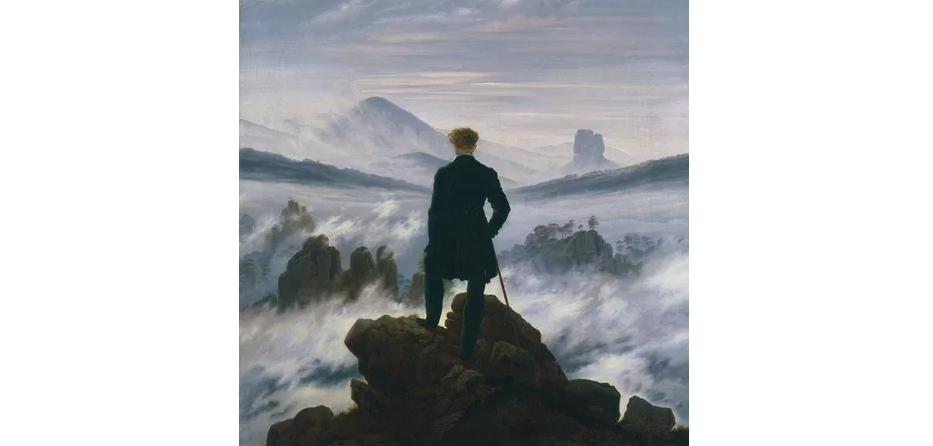
Caspar David Friedrich, 'Wanderer Above the Sea of Fog', 1818
The quintessential Romantic painter, whose work often graces the cover of books on the Romantic movement, is the German Caspar David Friedrich (1774-1840). And perhaps he, (though he may very well have seen Chinese paintings as well) more than any painter of his age, best conveys Japanese aesthetic qualities and imagery of the kind found in 1) Japanese style suiboku-ga, or charcoal based brush painting of the sansui or 'mountain and water' genre originating in China though evolving in Japan with characteristics of its own; 2) yamato-e, the rich and colorful style of Japanese byobu screen painting; and 3) print imagery in illustrated books, known as e-hon.
Let us first look at Friedrich's 'suiboku-ga-like' qualities. His famous 'Wanderer Above the Sea of Fog' (1818) takes up a classic motif from suiboku art: the pensive philosopher gazing from a craggy ledge upon a vast rocky landscape. The contemplative mode, an essential part of the aesthetics of Far Eastern sansui landscapes, is captured in his work, as well as the manner of depicting misty rocky outcroppings on which the main subject stands, and which surround him. The landscape is reminiscent of Ike no Taiga (池大雅1723-1776)'s 'True View of Mount Asamayama' (浅間山真景図 c. 1760). The difference is the Western touch of humanism; the centrality and dominance of Man, bearing over nature, depicted as a large figure; while in the East he is usually depicted as a minute figure embedded harmoniously into the scene.
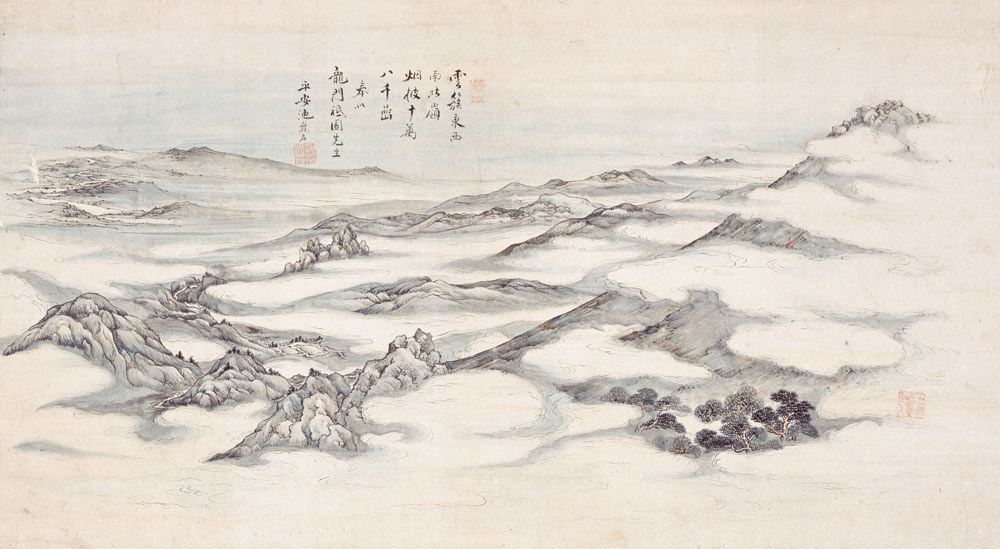
Ike no Taiga, 'True View of Mount Asamayama' (浅間山真景図), c. 1760
Another picture also highly reminiscent of suiboku-ga, in terms of technique and atmosphere, in the Ike no Taiga style of 'Tounhito-zu' (騰雲飛濤図 meaning something like 'Lifting Clouds Billowing in Flight') is Friedrich’s 'Morning Mist in the Mountains' (1808 shown at the end of this page), the difference being that while the large, empty spaces, mostly blank and untouched, with ever so faint splashes of charcoal mixed water here and there, are instead painted in, filled in with whites and greys---the only solution in oil painting for creating a similar effect. So too, does his 'Morning' (c.1820 at the Landesmuseum in Hanover). The small, flat boat, with a tiny hatted figure, poking the shallow waters (surrounded by sticks protruding out of the water), all in a misty landscape, is analogous to a very common, classic boat scene in Chinese and Japanese painting.
Friedrich follows the specific shapes of rock formations that exist primarily in suibokuga painting that are rarely found in the natural environment, except in particular parts of the world. A prime example is his 'Rocky Landscape in the Elbe Sandstone Mountains' (Felsenlandschaft im Elbsandsteingebirge, 1822-23) shown below to the right. Next to it is Uragami Gyokudo (浦上玉堂 1745-1820)'s 'Half the Sky is Misty Rain' (半空煙雨図 1813) one of Gyokudo's many depictions of landscapes with peaks of surreal and bizarre shape; and below is a drawing by Wu Bin (吳彬 c. 1543-1626) from his 'Ten Views of a Fantastic (Lingbi) Rock' (1610), a handscroll devoted to depicting one rock from 10 different angles. Painting rocks of complex shape was a favorite subject of Chinese artists from the earliest of times, seen even in the rich colored Tang Dynasty era landscapes (e.g. 'Ming-Huang's Journey to Shu', c. 10th century), and came to form a major genre of its own practiced in all of East Asia. To look at this particular painting by Friedrich, unusual for him and Europe, and ignore the existence of this great Asian tradition standing behind him, is all but unreasonable, to say the least. Indeed, most of the picture conforms to 'Mountain and Water' (sansui) painting conventions, from the depiction of small trees on the top the peaks to the foreground tree roots in the ravine below.
Traditional suibokuga style painting does not explain, of course, all of Friedrich's creations. Byobu screen painting in the yamato-e (大和絵) style, strikingly different in its effect from sumi-e and suiboku-ga, in its brilliance and scale, can also be sensed in his works. His 'River Landscape at Night' (Flusslandschaft bei Nacht c. 1830-35) reminds one of hundreds of byobu screen paintings of Mount Fuji, as well as paintings and prints of that mountain by Hokusai and Hiroshige. On the other hand, his 'Raven Tree' (c.1822) at the Louvre, exhibits the classic, amplified sideways extending barren branches set on a background of warm and light oranges and purplish hues, "evoking the consolations of beauty in a transient world" (commentary on the painting by Helmut Borsch-Supan in Caspar David Friedrich, 1990)---why, that in a nutshell is the heart of Japanese aesthetics, of haiku poetry colored by a Buddhist world-view from Heian times.
Below is Tawaraya Sotatsu (俵屋 宗達 c. 1570–1640)'s 'Narrow Road of Ivy Byobu' (蔦の細道図屏風 early 17th century, attributed to Sotatsu) at Sokoku-ji Temple in Kyoto and Friedrich's 'Hill and Ploughed Field' (1824). The clear delineated divisions of color with gentle curving masses and multiple lines horizontally running across the entire picture is employed by Friedrich in his painting, a compositional and chromatic approach that is very different from suibokuga and very much part of the yamato-e tradition, from which the famous Rimpa School, with its origins in the aesthetics of Honami Koetsu (本阿 弥光悦 1558-1637) would flourish in the following centuries. Another painting of Friedrich's that may have found inspiration in yamato-e painting is his 'Abend' (1824), which is primarily a rich orange sky with a thin layer of ground running along the bottom of the canvas. This too, is a variation of the same byobu painting approach (examples of which this author has seen, but unfortunately cannot find an appropriate one at the moment), where the sky is usually gold, as in Sotatsu's painting below, but not necessarily uniform, sometimes with whites and silver mixed in.
Tawaraya Sotatsu, 'Narrow Road of Ivy', 17th century

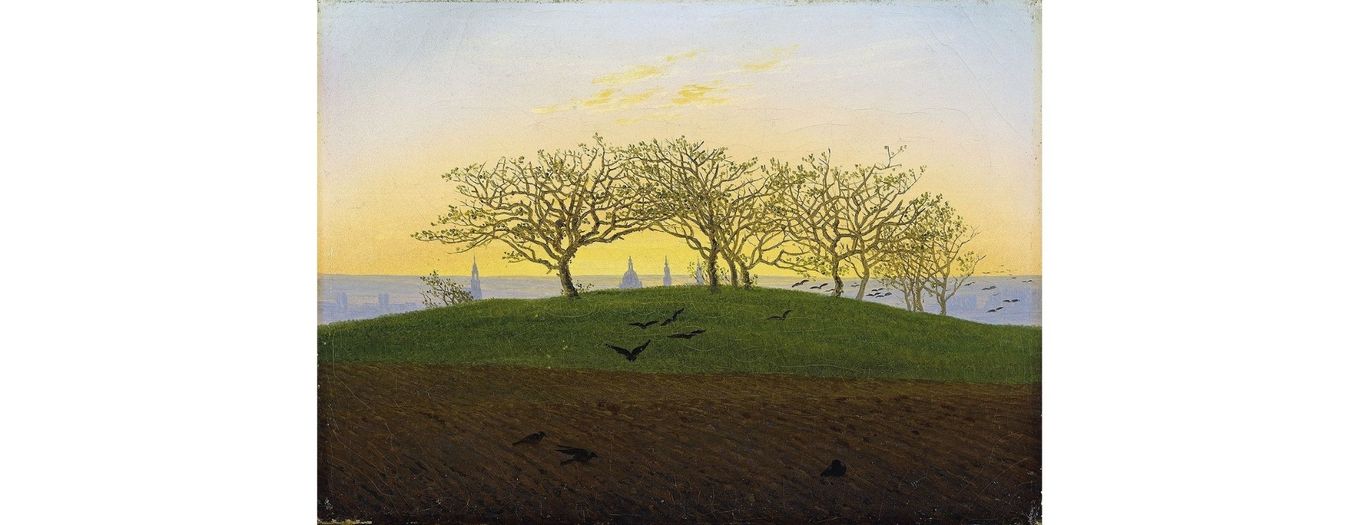
Caspar David Friedrich, Hill and Ploughed Field, 1824
On the other hand, his handling of trees in terms of color, composition, and tone in his 'Winter Landscape' (1811), 'The Snow-bound Hut' (c.1826-27), and 'Oak Tree in the Snow' (c.1829), is more reminiscent of monochrome sumi-e or black, white and sometimes gold winter paintings, whether on fusuma sliding doors, scrolls, or byobu screens such as Katsu Jagyoku (葛蛇玉 1735-1780)'s 'Crows and Plum Tree, Rabbits and Pine Trees in Snow' (1774), done in ink and white pigment, or Maruyama Ohkyo (円山応挙 1733-1795)'s 'Plum Trees in the Snow' (雪梅図襖 1785) sumi ink painted on fusuma doors, among a host of others.

Katsu Jagyoku, Secchu Matsu ni Usagi / Ume ni Karasu-zu Byobu (雪中松に兎・梅に鴉図屏風 Price Collection), 1774
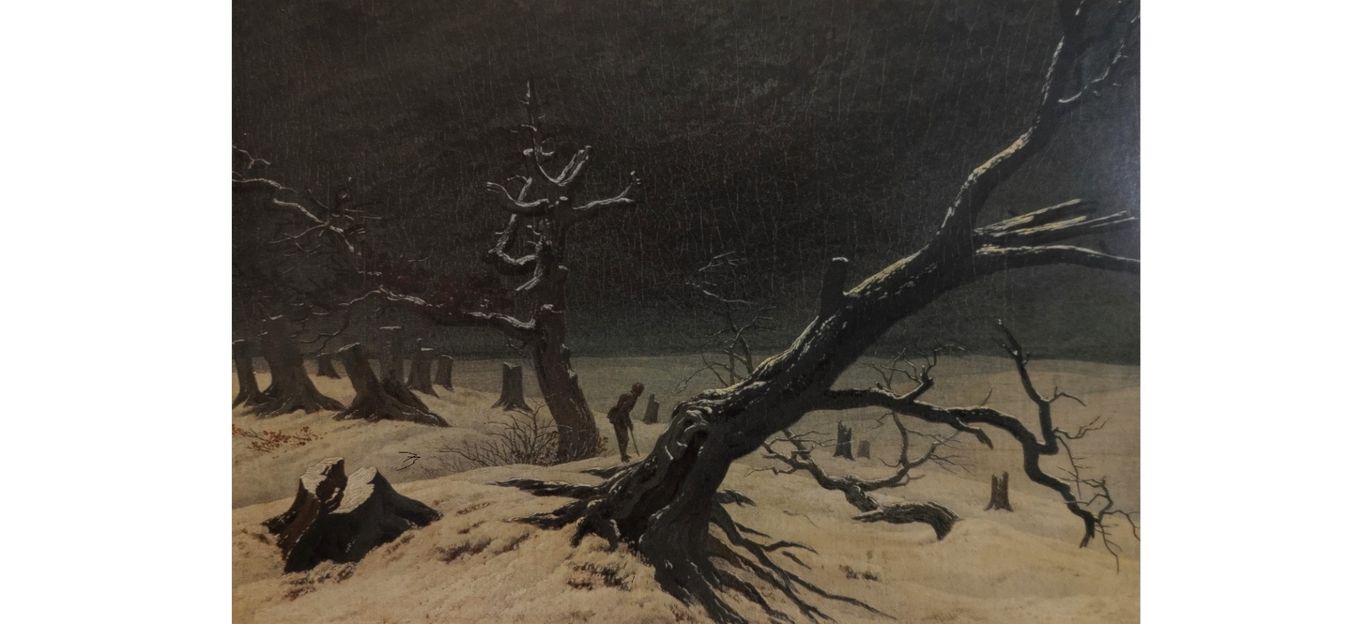
Caspar David Friedrich, Winter Landscape, 1811
Another painting of Friedrich’s which strongly evokes the byobu art of Japan is his 'Man and Woman Contemplating the Moon' (c.1830-35), with a round, gold moon, low on the horizon, framed with large boulders and a tree whose prominent roots and whose sideways extending forms are so emulative of yamato-e sansui and kacho-ga compositions. We should not forget that until then, the whole idea of the moon as an object of aesthetic contemplation was something unusual in the West, where the moon was associated primarily with foreboding, fear, or evil; and yet it ('otsuki-san') has always been an object of endearment and aesthetic appreciation in Japan, found in some of its oldest works of painting. Likewise is Friedrich's 'Swans in the Rushes' (c.1820),---here too, is a classic Japanese byobu screen image of the kacho-ga (花鳥画) type, with fowls in the rushes and a low set moon. A painting that was lost, a tondo (i.e. a work in circular format), had an owl in flight against a full moon, which also sounds very much like a Japanese inspired motif, though unfortunately we shall never know.
A distinctive set of Friedrich paintings worth mentioning are his 'rainbow' pictures, such as his 'Landscape with a Rainbow' (c. 1810) or his 'Mountain Landscape with Rainbow' (c. 1810), where an extremely clear arc cuts across the picture. These echo countless similar compositions of Japanese paintings and prints of Mount Fuji or other landscapes. The Japanese versions either depict a rainbow, like Friedrich (e.g. Shohaku's 'Mount Fuji and Miho no Matsubara', Powers Collection, Denver), or a similarly shaped great arc cutting across the picture plane due to it being done in the senmen (扇面) folding fan form (e.g. the 'Meikousenpu' 名公扇譜 from the book of collected illustrations known as the Hasshugafu 八種画譜; originally from Ming China at which time the Japanese folding fan shape was popularized; it was republished in Japan by Touhonya Seibei 唐本屋清兵衛 in 1671, becoming more widely available).
Finally we should add that there are several paintings of Friedrich's from the late 1810's and early 1820's that reveal distinct parallels with ukiyo-e print or ehon picture book compositions. Most striking is his 'On the Sailing Boat' (c. 1818), with its tilted mast in the foreground, from top to bottom, accentuating the two figures beyond to the left of it, and creating a greater sense of 3 dimensionality and a sense of being there, i.e. of vicarious experience. It is a typical compositional technique of Japanese prints and illustrated books, which many artists employed, among whom Cho Gessho (張月樵 1765/1772-1832) was wonderfully adept at; as in his picture of a fox and rice sheaves (Zoku Koya Bunko 続姑射文庫 1798) or of a sumo tournament at a Shinto shrine (Fukei Gaso 不形画藪 1817). Friedrich's 'Woman at the Window' (1822) of a woman with her back to the viewer looking out of a window, is also a common ukiyo-e image, though unlike Friedrich's small window, it is usually a house balcony or bridge from which the subject looks out to a more open landscape. Another work of Friedrich's, Woman in front of the Setting Sun (c. 1818), uses the Japanese technique of clearly delineated beams of gradually widening light, emanating from the back of Mount Fuji, or from a person or deity like the goddess Amaterasu. Indeed, there are so many of Friedrich's paintings that hark back to distinctly recognizable Japanese or Chinese images, of which we have considered a few.

Maruyama Ohkyo (円山応挙 1733-1795) 'Cracked Ice' (c. 1780) at the British Museum. Perhaps it was byobu screen paintings such as this, possessed of a strikingly modern originality, that contributed to Friedrich's compositions such as his 'Arctic Shipwreck' (c. 1823-1824). As in the case of Friedrich's 'Wanderer above the Sea of Fog' (1818) and the 'True View of Mount Asamayama' by Ike no Taiga discussed earlier, it appears that he often took the setting of his scenes from large Japanese paintings (or landscapes from prints), placing his main subject centrally upon them. Of course there are exceptions; his 'Picture in Remembrance of Johann Emanuel Bremer' (1817) evokes the style of Kusumi Morikage (久隅守景 )'s 'Yugao-dana Noryo-zu byobu' (夕顔棚納涼図屏風 17th century), but without the central figures in Morikage's painting; in fact, in Friedrich's painting there are no human subjects.
It was probably in part due to the impetus of Friedrich's landscapes, that Carl Friedrich Lessing and Johann Wilhelm Schirmer (1807-1863), a key figure of the Dusseldorf School, founded the 'Landschaftlicher Componirverein' society of landscape painting in 1827, with Schirmer teaching the first landscape painting class at the Düsseldorf Academy of Art in 1829.
Many of Schirmer's landscape paintings contain sansui (山水, literally 'mountain and water' landscape) compositions and forms, which in contrast to Friedrich, lean more towards classic Chinese suiboku-ga styles, though similar Japanese examples are plentiful as well. His 'Das Wetterhorn' (1838), while being a richly colored oil painting, reveals many elements of sansui pictures in their usual order, with only the snowy, shining mountain crest distracting us from its otherwise fundamentally Oriental composition. But it is in his sketches in pencil or watercolor that show the greatest affinity to the East in terms of shapes and feeling. His monochomatic watercolor ‘Felsige Gebirgslandschaft mit Wildbach und zu Tal gehendem Jäger mit seinen Hund' (undated, probably 1830's or 40's) is even more so in the ‘mountain and water' tradition than his Das Wetterhorn, as revealed in the eccentric shape of the rocky craig and the fallen and bent tree trunk framing the tiny solitary figure, reminiscent of Qing Dynasty artist Shi Tao (石濤 1642–1707)'s 'Old Gnarled Pine in the Mist' (細雨虬松図). Another of Schirmer’s pictures, which mirrors the typical suibokuga image of the dominating rocky mass almost completely fillling the picture, and with the typical sansui type of ominous overhanging rock element, is his ‘Der Barmhezige Samariter findet den Reisenden in einer Felsenschlucht' (1850).
Not only in Schirmer's depiction of rock formations, but also in his imagery of thick forests and individual trees with their leafless branches, he employs the forms of the sansui painting tradition. At times his trees mirror those of Friedrich, as in his ‘Winterliche Waldlandschaft mit Abendstimmung in winter' (undated, private collection); while at other times, as his 'Studie eines entwurzelten Baums' (1842, private collection) done in pencil on paper, seems to faithfully follow the Yuan (Mongol) Dynasty era painter Zhu Dern (朱徳潤)'s 'Primordial Chaos' (渾淪図巻 c.1349), with its wildly twisting branches reaching out in all directions (although in its depressively sharp, thin thorn-like bare branches, bent at extreme and extending at varied angles it is more close in form perhaps to Japanese painters as Goshun 呉春 1752-1811, among others, for that sort of thorny starkness was a favorite theme in sumi painting). Another painter of the same era in China, Ni San (倪瓚 1301-1374), painted 'The Jung-hsi Studio' (容膝斎図), a work which reverberates consonantly with Schirmer's sketch ‘Gebirgspartie mit Ruinen auf den Bergen, vorn ein Wasser mit einigen Hütten' (undated).
Schirmer often employs in his vegetal depictions the picture cropping, zooming, and massing techniques of sumi-e painting and at times ukiyo-e prints as well. There are many examples one could raise (e.g., ‘Waldpartie mit einer Eiche und Farnkraut', undated, probably in the 1830's or 40's; 'Via Mala, oben die steinerne Brücke, undated; 'Forest landscape', 1832; ‘Waldinneres, unten rechts zwei karikierte männliche Profilköpfe', 1835; and one among his ‘Park landscape' series, 1849, private collection).
Lastly, a Schirmer boat scene with three, hatted fishermen and their net, 'Waldsee, von dessen Ufer ein Kahn mit drei Männern ablegt' (undated), reflects, even more so than Friedrich's boat scene discussed earlier, the spirit of Eastern scenes of shallow fishing boats with hatted figures, casting their nets or holding their fishing poles, or sticking their push poles in the water.
The Swiss Romantic artist, Alexandre Calame (1810-1864) also conveys the distinct impression of being familiar with sumi-e painting of the sansui genre. Calame is known to have traveled to Holland, visiting Amsterdam and The Hague in the summer of 1838; though whether he visited the Royal Cabinet of Rarities or Dirk Boer's Japanese store is unknown to this author. But his monochrome sketches such as ‘Forets et Montagnes’ (1830–64 Graphite heightened with white) and his ‘Three Goats in a Mountainous Landscape’(1830–64 Black chalk heightened) are so analogous to sansui in terms of composition and forms, for instance to that of Yosa Buson (与謝蕪村 1716-1784)'s 'Lonely Deer in a Cold Thicket' (寒林孤鹿図 1779) or similar pictures by Aoki Mokubei (青木木米 1767-1833) or any number of bunjinga painters, that one cannot but receive a strong sense of conviction regarding an oriental connection here.
Observe in the two pictures below, the same classic zig zag pattern of composition, starting within a steep gorge from a base of boulders in the foreground with trees, the eye being led up leftward in a similar angle, then upwards towards the right at a somewhat more vertical angle in mid-section, finally snaking up in a similar shape towards the mountain top; though in the case of Calame the gentle ridge line of Buson becomes a river crevice, and the deer is replaced by goats.
Much the same can be said about certain other Calame paintings which follow classic sansui compositional formats, such as his 'Landscape: river-valley with rocks in the mountains' (1835 at the Louvre) with its monolithic rock surface and shallow stream below, and misty crags just behind, all in a vertically long format, following in the tradition of the Song Dynasty painter Fan Kuan (范寛 c.950-c.1032); while his monochrome brush and wash on paper, 'Baumbestandene Bachlandschaft' (1840) can be rated as an example of his version of the Japanese bunjinga style.
Thus an area for future research is the possible influence of suiboku-ga and yamato-e painting among not only well-known, but we should add, lesser-known artists of the early 19th century. Indeed, it is often the lesser-known artists who more openly borrow compositions and techniques from the East, as well as from fellow Europeans, and thus make it easier to recognize and confirm the existence of such relationships.
British Suiboku-ga Type Effects---Those Beginnings in Watercolor Transmitted to Oil Painting
The idea of Far Eastern influence upon English painting in the early 19th century, especially in regards to JMW Turner (1775 – 1851), has been treated as if it were an inviolable taboo in art history and criticism. Yet if we were to take a close look at the artistic evidence in the years preceeding him or during his youth, such as in the works of Alexander Cozens (1717-1786) and his monochrome acquatints and 'ink-blot landscapes' to those of Francis Towne (c.1740–1816), a popular watercolor painter of densely forested landscapes, as well as the anonymous illustrations in William Gilpin's book on the picturesque and the Gainsborough painting discussed in the previous 'volume' on this website, we would see a pattern of relationships that existed between Far Eastern brush painting techniques and watercolor painting arising in Britain in the 1770's and 80's, and how from there those aesthetic sensibilities were conveyed to oil painting as seen in the works of Turner from the 1790's on into the 19th century.
That is, before discussing Turner, we must step back to the morning twilight of the Intermediate Period, to the 1780's, when novel images of landscapes, unrelated to past native traditions started to arise in Britain. In particular, Alexander Cozens' A New Method of Assisting the Invention in Drawing Original Composition of Landscape, published in 1786, contains some unusual plates of an unseen nature until then; and which strongly reminds one of suiboku-ga teaching manuals that had been widely circulating in Japan. Did he get his hands on a copy, or have a chance to observe one at a museum, one or two, such as Tachibana Morikuni (橘守国 1679-1748)’s E-hon Oshukubai (絵本鶯宿梅 1740; vol. 6 with its varied rock formations) or his The Moving Brush in Rough Painting (Umpitsu Soga 運筆麁画 1749); or So Shiseki (宋紫石 1712-1786)‘s Thicket of Ancient and Modern Pictures, Sequel (Kokon Gaso, Kohen 古今画薮 後編 1769-71); or Wang Gai (王概 c. 1662-1722)'s Mustard Seed Garden Manual of Painting (Jie zi yuan hua zhuan 芥子園畫傳), which, though first produced in China in 1679, was reprinted and widely distributed from the mid-1700's in Japan? All these contain mulitple images similar to those in Cozen's book, which, if we were to describe in sumi-e(ink wash painting) terminology, we might say they tend mainly towards shoboku (焦墨), or the 'concentrated charcoal' style, done with less water to the sumi-ink, thus resulting in very dark brushstrokes; though there are very lightly colored images too, perhaps echoing the sensen (渲染) style of rendering, or what might be translated as 'dyed gradations'.
Whatever the case, Cozen's Plate 9 in his A New Method is much like an example of elementary 'shunpo' (皴法) or brushstroke technique for drawing rocks that are found in Japanese and Chinese painting manuals, as well as is Plate 37, with rock morphology and texturing reminiscent of 'ken-un-shun' (巻雲皴) or ‘coiled-cloud texturing’. His Plate 15 is a step higher, of intermediate complexity and completion. It demonstrates a mix of something similar to the 'fuheki-shun' (斧劈皴) technique, translated as ‘axe-cut texturing’ (but perhaps better understood as an ‘axe-battering’ or ‘reiterated chopping’ type of texturing) applied to his standing rock formations, and elsewhere, for the flat rocks below, a different type of texturing, reminiscent somewhat of settai-shun (折帯皴), translated as 'folded sash' or otherwise as ‘broken-band texturing’ (we have used the Japanese pronunciations for these terms, but it goes without saying these Chinese words are pronounced differently in Chinese).
Finally, Cozen's Plate 40, of a mountain landscape, seems to give away the Zen-like, Eastern connection completely, with its audacious ink-splattering hatsuboku (潑墨) brushwork, combined with fine, faint marks which remind one of 'uten-shun' (雨点皴) or ‘raindrop texturing’. It is, at least, a brave attempt to achieve an effect that had already been mastered in China and Japan by the likes of the 15th century painter Sesshu Toyo (雪舟等楊 1420-1506); and carried on in unbroken continuity by generations of e-shi (絵師 the ancient appellation for professional painter) up to Cozen’s time; and while Cozen may have been unique in Europe making such experimental pictures, a multitude of his artistic contemporaries in Japan, China, as well as in Korea, both professional and amateur, were in fact doing something similar.
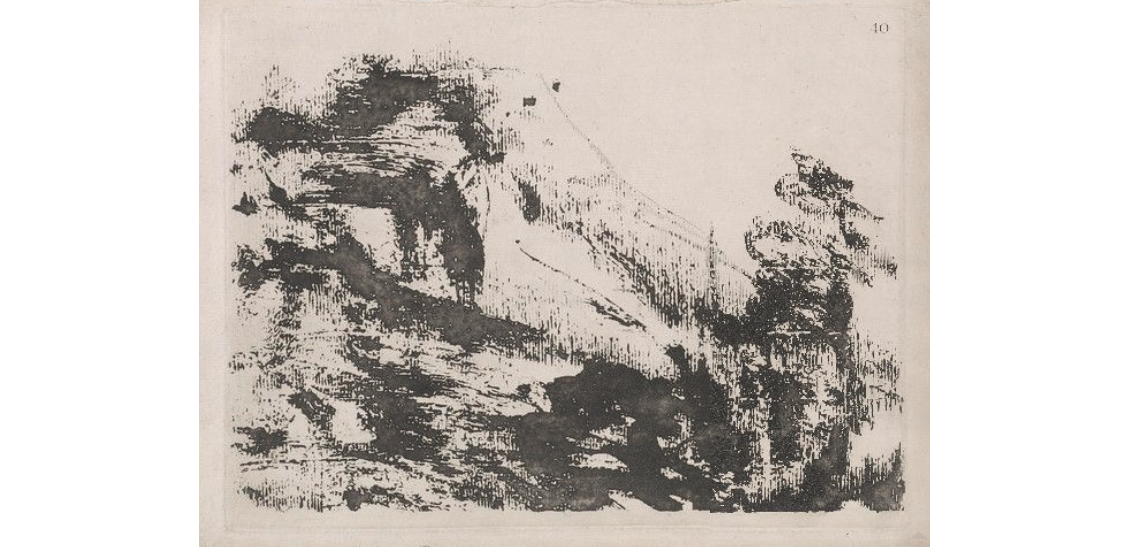
Alexander Cozens, Plate 40
One last interesting clue is what Cozen' proposes as as his own creative idea: crumpling up a sheet of paper, smoothing it, then thinking of a landscape, and blotting it with ink. But why, that is nothing other than 'momi-gami' (揉み紙), the traditional 'massaging paper' technique, used in suiboku-ga painting!
As for Turner's works, the parallels with Eastern painting are also striking, and it is curious that those shared attributes are not discussed more openly from the point of view of comparative art appreciation, or in the context of evolutionary trends in world art in art history surveys. His 'The Angler' (1794) is rather astonishing for anyone familiar with pictures of the sansui type harking back to the rich carpet of leaves and colors in Wang Meng (王蒙 1308-1385), active during the late Yuan Dynasty period in China. Not so much in the specific depictions of human or natural subjects; it is more the overall impression one receives upon seeing it for the first time. Turner’s ‘Morning amongst the Coniston Fells' (1798), however, is much more along the lines of older, Southern Song Dynasty suibokuga in its extremely thick, heavy and dark atmospherics and texturing. Another of his paintings, done in graphite and watercolor, ‘A Bay on a Rocky Coast, with a Man Running’ (1792-93, shown at the beginning of this section) is also a classic 'mountain and water' (sansui) composition, more light and airy similar to bunjinga works. Especially the shapes and texturing of the rocky coast stand out as being in the classic sansui style. If one looks at the crest of his highest peaks, one can observe his faint suggestion of the suibokuga technique known as 'fuheki-shun', mentioned above, in the parallel lines near the top.
Turner's ‘Light and Colour (Goethe’s Theory) The Morning after the Deluge – Moses Writing the Book of Genesis’ (1843), is rather esoteric and mystical in impression; might one say almost a colorized version of Shugetsu Tokan (秋月等観 1440?-1529; e.g. Hatsuboku landscape, Cleveland Museum) or Sesshu’s work (e.g. 'Hatsuboku sansui-zu' 溌墨山水図, Nezu Museum) or other semi-abstract hatsuboku style paintings with a circular enso (円相) form, emphasizing the philosophical void in the unpainted spaces? The ‘atmospherics’ of Turner at times recalls the images of dragons swirling in clouds on kakejiku scrolls or huge billowing flames in medieval emaki paintings; or otherwise dramatic imagery in Edo period ehon picture-books, where in fact swirling, radiating, or exploding elements---"rain, steam, and speed", if you will---were extremely popular. For Japan was a country prone to severe earthquakes and volcanic eruptions, possessing a range of changing cold and hot climates; all these were favorite topics of print artists---that is the expression of primal, untamed energy---or to use a Turner title again, the energy of "snowstorm, avalanche, and thunderstorm".
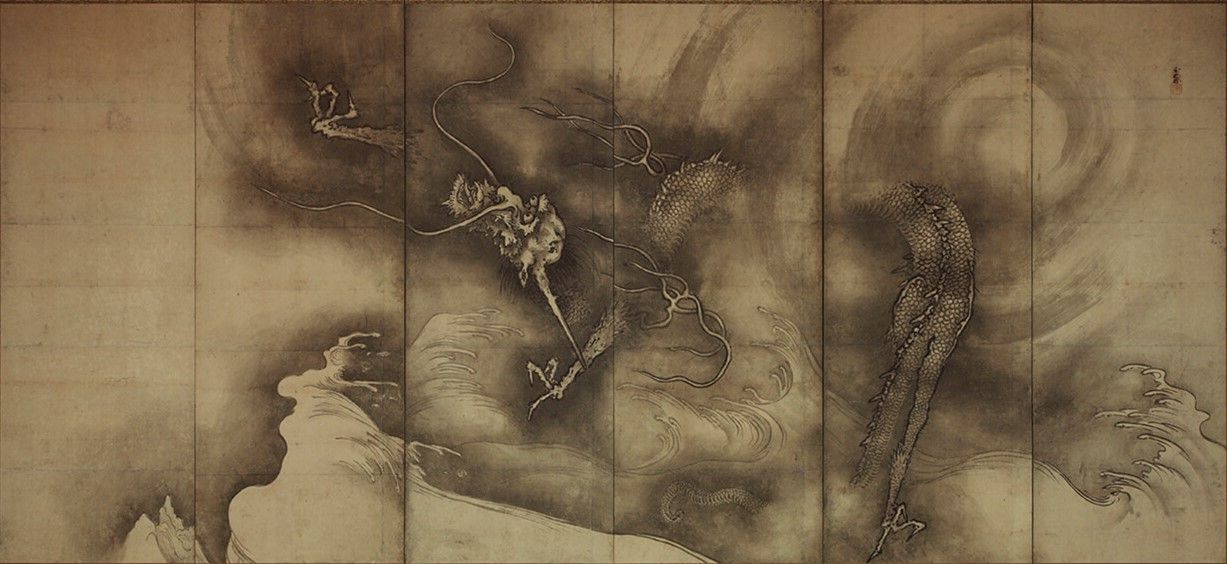
Sesson Shukei (雪村周継 1504-1589, 'Ryuko-zu byobu' (竜虎図屏風), c. 1550, right side of a pair of folding screens (Cleveland Museum of Art)
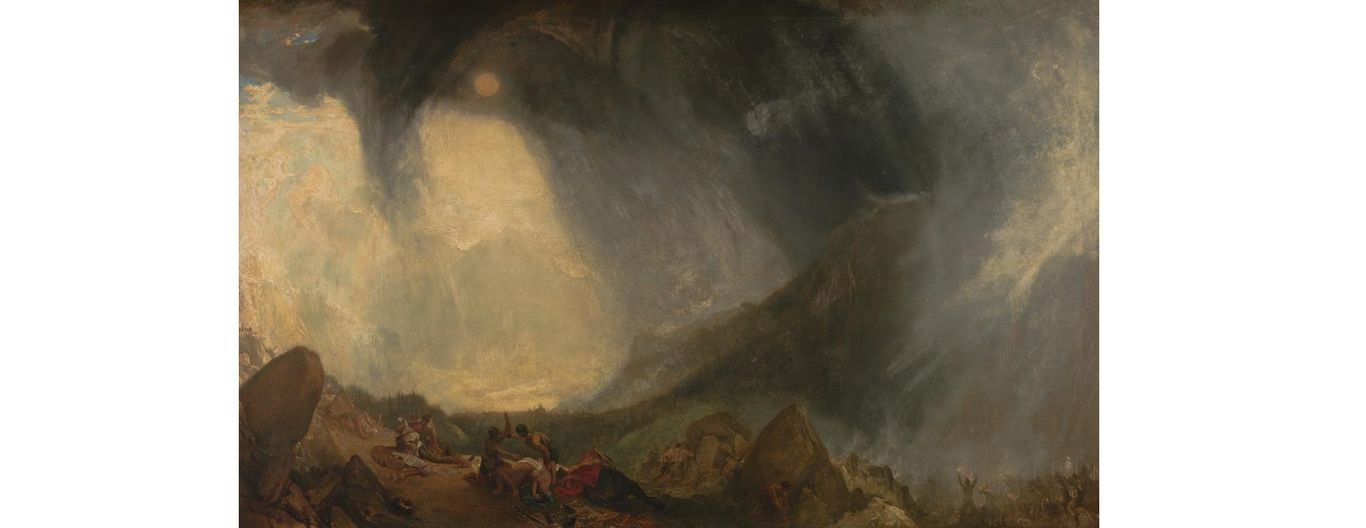
JMW Turner, 'Snow Storm: Hannibal and his Army Crossing the Alps', 1812 (Tate)
At other times Turner's atmosphere shares something in common with the blanketing, slow moving air of Yosa Buson (mentioned earlier) or the heavy, portent mists and ominously still air of Uragami Gyokudo (浦上玉堂 1745-1820 mentioned earlier); and elsewhere with the minimalist style of Hasegawa Tohaku (長谷川等伯 1539-1610), exemplified in his renown 'Shorin-zu byobu' (松林図屏風 late 16th century), with its ineffable, reassuring quietude. It is to Turner's credit that he may be called a kindred spirit to several of these masters, despite his occasional veering towards the melodramatic.
His blending or merging of the elements of air, water, earth, and light, almost a recycling, is much like latter Muromachi period masterpieces by urban professional painters, for instance the 'Jitsugetsu sansui-zu byobu' (日月山水図屏風 16th century, Tokyo National Museum A-1065, not to be confused with other byobu screens of the same name) shown below.
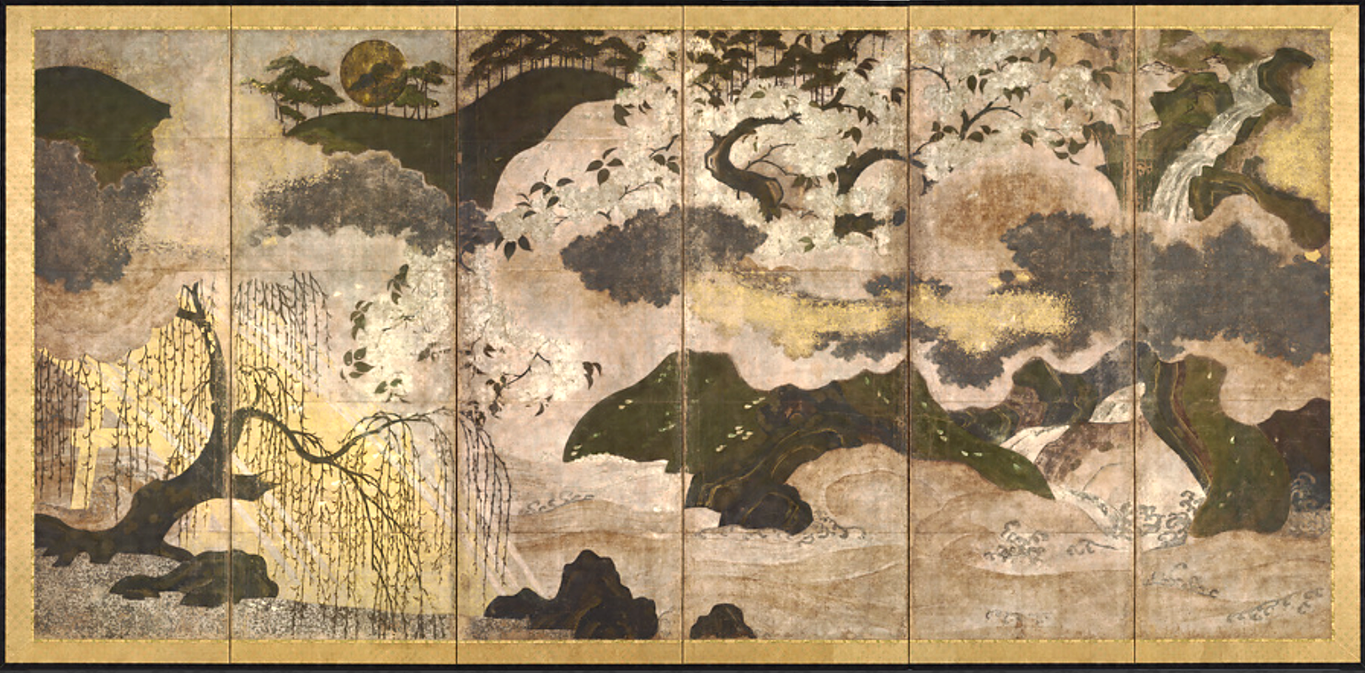
Jitsugetsu sansui-zu byobu (日月山水図屏風) 16th century (Tokyo National Museum A-1065)
Note how the turbulent waters in the above byobu are akin to the turbulent clouds in Turner's painting below, 'A Disaster at Sea' (c.1835); how the dark scattered rocks and land forms which the waters weave about correspond to the dark, still skies interspersed with clouds in Turner; how the clouds made of gold dust in the byobu remind one of the bright golden glitter in Turner's sky; and how the byobu's wooden bridge, visible through the willow's branches---a reminder of the modesty of human constructions that intrude upon nature---are portrayed as even more frail against the elements in Turner's wrecked ship, visible through the waves. The interactional nature of the compositional elements, their sense of mixing, and the shapes they take on, though materialistically different, share much in common aesthetically. Turner's glitter in his skies is not so unlike the chigiri-haku (ちぎり箔), the 'torn gold-leaf piece' scatterings and sand-like sprinkled sunago (砂子) in yamato-e painting; or for that matter, even in soshoku-kyo (装飾経), that is decorated Buddhist sutras, which often have richly mixed colors and precious metals as backdrops to text. We are not saying that Turner necessarily saw this particular byobu screen; but for every byobu image we see here, there are always more like it; and many in museums and private collections in Europe.
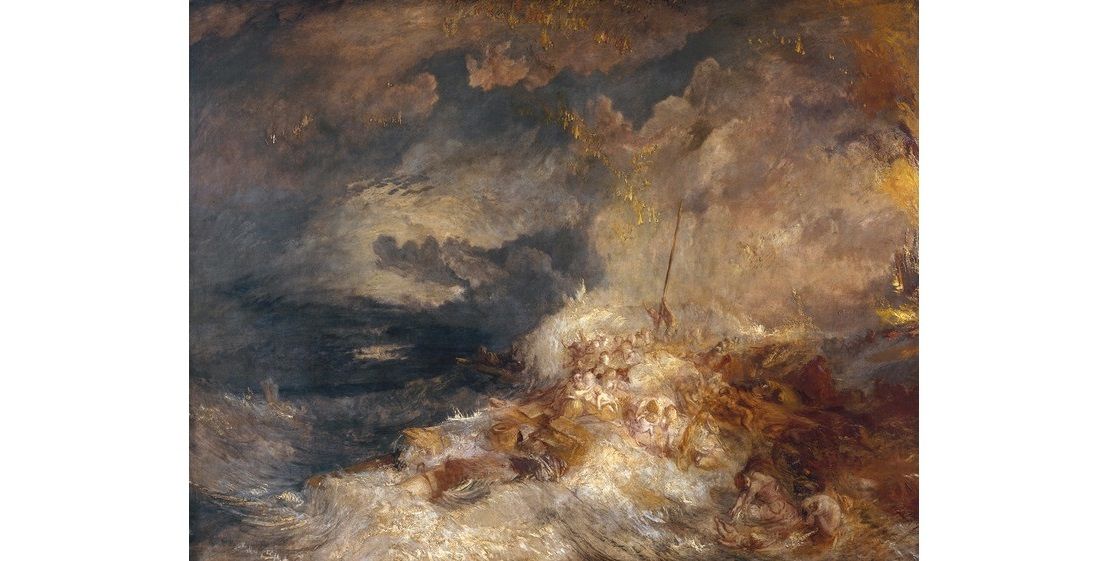
JMW Turner, 'A Disaster at Sea', c.1835 (Tate)
Various comparisons between Turner and Japanese chromatic and compositional sensibilities could be made. The following juxtaposes Turner's famous ‘Light and Colour (Goethe’s Theory) The Morning after the Deluge – Moses Writing the Book of Genesis’ (1843) not with sumi-e painting as dicussed earlier, but with an image from a Buddhist sutra, the famous Heike Nokyo (平家納経, c. 1146) of the Heike samurai clan. In one, Moses writes the Book of Genesis; in the other, a bodhisattva meditates in front of a desk with a sutra. The light of the sublime engulfs both who appear indistinct. If in Turner the tilted brazen serpent in the center represents "Christ's redemption of Man in the New Covenant"(from the Tate Gallery label); the tree leaning in the other perhaps symbolizes the enlighment of Buddha and through him the redemption of Man. Again, Turner did not see this particular sutra kept in Itsukushima Shrine in Japan; but the Heike Nokyo is an example of how colors and forms mix and mingle in a manner characteristic of yamato-e aesthetics, found in later religious and secular artworks.
We have discussed but a few of Turner's paintings which reflect a possible exposure to either, or both, Japanese and Chinese images. In general, it may be said that his fast painting over large areas, his oft-employed techniques of 'layering' (sekiboku-ho 積墨法 layering and ura-zaishiki 裏彩色 'back side of paper coloring') and 'wet on wet' (shita-nuri 下塗り and tarashikomi 垂らし込み or 'spilling into') and the effects they produce, also recall suiboku-ga and yamato-e painting techniques using a fude brush. Naturally, the brushes available to Turner were different, and what was done in charcoal (often mixed with a variety of elements unique to East Asia or Japan) and water in the East, became graphite and water instead, or watercolor paints and pastels. There is a legend that Turner used bread or other materials to paint on occasion. If so, that would be like the Japanese hikizome (引き染め) technique using fabric (布帛) or a bristle brush known as a hake (刷毛) to spread and let the ink dye into the paper. Even one of Turner’s signatures is reminiscent of a Japanese kao (花押), a particular kind of Japanese signature, also used by Japanese artists when signing paintings. His early interest in watercolors and printmaking media also dovetails with many latter 19th century European artists who were influenced by japonisme, namely printmaking and watercolors.
JMW Turner, pages from the Channel Sketch Book, 1845
Regardless whether or not there was a direct connection between Turner and Eastern art, if one were to simply rank European painters by their proximity to richly chromatic yamato-e imagery and the hatsuboku type of sumi-e and suibokuga, creating bokashi (暈し) mokkotsu (木骨) and kappitsu (渇筆) effects (that is creating images without outlines or by blurring outlines, resulting in merging or indistinct or ethereal impressions), Turner must be among those appearing at the head of the list. It seems odd that, while an artist like Claude Monet, producing works such as 'Impression---Sunrise' can be understood to have been influenced by Japanese art, Turner, who preceded him in producing works akin to it, cannot possibly be considered being influenced so as well. The missing link is sumi-e brushwork and suiboku-ga, whose absence in the discourse of late 18th and early 19th century painting in Western art history is due to a lack of knowledge of, or a lack of desire to become familiar with, this philosophically engaging and aesthetically alluring tradition of the East.
There are certain peculiar compositions of Turner which also suggest that he had seen Japanese paintings or prints such as those of Hokusai. Of particular interest is Turner's 'The Evening of the Deluge' (c.1843). It exhibits an analogous composition to a classic Japanese image sometimes called a chidori-zu (千鳥図) with a train of plovers in the sky, but also at times other birds in evening flight, leading from mountain or island far off, making big 'S' like patterns. Usually there is a body of water in the mid-ground, and some human interest in the foreground, in the case of prints.
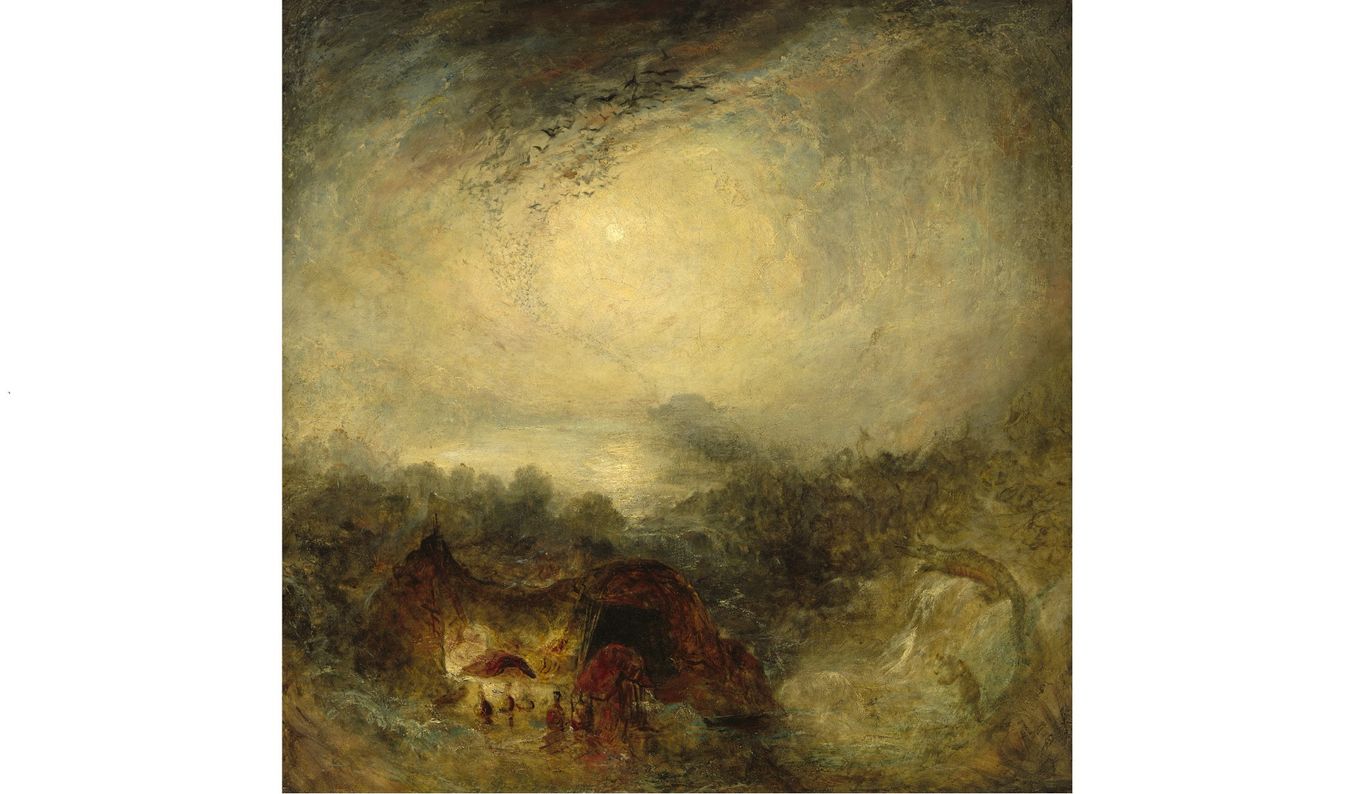
JMW Turner, 'The Evening of the Deluge', c.1843 (National Gallery of Art)
Regarding the situation in Britain, we should mention another painter that may shed light on this situation: Turner's contemporary, John Martin (1789–1854), who was just as celebrated in his own time. Martin's vast, fantastic landscapes such as in ‘The Bard’ (c. 1817), which emphasize the vertical dimension, are peopled with small figures placed on opposing banks with the focus upon one transcendent character. These characteristics, and the pronounced emphasis on the morphology of mountain rocks, as well as the sense of beholding a vision of the sublime, all parallel (excepting of course, the specific religious themes) aspects of sansui-ga composition as well as artist intention in terms of the visual impressions conveyed.
And in America...
While we have focused on Europe, the influence of the East upon the Hudson River School in the United States is also an area for investigation. That influence may in large part be a case of 'indirect transmission' (a concept discussed in detail in The Japonisme Museum Newsletter on this website), meaning an influence that reached America via the apprenticeship in Europe and models of suiboku-ga style European landscape works Americans encountered over there. However, there are certain paintings, some well-known, that seem to have been based on more direct observation of Chinese or Japanese suibokuga, or are similar enough to lead one to conclude so. Asher Brown Durand (1796-1886)'s famous 'Kindred Spirits' (1849) that depicts the friendship of the founding artist of the Hudson River School, Thomas Cole (1801-1848) and the poet William Cullen Bryant (1794-1878; whose poetic imagery at times, regardless of there being any direct connection or not, is reminiscent of Hiroshige prints) overlooking the Catskill mountains shortly before Cole's death, is considered the quintessential Romantic painting done in America, and is strikingly alike in spirit and form to classic 'mountain and water' (sansui) suibokuga.
The pursuit of the individual's true self, the desire to be in touch with nature, to "play your own music; write your own poetry; paint your own personal vision of nature" ('Romanticism: A New Cultural Orientation' in Marvin Perry, et. al., 1992) and as in Durand's painting, to share the joys of nature with friends, and to place a high value on like-minded, cultivated friendship---those ideals exemplifying the Romantic spirit---why surely, these are the same ideals of the scholar-painter of East Asia, the Chinese wenrenhua / Japanese bunjinga movement, of 'Kin-Ki-Sho-Ga' (琴棋書画): Kin--Harp (music), Ki--Chess (friendship), Sho--Writing (poetry), and Ga--Pictures (painting), to be enjoyed away from the distractions of city life, deep in the mountains. They are ideals that have roots reaching far back, partially to ancient Daoist (Taoist) philosophy; a striving to be in tune with nature, to enjoy the freedom to engage in the personal search for the 'Way' (道).
The painting below to the left, at the Koto-in Temple in Kyoto since the Kamakura period, is by Li Tang (李唐 c.1050-c.1130), one of the greatest of Southern Song painters; to the right Asher Durand's 'Kindred Spirits' (Crystal Bridges Museum), which follows the classic sansui compositional format, well-established by Li Tang's time. That is, starting with a picture frame taller than wider, suitable for hanging as a scroll (掛軸); the painting itself depicts a deep canyon or ravine with sheer cliffs, a river below of which a portion is a waterfall (or sometimes two or three, though not of equal height); where two sage-like figures stand upon a jutting ledge, overlooking the ravine with the water flowing below. A large tree overhangs shading them, with its roots visible; rocks protrude nearby, and beyond there is a much taller peak, that has an asymmetrical form. The two figures represent the Chinese and Japanese scholar-painter ideal---the sharing of the joys of nature and of friendship as comrades in poetry and painting---truly they are kindred spirits, as reflected eight centuries later in Durand's painting.
Romanticism was likely shaped, in greater or lesser extent, by the landscape vision given to painters and poets in suiboku paintings and related prints, though, it should be noted, intimations of that movement could clearly be seen in the Rococo period and its lacquer panel landscape imagery that came originally from Japan, as was discussed in the previous chapter of this website. Romanticism as a ‘new’ movement was due to a self-conscious proclamation of artists breaking with the past; but in fact it owed much to trends in landscape, color, and the move to secular themes that were established by the mid-18th century, during an age of Rationalism.
The conscious opposition of ‘Rationalism' vs. 'Romanticism’ was a dichotomy, or dialectic if you will, that arose thanks to Goethe, Hegel, and other outspoken men of the time. And in the 20th century, the substantive aspects of Eastern influence were downplayed with a much heralded academic thesis of ‘Orientalism’ (Edward Said), which blithely ignored the vital contribution of both Islamic science during the middle ages and renaissance and that of the East Asian art from the 16th century onward. So much of what were fundamentally Eastern conceptions of form, subject matter, composition, aesthetics, and philosophy were simply recast, redressed, or might we say disguised, such that the reverse of what Said proposed was closer to the truth: the substance was imitated, even if not exactly, and what lay on the surface, and the technical means to achieve it, was adopted to Western tastes to become part of mainstream art that looked from the outside completely ‘Western’. Meanwhile, the blatantly Orientalist works were a secondary impact from the East, in terms of influence upon Western art and philosophy.
Fields of Investigation 2: The Japonisme of Humor, Satire, Horror, and Fantasy in Goya to Daumier
A sampling of pages from various 18th century Toba cartoon books
The Inevitable Allurement to Japanese Artistic Resources
The influence of Japanese comical and fantastic imagery upon the sudden, explosive development of caricature and cartoons from the latter 18th to early 19th centuries in Europe, of the kind seen in the drawings of James Gillray (1756–1815), Thomas Rowlandson (1757-1827), J.J. Grandville (1803-1847), Honoré Daumier (1808-1879), Edward Lear (1812-1888), Charles Amédée de Noé ('CHAM' 1818-1879), and even Francisco Goya (1746-1828), has yet to be explored.
Those possibilities go unpursued, in part due to the tendency among both Japanese and Western scholars to underestimate the true gamut and depth of pre-modern Japanese art, focusing on stereotypical images from ukiyo-e prints, despite the existence of a greater diversity of artefacts in Dutch, English, and French collections. There one finds distinctive images, products of a long cultural and artistic evolutionary process, culminating in a tradition of visual illustration that presages later images produced by European artists---yet few scholars question the origins of such imagery appearing in Europe, simply accepting the attribution to individual genius. It is, for instance, only in the 1790's that Goya starts to show those singlularly modern qualities in his art that set him apart, especially after his exile in Bordeaux, during what we have called here the Intermediate Period. There is a great contrast in his early work which is not so unlike Fragonard or Watteau, with his later works, which places him with 20th century masters. His sudden genius for compression and economy, his empty spaces and powers of suggestion, the particular forms he chose to express ideas, and his new found interest in lithography in his seventies close to the final years of his life, may be in part due to fresh sources of drawing inspiration, and not only traumatic experience.
That is to say, only a fraction of the arts of Japan are covered in japonisme research; many craft forms go unmentioned; while the quantity and scope of Japanese illustration, including those in e-hon (絵本) or ezo-shi (絵草子) books, maybe aptly described as unfathomable. Sumi-e painting with a fude brush was a much more common pastime in Japan than elsewhere, whose diffusion was closer to that of, let us say, horseback-riding in Europe. The diversity of imagery in 18th and early 19th century Japanese books, prints, and paintings is such that, without hyperbole intended, one might possibly argue it rivals all else in the world combined at the time. That includes, but is not limited to brilliantly colored narae-hon (奈良絵本) or 'Nara picture books' from the late 16th century; aka-hon (赤本) or 'red books' that arose in the first half of the 17th century; kuro-hon (黒本) or 'black books' that flourished around 1740; followed by ao-hon (青本) or 'blue books'; and the best-known kibyoshi (黄表紙) or 'yellow cover books' whose heyday was between 1775–1806; as well as gokan (合巻) or compendium works. But there were many other types of prints and illustrations, not covered in these books, some compiled in book form and others not. The following is a limited sampling of such illustration genres in circulation by the early 19th century:
moji-e (文字絵) that is playful images created with letters; hitofude-e (一筆絵), or drawings that are completed with one continuous line of the brush; monuke-e (もぬけ絵), pictures where only the person is missing, though his clothing and shoes, etc. remain, reminiscent of Well's Invisible Man; hanji-e (判じ絵), pictures that contain riddles, where one guesses words from pictures; saya-e (鞘絵 such as those in the Siebold collection) which transliterated mean 'sword-sheath pictures', distorted images as if seen on a surface of a Japanese katana sword-sheath; kinpira-e (金平絵), pictures deriving from kinpira joruri puppets; kage-e (影絵), shadow pictures revealing unsuspected and often ridiculous poses to form them; douke-e (道家絵), religious caricatures conveying moral messages; namazu-e (鯰絵), satires portraying catfish; toba-e (鳥羽絵), cartoon figures with exceedingly long, skinny legs and arms and exaggerated gestures and expressions, reminiscent of European cartoons that were to follow; otsu-e (大津絵), folkish portraits originally from the Otsu area; omocha-e (おもちゃ絵), clever 'toy pictures' that assemble all sorts of things or people into one image; haiga (俳画), impressionistic images to go with haiku; hyaki-yagyo (百鬼夜行), 'Night Parade of One Hundred Demons', hordes of monsters parading in the night, reminiscent of Grandville's parading half animal characters in his 'Les Métamorphoses du jour' or Francisco Goya's etchings and aquatints such as his 'Los Caprichos' series; hyakumen-so (百面相), absurd pictures of facial distortion; so-ga (疎画・粗画) intentionally roughly done pictures; different from sou-ga (草画) rapid or quickly done sketches capturing the essential point; ryaku-ga (略画), compact (and 'kawaii') characters much like the yuru-kyara (ゆるキャラ) of today; kyoga (狂画) 'crazy pictures' of the ridiculous or freaky akin to Goya's etchings such as those in his Witches and Old Women Album (c. 1819–23); and finally, last, but not least, the famous manga (漫画) which we cannot possibly capture here in all its diversity.
This though, leaves out many other types of creative imagery, such as unique pictures made from cloth known as oshi-e (押絵); pictures made from torn paper known as chigiri-e (ちぎり絵); 3 dimensional pictures known as tatebanko (立版古 or otherwise as kumiage-e 組上絵); kites (凧) of infinitely audacious design; paintings on shells for the game of kai-awase (貝合わせ) or karuta game cards; or wooden tablets with often idiosyncratic (unlike today's mass produced versions) and pithy images known as ema (絵馬), literally 'horse pictures' (though not at all confined to horses) that lined the walls of tens of thousands of shrines and temples across Japan.
Speaking of which, if we were to also consider a sampling of illustrated images from the myriad Shinto and Buddhist deities worshipped there, such as:
the pudgy, jolly pair of Ebisu (恵比寿) and Daikoku-ten (大黒天); crowds of wailing rakan sages (羅漢); bizarrely grimacing myo-o (明王) and their sometimes mischievous child deities called doji (童子); the 12 guardian deities of the Yakushi Buddha (十二神将) with their marvelously supple or staunchly rigid poses and contorted expressions; the ogres and other Japanese supernatural beings depicted in paintings, books, almanacs and other illustrated surimono (刷物, for in fact temples were like mini-publishing houses); and include the gently caricaturing Zen portraits and sketches called zen-ga (禅画) done by priests such as Hakuin Eikaku (白隠慧鶴1685-1768) or Sengai Gibon (仙厓義梵 1750-1837) with vigorous brushwork, who set an example for many; and if then we were to add to it all, for contrast, something from the opposite secular end of the spectrum, such as pictures from the comic sub-genre within shun-ga (春画);---then truly, there would seem to be no limit to the expressive imagery of the witty and playful or droll and slapstick, as well as the absurd and monstrous, to be found in Japan and in European collections of Japan.
Even then, if we were to tirelessly continue to pile on to it the emaki (絵巻) picture scrolls done in the colorful yamato-e style from the 11th century onward, with fanciful or at times horrifying scenes on an epic scale, or those in the monochrome hakubyo-ga (拍描画) style depicting animal parodies and other forms of amusing black and white illustration in kappazuri (合羽摺) stencils for instance, and furthermore, if we were to remember the aforementioned bunjinga with their gentle sense of literati humor (e.g. Yosa Buson's vegetable headed characters akin to those of Granville and Philipon), that would still leave out the myriad satirical, chimerical or grotesque images adorning netsuke, inro, metalwork, lacquer and pottery wares brought over from Japan that might act as a source for comic or pathetic inspiration.
Francisco Goya's Jigokudo, Gakido, and Bakemono
To take first Goya's example in more detail, in his monochrome etchings and lithographic prints, such as his 'Disasters of War' or his 'Caprichos' series, are strong parallels to be found with Japanese imagery of a particular kind yet to be mentioned, that of 'rokudo-e' (六道絵), or depictions of the six Buddhist levels of existence, originally portrayed in emaki picture scrolls and as mandalas in hanging scroll form (掛軸). These, and images derived from them, were popularized in the latter 18th century, and came to be produced as prints and book illustrations, often in monochrome.
A brief explanation of the nature of the these rokudo pictures is probably called for before discussing their relation to Goya's images. Of the six levels, or classes of existence, three are evil states, the San-akushu (三悪趣), to which sinners go: the worst being hell, or Jigokudo (地獄道); less horrifying is rebirth into the sphere of animals or vermin, Chikushodo (畜生道); and then there is the realm of Gakido (餓鬼道), rebirth as an ever 'hungry ghost', scrounging together with similar depraved creatures. These worlds provided Japanese artists with plentiful themes to express to the utmost their most terrifying and fanciful imaginings, from the Heian period onward. Ashura-do (阿修羅道), though not one of the three evil states, was one of endless battle and conflict with evil (thus not a desirable state), also provided an opportunity to express the fabulous and fantastically dramatic. Putting aside 'the way of human beings', Jindo (人道) and that of the heavens, Tendo (天道) for this discussion, it was the world of hell and hungry ghosts that were favorites, and between those two worlds especially Hell, for within each of the 8 hot or great hells (八熱地獄 or 八大地獄) that comprised Hell, there were '16 little-hells' Juroku-shojigoku (十六小地獄) or 136 little-hells to illustrate, all different in the horrors they subjected to sinners, not to mention the '8 cold hells' (八寒地獄) and their concommitant little hells (for those having read Dante's Divine Comedy, it is no coincidence that this might sound somewhat familiar; but it is beyond the purview of this site to discuss the Comedy's connection to Islamic Sufism as first elucidated by Miguel Asín Palacios, and in turn Sufism's concepts to Islam's contact with Hindu cosmology, thus sharing the same Indian roots as Buddhist visions of hell).
One of these, if we transliterate, was the 'Chicken Hell' (鶏地獄), where a flame-emitting gigantic rooster crushed and ripped apart those who were sent there, as can be faintly made out in the section of the Jigoku-zoshi (地獄草紙 late 12th century), i.e. 'Hell Scroll' shown below right. This picture scroll was a prime model for future paintings of hell and horrors in Japan. To its left is Goya's 'El buitre carnívoro' (The Carnivorous Vulture, c. 1814-20) from his 'Disasters of War' series. Among the horde of onlooking farmers, a brave man with a pitchfork drives away the giant 'vulture' which is thought to parody the French imperial eagle, beaten and sorely hurt with its wings and feathers damaged, being driven out of Spain. Thus the situation portrayed is of course completely different from that of the Hell Scroll, but the similarities go beyond the details visible here; they exist in the general repertoire of images in Goya's etchings and Japanese rokudo-e, such as the Hell Scroll and the Gaki Scroll (餓鬼草紙 late 12th century). It is not only that a giant bird with relatively short stubby wings, of fierce-some appearance, are portrayed in opposition to a crowd of dimunitive figures; this is just a hint of what lies beyond, a constellation of distinctive qualities that both share. Though not visible here, the Hell Scroll has scenes of groups being herded by ogres with pitchfork like weapons (e.g. 'Boiling Excrement Hell' 沸屎地獄), and likewise, Goya's other pictures contain aspects of the Hell Scroll of wounded or dead figures tumbling and disfigured. Goya's is a hell on earth; the rokudo-e is otherworldly and of an alien religion; yet Goya's imagery seems to have more parallels with Japanese depictions of Hell (and Gakido) than with traditional Christian ones.
Below are more scenes from the 12th century Jigoku-zoshi (Hell Scroll) and Gaki-zoshi (Hungry Ghost Scroll), to give a taste of the kind of psychological characterizations and facial expressions that appear in that genre of art in Japan.
Above, note the depraved, degenerate expressions of the hungry ghosts (1) and the sinister, gleeful expressions of the ogres (2, 3). Regard the little doll-like figures who either are already stiff corpses or glumly await their horrible fate. Compare these with Goya's pictures below, (1) with (A); (2) with (B); and (3) with (C). Again, as we have repeated before, it was not necessary for Goya to see this particular handscroll, but one like it or pictures based on it in illustrated books on Buddhism which were abundant in the 18th and early 19th century.
Next are a few examples which reflect very common type of images popular in prints and illustrated books by the latter 18th century, Japanese bakemono (化け物 or お化け) ghost pictures. Below are two etchings of Goya that recall bakemono ghosts, otherwise familiarly called 'obake'. It is a particular characteristic of Japanese ghosts to wear long white white kimonos, appearing suddenly before people scaring them out of their wits as in Goya's picture to the left. During the last decades of 18th century, kabuki plays about revengeful ghosts were extremely popular, and stimulated the production of prints and illustrated books with similar themes. The depiction of particularly large, towering faces, skeletons, or ghosts looking down upon people out of nowhere, sending them tumbling in fright was a popular illustrative theme in Japan. But it is the etching by Goya on the right that is the real give away: The man floats with his kimono-like vestment trailing him from a corpse, even his sleeve is like that of a Japanese ghost's flowing behind him, while other ghosts circle about above, just as in the Japanese manner. Usually human figures witness the spectacle, but here, it appears that the younger looking face under the ghostly arm of the old man has taken on that role; he/she may have originally been conceived as human but then was given an apparition's body, as his/her face is quite distinct in relation to the other spirits.
Anyone familiar with Japanese ghost imagery cannot fail to suspect a Japanese model for these sorts of pictures by Goya, once considered carefully in that light. Further examples of what might be called 'homologues' of Japanese yokai (妖怪) monsters, as well as pictures of ogres, that is oni (鬼), which appear in variety of illustrated legends and myths, can be identified as well.
J.J. Granville and Suzuki Rinsho's Kyoga Style Picture Books
Jean Ignace Isidore Gérard of Nancy (France), illustrator, printmaker, and caricaturist, is better known by his pseudonym, J. J. Grandville. After moving to Paris in 1825, he commenced publishing lithographs in serial form, such as the hit 'Les Métamorphoses du jour' and the 'Voyage pour l'éternité'. His anthropomorphism of objects, plants, and animals has much in common with Japanese anthropomorphic cartoons. A striking example of J.J. Granville mirroring Suzuki Rinsho (鈴木鄰松 1732-1803)'s Garden of Crazy Pictures (狂画苑) is provided below for the reader to judge for himself.
The correspondence between Grandville's central (left of center) root-like and leafy figure with widespread arms and Rinsho's central (left of center) root-like and leafy figure with wide upraised arms is readily perceived; less obvious is the equally striking similarity between the face of Grandville's hatted, stick-wielding figure and that of Rinsho's hatted, stick-like fan wielding figure in the lower right hand corner (observe close up the depiction of the mouth, nose, and eye).
Honoré Daumier, Hokusai Manga, and Utagawa Kuninao's Ukiyo-buro
Next, some examples of Daumier's work that follows that of Hokusai and Utagawa Kuninao (歌川國直1793-1854). If one looks closely at Daumier's legislative members below, specific correspondences can be identified. These sorts of 'collections of facial expressions' were very popular in Japan in Hokusai's time.
Daumier's public bathing scenes are all too similar in concept and forms to that of Japanese river/ocean diving scenes and public bath 'sento' (銭湯) scenes such as those by Utagawa Kuninao shown below, left. For an overview of the history of such pictures from the early 17th century, see Yoshida Eiji (吉田英二) and Kaneko Fusui (金子孚水) eds. 'The History of Pictures Depicting Places of Bathing' (風呂場の絵史), The Ukiyoe Quarterly (季刊浮世絵), No. 2, Tokyo: Ryoku-en Shobo (緑園書房), 1962. Some of the most famous ukiyo-e artists, including Hishikawa Moronobu (菱川師宣 c.1630-1694) painted bath house scenes of women; Furuyama Moroshige (古山師重 active late 17th century) depicted bath house scenes of men, e.g., his 'Changing Room' (脱衣場) from the illustrated hanashibon (噺本 a written form of rakugo) 'Deer Scroll' (鹿の巻筆) by Shikano Buzaemon (鹿野武左衛門 1649-1699). Such pictures also appear in Ihara Saikaku (井原西鶴 1642-1693)'s The Life of an Amorous Man (好色一大男 1682) and in the 18th century would be drawn by many of the leading artists of the day.
Edward Lear's Nonsense, Maki Bokusen's Crazy Pictures, and Kuwagata Keisai's Pithy Sketches
Lear's long nosed pictures follow a long tradition of tengu pictures in Japan, whose long noses have been depicted in an endless variety of comical ways. The parallels between Lear and Japanese images like those of Maki Bokusen (牧墨僊 1775-1824 ) are multifold, and these are but a small sampling.
Below: comparisons of Kuwagata Keisai (鍬形恵斎1764-1824)'s and Lear's massed linear and circular formations.
A namazu-e (鯰絵), that is a 'catfish picture' and Lear's 'Old Man of Dunluce'. The sense of familiarity and kinship between two very different species, riding impossibly one on top of the other, as well as something about their expressions, is oddly alike. This despite the fact that the actual creatures depicted could hardly be more different in the two pictures: a horse on a catfish vs. a man on a goose, though the former out does Lear at his own game.
'CHAM' (Charles Amédée de Noé)
A final example of a lesser known comic artist, Count Charles Amédée de Noé (1818-1879), who went by the name 'CHAM'. Regarded as a serious rival to Daumier in his own time, he was a prolific caricaturist and cartoonist from 1839 up into the 1860's, utilizing innovative techniques such as close-ups, wide shots, jumpcuts, and different viewpoint shots in his cartoons---much in fact which overlaps with ukiyo-e print techniques. Buddhist temple published one sheet prints of illustrated lives of saints, by the way, were already using the technique of sequential boxed images in rows, i.e. comic strips, by the early 19th century.
Below, from the left, two cartoons by CHAM, 1) 'Silente Cinema' (undated) and 2) 'Un Génie Incompris' (1841). The first reminds one of manga such as those by Hokusai which cram in one page a variety of interacting pairs of figures that represent variations on a common theme. The second is CHAM's seemingly naivete image that is supposed to represent a child's drawing, but is actually not so child-like in its extremely straight, angular forms and fine lines and details which it shares with Toba-e cartoons. 3) is such a cartoon from Hasegawa Mitsunobu (長谷川 光信 active early 18th century), his Toba-e fude byoshi or Brush Beat of Toba Pictures (鳥羽絵筆拍子 1724); 4) is one from Matsuya Nichosai (松屋 耳鳥斎 c.1751-c.1805)'s Mizu ya Sora, Water or Air? (水也空 1780). These are just examples; elsewhere one finds perhaps even more analogous skinny legged characters in Cham's work, as well in that of the aforementioned French and British authors, similar to Toba-e.
The Visual Image and Beyond: Transmission of a Japanese Sense of Humor
Much can be found in these images, especially in the bound collections of pictures or the light, parodying entertainment or nonsense books of Japan such as the kibyoshi, that share something in common with the illustrations and verbal humor of Edward Lear's A Book of Nonsense (1846) or Lewis Caroll's Alice in Wonderland (1865). One example might be Koikawa Harumachi (恋川春町 1744-1789)'s Kotoba-tatakai-atarashi-no-ne (辞闘戦新根 1778) which Adam Kern (2006) translates as ‘New Roots of Verbal Jousting’ but actually contains a pun that when read sounds more like ‘A New Battle of Words, eh?'
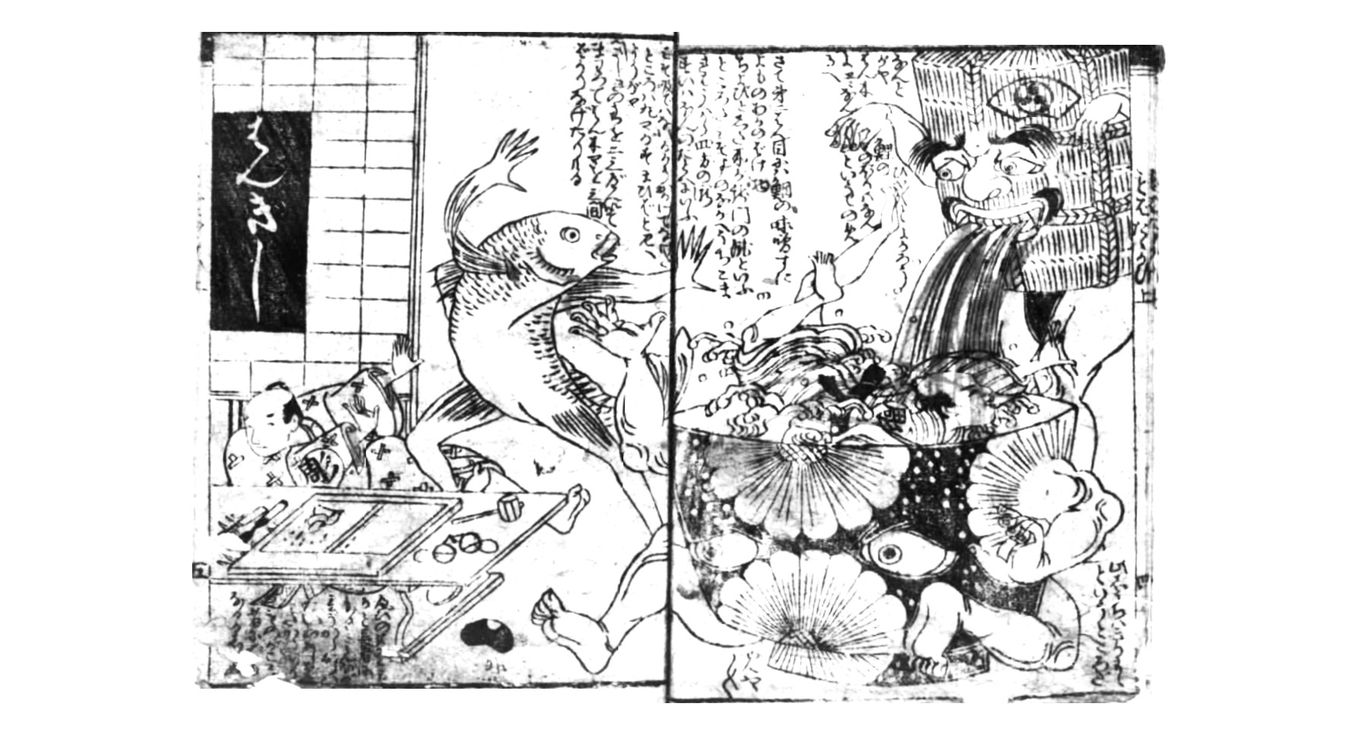
Koikawa Harumachi's New Roots of Verbal Jousting (1778), is one among other ehon that foreshadow the imagery of Lear and Grandville.
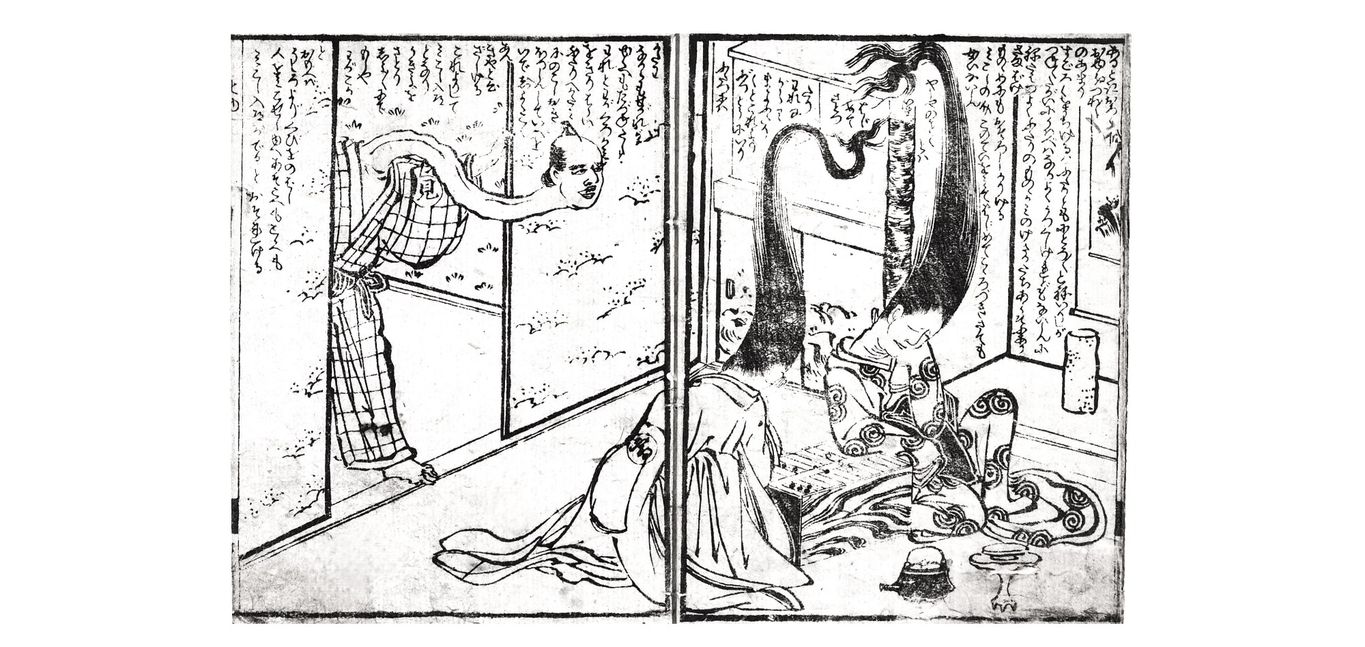
The zany Life of a Stretchy Monster (見越入道一代記), 1782, written by Iba Kasho (伊庭 可笑) and illustrated by the renown artist Torii Kiyonaga (鳥居 清長)
The flair for the sarcastic, off-the-wall, punning, and nonsensical of Japanese authors in vogue at the time can be gleaned from their book titles such as Harumachi’s The Monstrous Udon and Soba Noodles of Mt. Oe or Travelogue of Snobby Atelier (1776); or Santo Kyoden (山東京伝 1761-1816)’s Buffing Up Aoto’s Loose Coins (1790), or his Horned Words of a Dishheaded Demoness (1785), or Playboy, Roasted a la Edo (1785), among other preposterous sounding titles, to use the translations of Adam Kern in Manga from the Floating World: comicbook culture and the kibyoshi of Edo Japan (Harvard Univ. Asia Center, 2006).
Kern, however, makes no attempt to discuss the obvious similarities in cartoon and caricature imagery, as well as ideas of nonsense and humor in Western literature that were to follow these Japanese works. Rather, his assertions focus on what is lacking: e.g. how caption clouds were not used in the Edo period for expressing speech, but only used for dreams---a misconception, which may be due to his not having been exposed to a sufficient sampling of e-hon picture books and prints. This is one of the common pitfalls of both Japanese and Western researchers: to conclude that if they have seen a few hundred examples of a certain genre of Japanese art, they can categorically state what it does not possess. Indeed, the creative use of clouds in book illustrations, whether for speech, thoughts, dreams or otherwise, may be a Japanese invention, or at the very least saw the earliest wide circulation there, which, if so, has hardly been recognized by historians of the comic.
We must place ourselves in the position of those that beheld the first Japanese illustrated books that the Dutch brought over to Europe in the 18th century; not able to read the writing in the balloons/bubbles/clouds or whatever one may choose to call them, it would be natural that thought clouds would be interpreted as indicating speech, or dreams as thoughts, and by the slightest imaginative extension to use them so. In any case, extensive dialogue, freely scattered within illustration, is certainly most marked in Japan, centuries before it appears in the West.
Whether or not the world's first true animal cartoons, the Choju Jinbutsu Giga, was authored by Toba Sojo (鳥羽 僧正 1053-1140; otherwise known as Abbot Kakuyu 覚猷, son of Minamoto no Takakuni who was Uji Dainagon and a scholar) or another nobleman-priest-painter of the capital, is not of primary importance; that he did draw comic pictures, and that others coming soon after, as Jogen (成賢 1162-1231) did so too in the 12th century and thereafter, is highly significant. Toba Sojo was recognized as starting an illustrative comic tradition by succeeding generations, in unbroken continuity to the Edo period---and those works attributed to him exist---that is what is more meaningful than attribution itself.
His Kachie (勝絵 12th century) 'Winning Pictures' [of genitalia and farting contests] remains perhaps only as copies, but some are most likely very faithful copies, as that in the Mitsui Memorial Museum. It is at the latest of the 15th century, though some argue it is an original, and the method of painting is very much like that of late Heian and Kamakura period scrolls. The dozen or so extant copies, are all very similar in content, with minor variations or elaborations. Some are so meticulously copied, that even the worm holes are faithfully portrayed. Works inspired by him, such as the Hohi Gassen Emaki, 'Farting Battles Picture Scroll' (放屁合戦絵巻 1449, Suntory Museum) by Go-Sukoin (後崇光院 1372-1456, the tonsured name of the imperial prince Fushiminomiya Sadafusa Shinnō) attest to much the same.
Toba Sojo (attrib.) or early copy, Kachie Picture Scrolls, scenes from the Hohi Gassen Scroll, early 12th to early 15th cent., Mitsui Memorial Museum
In the Kokon chomonju (古今著聞集 mid-13th century), a collection of 'setsuwa' or anecdotes (from which the following passage the researcher Yano Akiko 矢野明子 has skillfully translated), Abbot Kakuyū, as a teacher of painting, admonishes a pupil’s exaggerated depiction of a fight, to which the pupil retorts:
"No, that’s not right. Look at those erotic paintings (osokuzu no e おそくづの絵) made by old masters. They depict the size of 'the thing' (sono mono その物) far too large. How could it actually be like that? If it were depicted in its actual size, there would be nothing of interest. For that very reason, don’t we say 'art is fantasy' (e-soragoto 絵そら ごと)? This kind of representation is in fact often found in your work, isn’t it, Master?" (Yano, 2013:60).
Thus even dialogues between artists, concerning painting theory and technique existed in Japan centuries before Giorgio Vasari, and furthermore, not only on 'serious' painting, but regarding humorous, comic depictions done by artists before their time. The Japanese cartoon/comic tradition has indeed a lengthy history with abundant material sources. And as to what was the spark that brought about the illustrative comic genre in the West---what could serve as the prototype in so many respects--- surely that must be weighed and investigated in relation to Japan, but is almost never done.
Conclusion: Time to Open the Floodgates
It has been customary even among recent scholars to restrict the age of japonisme into a comfortable box of chronology, lasting some four decades or so, starting in the second half of the 19th century and often ending before the 20th. This being the case despite the obvious continuation of the Japan craze, perhaps with even greater strength, in the first decades of the 20th century, and though much more quietly, in the first half of the 19th, as we have seen here.
At the same time, there is a common lack of comprehension as to the true magnitude of artistry in Japan at the time, and the social sophistication required to produce it. That is, without always consciously realizing it, to regard the phenomenon of japonisme as caused, not by any outstanding richness of artistic resources (or push force genius, if you will); but instead as a credit to those who cleverly utilized it (pull force genius);---as if it were simply another strain in a series of 'orientalisms'. This implicit bias has skewed logical thinking, misguiding scholars at times to accept a single anecdotal story at face value as proof of social reality, while ignoring more substantial information if it steps outside the mental box in which supposedly japonisme is contained within.
Take for example, the tirelessly repeated tale, which has attained almost mythic proportions, of Félix Bracquemond’s ‘discovery’ of Japanese prints as packing material for Japanese porcelains. It seems to play to the ego of certain scholars, who relish hinting that the inhabitants of the land of the print’s origin had no appreciation for their own art, that indeed, once again, all aesthetic merit goes to their own kind. A story which, as Deborah Johnson notes, though seemingly credible at first glance due to the stereotypical conception of Japan being a completely closed country, is to be questioned in light of the prices of Hokusai's works at the time, and the fact that such exports were regulated by the Japanese government; and in any case, that it was no discovery at all, since Japanese prints had always been available for viewing in various libraries and museums in Europe as discussed at length above. Furthermore, it seems the story has been modified by authors of the more commonly read historical surveys of Impressionism: they would have us believe it was used as wrapping paper; instead, it seems that a thin volume was placed inside the package, not a crumpled print (Martin Eidelberg, ' Bracquemond, Delâtre and the Discovery of Japanese Prints', The Burlington Magazine, Apr. 1981, Vol. 123, No. 937). For all one knows, it may have been included as a generous, secret gift (known as an ‘omake’) as is sometimes the mercantile practice in Japan---a gesture perhaps, beyond the appreciative ken of those who received it.
Or for instance, take the case of Carl Hubert de Villeneuve (1800-1874), who came to Japan as an assistant to Siebold in 1825 (leaving in 1836). His influence upon Kawahara Keiga is without exception raised by Japanese and Dutch scholars alike; on the other hand, there is a contrasting silence, a complete absence of curiosity as to how a talented artist like Keiga, as well as other Japanese art works available in Japan, might have influenced the younger Villenueuve---or for that matter, the multitude of other Dutch and German residents of Deshima after they returned to Europe, to live out the majority of their years.
Movements such as chinoiserie, japonaiserie, and japonisme, as broad social phenomenon, tend to arise in times of political and economic stability. Revolution, war, and the like, draw the attention of the general populace towards more pressing matters. But this does not mean foreign artistic influences cease among artists themselves; simply that due to the change in social climate and artistic ideals, things of exotic origin are perhaps not as openly touted nor greeted with fanfare in expositions.
The ‘Intermediate Period’ may have been one of continued and steady, if not publicized Far Eastern artistic influence throughout Western Europe. It could have been just as important, if not more so, than in the early 18th century era of chinoiserie and japonaiserie. Looking at things from this perspective, the japonisme of the latter 19th century may be considered a climax, the culmination of a long process at work for almost four centuries since the ‘first opening’ of Japan to the West in the mid-16th century.
The absorption by Japan of continental influences from the 'East' (Chinese and Korean) and from the 'West' (both European and American) have been documented in great detail, and furthermore is a fact understood in its broad outlines around the world. The reverse, that is Japan's influence, in the late 18th and early 19th centuries, not only upon modern art and science, but also in small, everyday conveniences that constitute our modern daily lives---from toothpaste (薬歯磨) to portable tissue paper (懐紙) and toilet paper (落とし紙), to rack-fitted compartementalized backpacks (笈) and folding umbrellas (bangasa 番傘 deriving from folding Osaka 聾傘 / 大黒傘 and folding Kyoto 壺屋傘); or pastimes, from multiplayer board games (絵双六) and the revival in the West of backgammon (盤双六), to (though it may be hard to believe) even the child's play of making snowmen (雪達磨), just to raise a few examples---remains fundamentally an uncharted territory of knowledge, still waiting to be explored.
It is time to open the floodgates of knowlege. The letters, memoirs, personal momentos, and lesser publicized works in difficult to access archives of European artists need to be re-examined. The Japanese treasures kept under lock and key in major European museums, as well as in the national museums of Japan, must be brought out, displayed, and their images published more openly for the public that deserves to know the modern world's precious heritage.

Caspar David Friedrich 'Morning Mist in the Mountains' 1808
Select Bibliography
Under construction
Armand, Robin. Traité des peintures application procédés employés sur bois, sur étoffes, sur papier, orné de 30 planches pour en facilite le travail; Revu, corrigé et augmenté par Armand Robin, Editeur de lithographies. Deuxième édition. Paris: Chez l'auteur (published by the author), 1834.
Borsch-Supan, Helmut. Caspar David Friedrich. Munich: Prestel Verlag, 1990.
(van) Campen, Jan. ‘A Chinese Collection in The Netherlands - art collection of Jean Theodore Royer' Magazine Antiques, Sept, 2000.
___________________. Collecting China: Jean Theodore Royer (1737-1807), collections and Chinese studies. Hilversum: Verloren, 2021.
Edo-Tokyo Museum and Peabody Essex Museum (eds.). Worlds Revealed: The Dawn of Japanese and American Exchange (日米交流のあけぼのーー黒船きたる). Tokyo: Edo-Tokyo Museum, 1999.
Floyd, Phylis. 'Documentary Evidence for the Availability of Japanese Imagery in Europe in Nineteenth-Century Collections'. The Art Bulletin, March 1986, vol. 68, no. 1, pp. 105-141.
Gildon, J. A Japanese Air. (musical score) Arranged as a Rondo, or Easy Lesson, for the Piano Forte. London: Printed by J & G. Balls, c.1815.
(van) Gulik, Wilhem R. 'Brief History of the National Museum of Ethnology' in Von Siebold and Japan. Tokyo National Museum, et al., eds. Tokyo: Tokyo National Museum, et al., 1988.
Hirayama, Hina. "A True Japanese Taste"; Construction of Knowledge about Japan in Boston, 1880-1900. PhD Thesis, Boston Univ., 1999.
Johnson, Deborah J. 'Japanese Prints in Europe before 1840'. The Burlington Magazine, June 1982, vol. 124, no. 951, pp. 343-348.
Karttunen, Klaus. 'Persons of Indian Studies' based on his 'Who was Who in Indian Studies'. At https://whowaswho-indology.info. Visited 2024 April.
Keblusek, Marika. Japansch Magazijn: Japanse kunst en cultuur in 19de-eeuws Den Haag. Leiden: Hotei Publishing and Haags Historisch Museum, 2000.
Kern, Adam L. Manga from the Floating World: comicbook culture and the kibyoshi of Edo Japan. Cambridge MA: Harvard University Asia Center, 2006.
Kitson, Peter. Forging Romantic China: Sino-British Cultural Exchange, 1760-1840. Cambridge: Cambridge Univ. Press, 2013.
Kobayashi Taichiro (小林太市郎). ‘Oshu kaiga ni okeru nihon eikyo no tansho' I~V 欧洲絵画に於ける日本影響の端緒 Kokka 国華 Oct. 1938, no. 575; II Nov. 1938, no. 576; III Jan. 1939, no. 578; IV March 1939, no. 580; V July 1939, no. 584.
________________________________. ‘Oshu kaiga ni okeru Nihon eikyo no tansho' (欧洲絵画に於ける日本影響の端緒) in Kobayashi Taichirō Chosaku-shū 2 小林太市郎著作集 2. Toyo to Seiyo hen I (東洋と西洋篇 I ) Tokyo: Tankosha, 1974.
________________________________. ‘Nihonbijutsu oushu shinshutsu no tanshoto Flaubert' (日本美術欧州進出の端緒とフローベル). Bijutsujidai (美術時代), 1939, vol. 2, no. 2.
Koike Masatane (小池正胤). Muda to Ugachi no Edo Ehon---Kibyoshi Meisaku-sen 「むだ」と「うがち」の江戸絵本-黄表紙名作選. Tokyo: Sasama Shoin, 2011.
Koike Masatane (小池正胤), Uda Toshihiko, Nakayama Yusho, Tanahashi Masahiro. Edo no Gisaku Ehon (江戸の戯作絵本). Tokyo': Shakaishiso, 1980.
Kreiner, Josef (chief ed.). 200 Jahre Siebold die Japansammlungen Philipp Franz und Heinrich von Siebold シーボルト父子のみた日本:誕生200年記念 . Tokyo: Deutsches Institut für japanstudien, et. al., 1996.
Lauts, Gerard. Japan in zijne staatkundige en burgerlijke inrigtingen en het verkeer met europescëhe natiën. (Japan in its political and civil institutions and relations with European nations) Amsterdam: G. J. A. Beijerinck, 1847.
Marquet, Christophe. 'Les collections de livres japonais anciens en France : leur histoire et leur redécouverte' フランスの和古書コレクション—各所での調査と発見 in Recherches croisées sur l’histoire du livre en France et au Japon. Publication à l’occasion du cinquantenaire de la Société franco-japonaise des bibliothécaires et des documentalistes 書物史研究の日仏交流—日仏図書館情報学会創立50周年記念出版. Tokyo: Jusonbo, 2021.
Meylan, G.F. Japan. Voorgesteld in schetsen over de zeden en gebruiken van dat ryk, byzonder over de Ingezetenen der stad Nagasaky. Amsterdam: M. Westerman & Zoon, 1830.
Mighels, Ella Sterling and the Japanese Village Company. A Veritable Japanese Village Under the Sanction of the Imperial Japanese Government; a Colony of Japanese Men, Women and Children in Native Costume who Daily Illustrate the Art Industries of Japan. Boston: J.B. Rose & Co., 1886.
Nofuji Tae (野藤妙). ‘The Kawahara Keiga Animal, Plant, and Genre Paintings in Siebold’s Collection’, Panel 3, ‘Proceedings of the International Symposium Siebold’s Vision of Japan As Seen in Japan-related Collections in the West’ Feb. 11–12, 2014, Ruhr University Bochum, at www.reihaku.ac.jp.
Peat, Rachel, ed. Japan: Courts and Cultures. London: Royal Collection Trust, 2020.
Perry, Marvin, et. al. Western Civilization: Ideas, Politics & Society, Fourth Edition, Volume II. Boston: Houghton Mifflin Company, 1992.
Powerhouse Collection. 'Mens dressing gown possibly worn by King George IV'. 1800-1830. Object no. 2012/132/1. At http://collection.powerhouse.com.au/object/450836.
Sakamaki, Shunzo. 'Western Concepts of Japan and the Japanese, 1800-1854'. Pacific Historical Review Vol.6, No. 1 (Mar., 1937) pp. 1-14. University of California Press.
__________________. Japan and the United States, 1790-1853. Transactions of the Asiatic Society, Vol. XVIII. Tokyo, 1939.
Schwartz, William Leonard. The Imaginative Interpretation of The Far East in Modern French Literature 1800-1925. Paris: Librairie Ancienne Honore Champion, 1927.
Shimizu Isao (清水勲). Nihon no Manga (日本のまんが). Tokyo: Bungeishunju, 1981.
Sullivan, Michael. The Meeting of Eastern and Western Art From the Sixteenth Century to the Present Day. London: Thames and Hudson, 1973.
Sze, Mai-Mai (ed. and transl.). The Mustard Seed Garden Manual of Painting, Chieh Tzu Yuan Hua Chuan, 1679-1701. A facsimile of the 1887-1888 Shanghai edition with the text translated from the Chinese and edited by Mai-Mai Sze. Princeton: Princeton Univ. Press, 1963.
Taylor, Isaac. Scenes in Asia for the Amusement & Instruction of Little Tarry-at-home Travellers. London: Printed for John Harris, 1819.
Titsingh, Isaac. Illustrations of Japan; Consisting of private memoirs and anecdotes of the reigning dynasty of the djogouns, or sovereigns of Japan; a description of the feasts and ceremonies observed throughout the year at their court, and of the ceremonies customary at marriages and funerals... Translated from the French by Frederic Shoberl. London: Printed for R. Ackermann, 1822.
Von Siebold and Japan. Exhibition catalogue organized and published by the Tokyo and Kyoto National Museums, Nagoya City Museum, Asahi Shinbun, and the National Museum of Ethnology, Leiden, 1988.
Yano Akiko (矢野明子). 'Historiography of the “Phallic Contest” Handscroll in Japanese Art'. Japan Review 26 Special Issue Shunga (2013) pp. 59–82.
